

Abelisaurus (“[Roberto] Abel’s lizard”) was one of the top predators in South America at the end of the Age of Dinosaurs. While Tyrannosaurus and its kin dominated the northern continents during the Late Cretaceous, the abelisaurs ruled South America, India, and Madagascar.
Like the tyrannosaurs, abelisaurs had big skulls with knobby snouts. Unlike the tyrannosaurs, however, abelisaurs had teeth that were fairly small. The rounded snout of Abelisaurus and its relatives probably helped it to hold on to what it was biting. Its fused skull roof made its head hard enough to be used as a weapon in fights between rival abelisaurs. By pushing each other with their heads, one Abelisaurus could try to defeat the other without having to face attack by claws or jaws.
Abelisaurus is known at present only from a single giant skull, over 33 inches (85 cm) long.
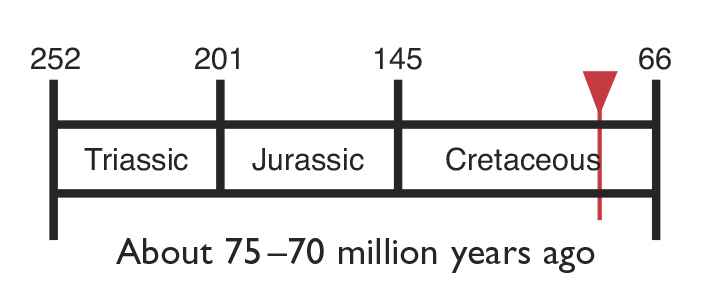

FUN FACTS: Possible relatives of Abelisaurus are known from Spain and France.
LOCATION: Rio Negro Province, Argentina
FOOD: Other dinosaurs (titanosaurs, hadrosaurs, and small ornithopods)
SIZE: Perhaps about 26 feet (7.9 m) long, perhaps 6.6 feet (2 m) high at the hips
WEIGHT: About 1.4 tons
FRIENDS: None
ENEMIES: Aucasaurus
TRIVIA: More species of fossil dinosaurs have been found in Argentina than any other country in the Southern Hemisphere.




Allosaurus (“other lizard”) was the most common predator of the Late Jurassic and probably one of the most dangerous. Like most meat-eating dinosaurs, its jaws were filled with serrated teeth shaped like blades. Computer studies suggest that Allosaurus attacked by using its upper jaw like a battle ax to hack at its victim, then it used its lower jaw to bite out a slice of meat.
It might have been easy for an Allosaurus to kill a fairly defenseless dinosaur like Camptosaurus, but Stegosaurus could certainly put up a fight, and the sauropods (giant long-necks) were so huge that they could easily crush even an adult Allosaurus.
We know that Allosaurus led a dangerous life. The Allosaurus on display at the Smithsonian Institution has a smashed shoulder blade, many broken ribs, and a lower jaw so damaged that paleontologists didn’t realize it was an Allosaurus jaw for over 100 years! But these were tough dinosaurs: Their bones show that they lived long enough for their wounds to heal.
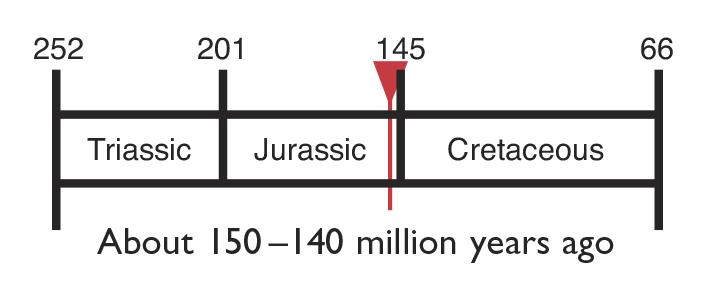

FUN FACTS: The first fossil of Allosaurus ever found—the broken half of a backbone—was called a petrified horse hoof by its discoverers!
LOCATION: Montana, Wyoming, Colorado, New Mexico, Oklahoma, Utah, South Dakota, Portugal
FOOD: Other dinosaurs
SIZE: 40 feet (12 m) long, about 10 feet (3 m) high at the hips
WEIGHT: About 4.5 tons
FRIENDS: None
ENEMIES: Stegosaurus, Torvosaurus, Saurophaganax, Ceratosaurus
TRIVIA: Allosaurus is the official state dinosaur of Utah.
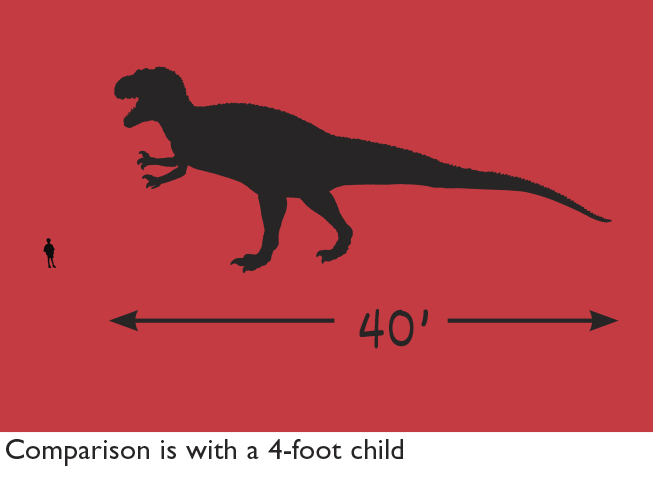

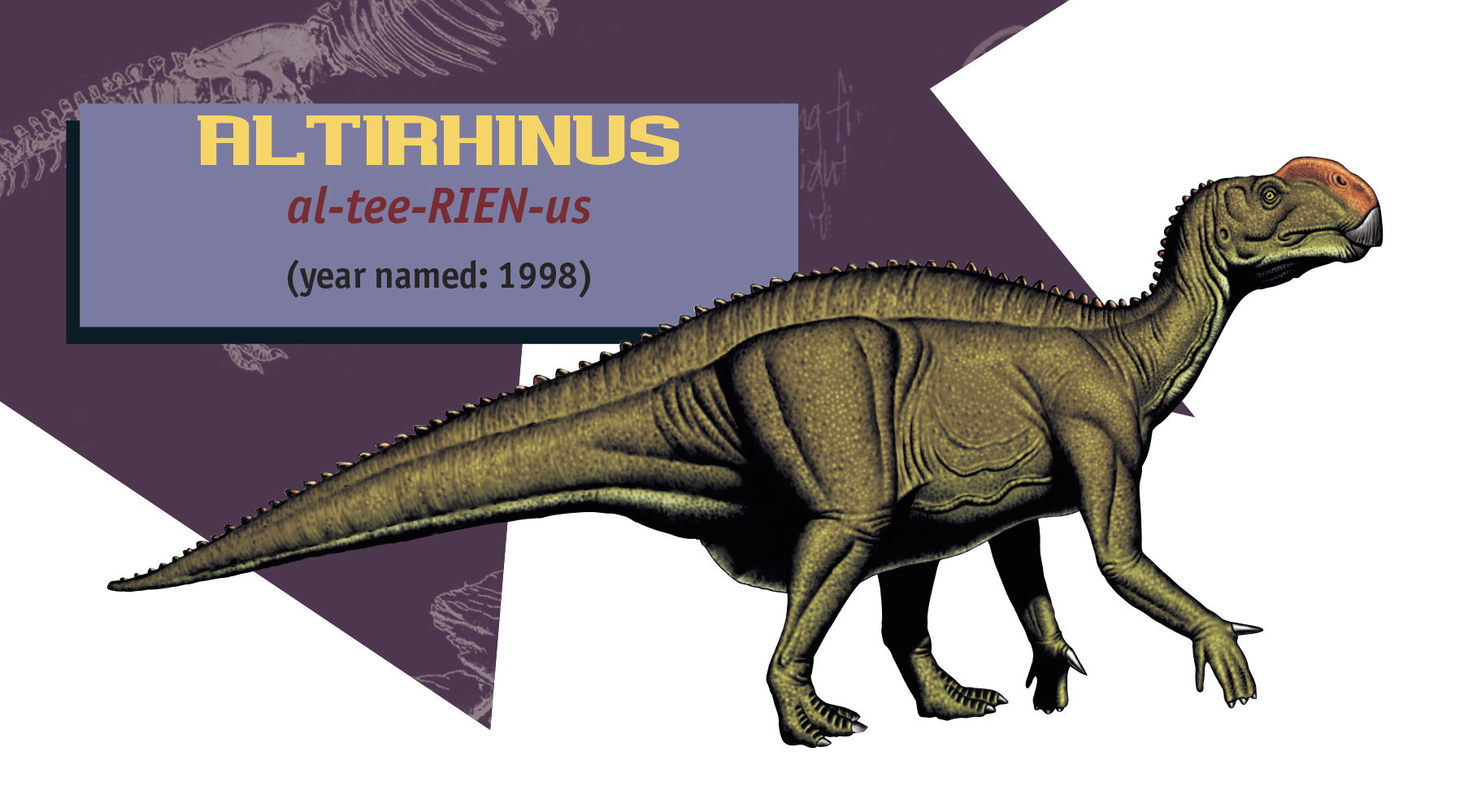

Altirhinus (“high nose”) had an enlarged beak and mouth to help it eat tough plants. This expanded nose may also have improved Altirhinus’s sense of smell and helped it recognize the same species during mating season. (Among the Altirhinus, a big nose was considered very attractive!)
Altirhinus is referred to as being “more than an Iguanodon, but less than a hadrosaur” because the body is like Iguanodon’s, but the skull is closer to that of the duckbills. In fact, Altirhinus is a good example of how difficult it sometimes is to classify finds. For years, this dinosaur was known as Iguanodon orientalis. Named by a Russian scientist in 1952, Iguanodon orientalis—which was found in Mongolia—was thought to be in the same genus as the original Iguanodon, which was found in Britain. Although the bodies of the two are similar, the skulls are very different. It was not until 1998 that David Norman, an authority on the family Iguanodontidae, revised the taxonomy of Iguanodon and finally gave I. orientalis its new name—Altirhinus kurzanovi.
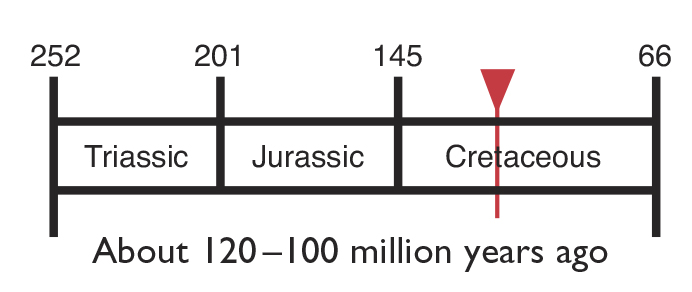

FUN FACTS: With its expanded nose, Altirhinus may have been the first dinosaur to “hoot” like a woodwind instrument.
LOCATION Mongolia
FOOD: Possibly early flowering plants, cycads, and ginkgos
SIZE: 24 feet (8 m) long, 6.6 feet (2 m) high at the hips
WEIGHT: 4 tons
FRIENDS: Psittacosaurus
TRIVIA: The original Altirhinus skull (minus the body) went on a world tour in the late 1990s.


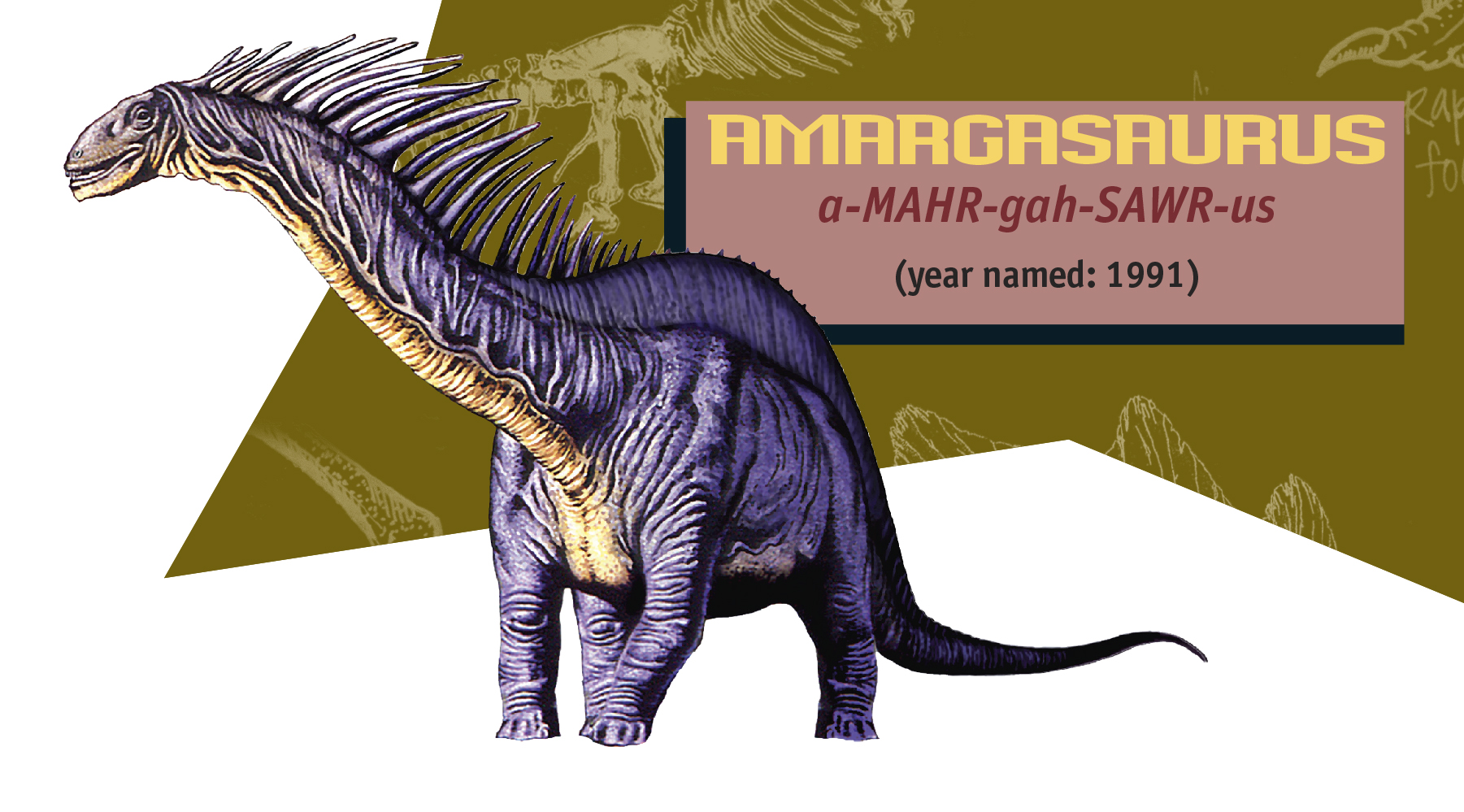

Amargasaurus (“lizard from La Amarga [geologic formation]”) is one of the most unusual sauropods known to science. Its most distinguishing feature is the tall double row of spines, like two sails, coming out of the back of its neck. These sails served many functions—at a price. They made the dinosaur look much bigger than it was, possibly keeping predators away. The sails could also be used—under certain conditions—like a solar panel, gathering heat when facing into the sun and losing heat when in the shade. Unfortunately, the sails were also very restrictive and would severely limit the range of motion in Amargasaurus’s head and neck. They were also very fragile and would get seriously damaged if bitten.
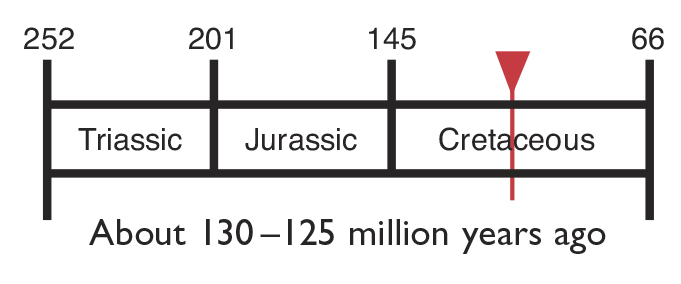

FUN FACTS: Some Amargasaurus neck spines are 19.6 inches (50 cm) long.
LOCATION: Patagonia, Argentina
FOOD: Conifers, cycads, ginkgos
SIZE: 30 feet (9 m) long, 8 feet (2.5 m) high at the hip
WEIGHT: 15 tons
TRIVIA: The first mounted skeleton in the world is in Buenos Aires, Argentina.
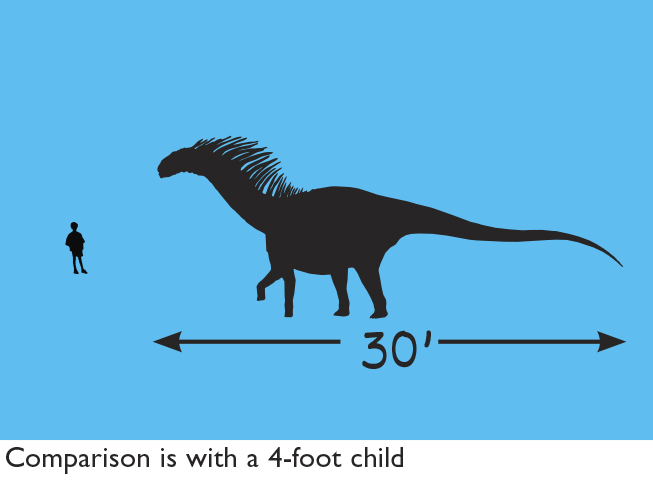



Ankylosaurus (“fused lizard”) is the name-bearer for the group of dinosaurs known as the Ankylosauria, or “tank dinosaurs.” They’re called “tanks” because the upper parts of their bodies are covered with various types of armor that are fused together.
The armor of ankylosaurs can be either solid or hollow. It is found on top of their bodies and tails, and also all around the skull—imagine putting on a football helmet and having your skin grow over it! This extreme level of defense was necessary because no ankylosaur could outrun a theropod, or meat-eating dinosaur. In 1998, another new species of ankylosaur was named. It was called Animantarx (“living fortress”).
In Ankylosaurus, the last half of the tail has been modified into a giant war club, with the last tail bones fused together. When this club was swung from side to side, it was at the same level as the knees of theropods like Tyrannosaurus. How’s that for strategically placed weaponry!
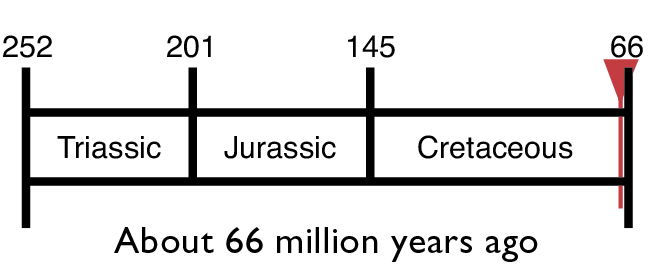

FUN FACTS: Ankylosaurus had eight sinus cavities, as compared to only four in nodosaurs (and also in humans).
LOCATION: Montana; Wyoming; Alberta, Canada
FOOD: Flowering plants like magnolias, possibly small insects
SIZE: 25 feet (7.5 m) long, 4 feet (1.2 m) high at the hips
WEIGHT: 3 tons
TRIVIA: Ankylosaurus was the last of the Thyreophora (“shield-bearers,” a group that includes the ankylosaurs and stegosaurs). The earliest was Scutellosaurus.


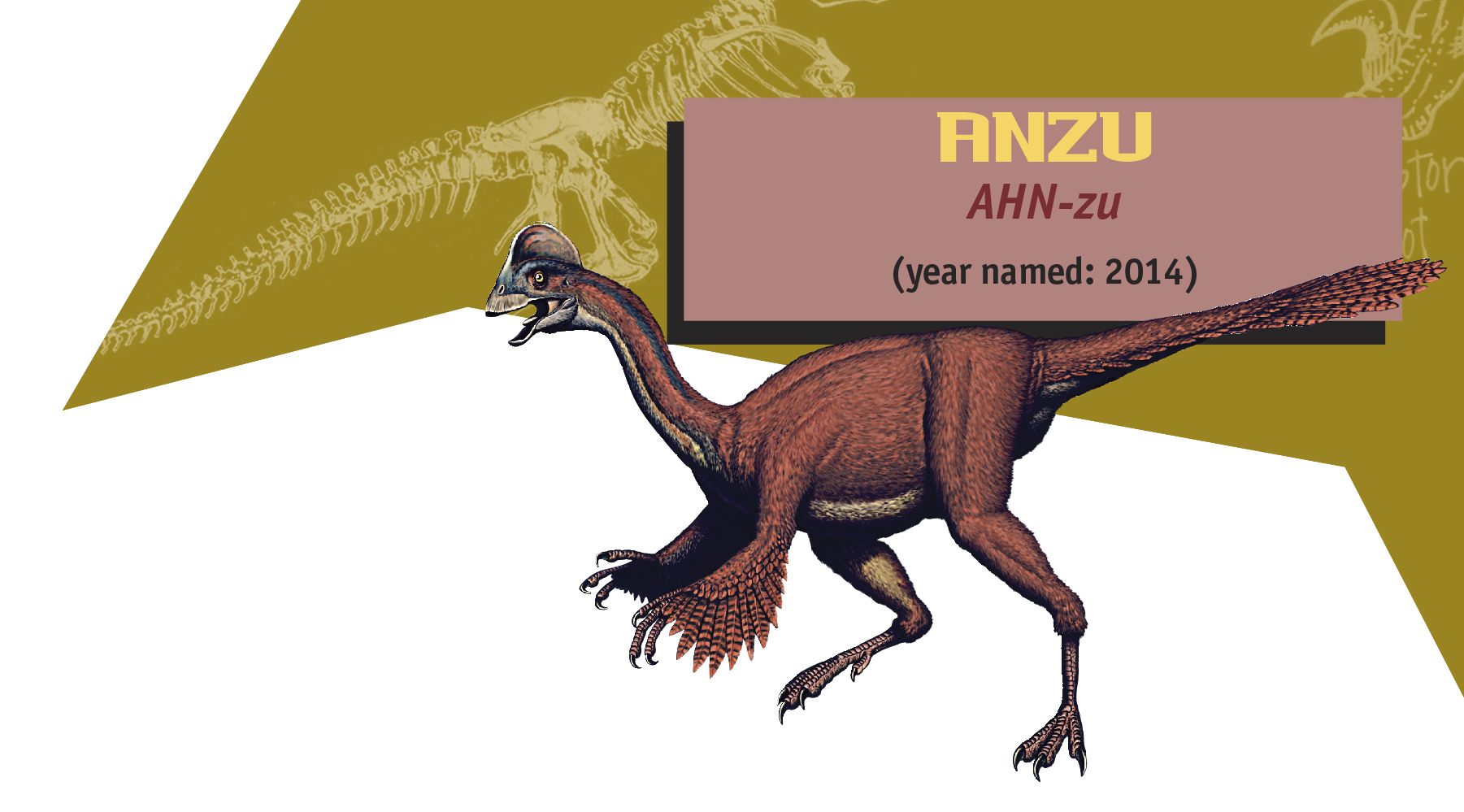

Anzu (named after a feathered demon of Mesopotamian mythology) is one of the bird-like oviraptorosaurs (egg thief reptiles), the same group that Caudipteryx belongs to. Its jaws had no teeth. Instead, Anzu had a horny beak, like a bird or turtle.
Figuring out the diet of oviraptorosaurs is difficult. Were they meat-eaters, plant-eaters, or a little bit of both? Study of the function of the jaws of Anzu and its relatives suggest that it mostly ate plants, but maybe did gulp down eggs, mammals, amphibians, baby dinosaurs, and other small animals as well.
Many oviraptorosaurs had tall crests on their heads, and Anzu is no exception. These crests may have been used to show off to mates or rivals.
Although Anzu was named in 2014, fossils of it have been studied since 1999. A skeleton is on display at the Carnegie Museum of Natural History in Pittsburgh, Pennsylvania.


FUN FACTS: Anzu lived alongside Triceratops and Tyrannosaurus.
LOCATION: Montana, North Dakota, South Dakota, Saskatchewan
FOOD: Possibly small reptiles and mammals, plants, eggs, insects
SIZE: 11 ft (3.5 m) long, about 4.9 ft (1.5 m) high at the hips
WEIGHT: About 660 lbs (300 kg)
TRIVIA: Anzu is the biggest oviraptorosaur known from North America, but its Chinese cousin Gigantoraptor was about as big as Gorgosaurus.




Apatosaurus (“deceptive lizard”) looks very much like Diplodocus, its closest relative. On the inside, however, it is very different. Apatosaurus is very massive, with thick bones and a stocky body. Diplodocus is slender, with thinner bones. Apatosaurus was one of the very first dinosaurs to have a picture of its completely restored skeleton published in newspapers. This happened in the 1880s, and the dinosaur’s immense size made world headlines.
One feature that Apatosaurus has in common with other closely related sauropods, or giant plant-eaters, is that the openings in the skull for the nasal passages are on top of its head, behind its eyes. (Normally these openings are located at the end of the snout, as in the Ornithischia, the other major group of plant-eating dinosaurs.) Paleontologists once thought this meant the actual nostrils were right on top of the head, too. But studies of the details of the front of the skull show that like most animals (including cats and dogs and you and me) the nostrils were on the front of the face. This way it was easier for Apatosaurus to sniff its food before eating it.
The study of Apatosaurus has had a major influence on the study of all dinosaurs. In the 1970s, a study of its skeleton was used to show how sauropods lived on land, and not in the water as had been assumed for many decades. In 1979, it was learned that the wrong head had been mounted on every Apatosaurus skeleton in museums since the 1880s (the older mounts had heads based on Camarasaurus). In the 1990s, a study of Apatosaurus bones showed that its head and neck were not held vertically as had been portrayed in many illustrations. The science of how a body can or cannot function is called functional morphology, and Apatosaurus is one of the best dinosaurs for use in this study because of its large size.
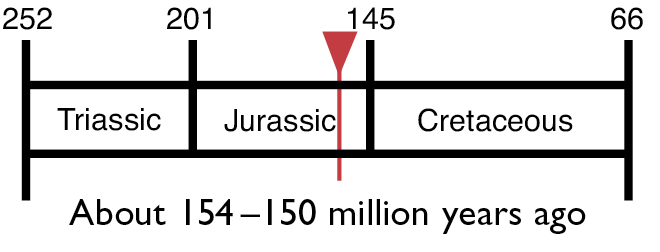

FUN FACTS: One species of Apatosaurus was named after a millionaire’s wife in the hope it would bring more funding!
LOCATION: From Oklahoma to Canada along the Rocky Mountains
FOOD: Cycads, ginkgos, ferns, conifers
SIZE: About 70 feet (21 m) long, 10 feet (3 m) high at the hips
WEIGHT: 25 tons
FRIENDS: Diplodocus, Camarasaurus
ENEMIES: Allosaurus, Ceratosaurus, Torvosaurus
TRIVIA: Apatosaurus was once considered to be a different animal from the sauropod called Brontosaurus. Now we know they are the same dinosaur.




Archaeoceratops (“ancient horned-face lizard”) had powerful jaws and a beak that came to a narrow point. With such a narrow bite, it had to be very picky about what it ate. It probably fed on very specific plants, or certain parts of one plant. A powerful bite is needed to snip off the hard parts of plants, like bark and wooden branches. It is also very helpful for defensive purposes.
Archaeoceratops is an early horned dinosaur, but not the earliest. In 2006, a much earlier relative named Yinlong was described. It was from 160 million years ago, in the Jurassic Period. It shows that primitive members of the horned dinosaur group were around for a very long time.
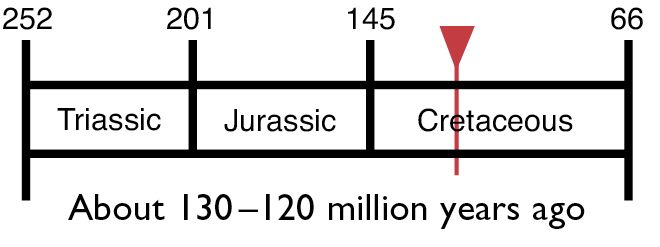

FUN FACTS: This small dinosaur might have been able to outrun a teacher. (How fast can your teacher run?)
LOCATION: Gansu Province, China
FOOD: Plants
SIZE: About 2.5 feet (72 cm) long, 1.25 feet (35 cm) high at the hips
WEIGHT: 50 lbs
FRIENDS: Other ceratopsians and small ankylosaurs
ENEMIES: Juveniles of any theropods, or meat-eating dinosaurs
TRIVIA: Even though Archaeoceratops’s skull was the same size as a dog’s, it had much more powerful jaws.




Archaeopteryx (“ancient wing”) is one of the oldest and most primitive known birds. It is also one of the most important fossils ever found.
Archaeopteryx shows a mixture of features found in birds (like a wishbone, feathers, and backward-facing pubis bone in the hips), as well as features found in primitive reptiles but lost in modern birds (like teeth, clawed fingers, and a long, bony tail). As more dinosaur skeletons were found (especially those of smaller meat-eaters), paleontologists began to notice that they shared many of the same features with the much smaller Archaeopteryx. These features included wishbones, feathers, and a backward-facing pubis bone. Scientists figured out that Archaeopteryx and other birds are the descendants of small meat-eating dinosaurs, and in fact (using the modern system of classification), birds are a type of dinosaur themselves!
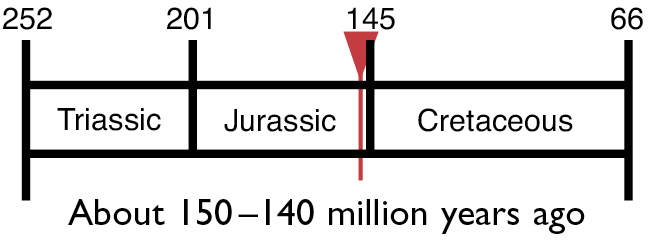

FUN FACTS: The shape of the feathers on Archaeopteryx’s wings show that it was capable of flying, but probably not well.
LOCATION: Germany, possibly Portugal
FOOD: Small mammals and reptiles
SIZE: Almost 20 inches (50 cm) long, 7.5 inches (19 cm) high at the hips, wingspan about 2 feet (61 cm)
WEIGHT: Possibly 14 ounces (400 g)
TRIVIA: All known skeletons of this early bird were found in rocks formed from soft limy mud. It was this very fine mud that preserved the impressions of their feathers. If Archaeopteryx had been preserved in another environment, we might never have known it had feathers!
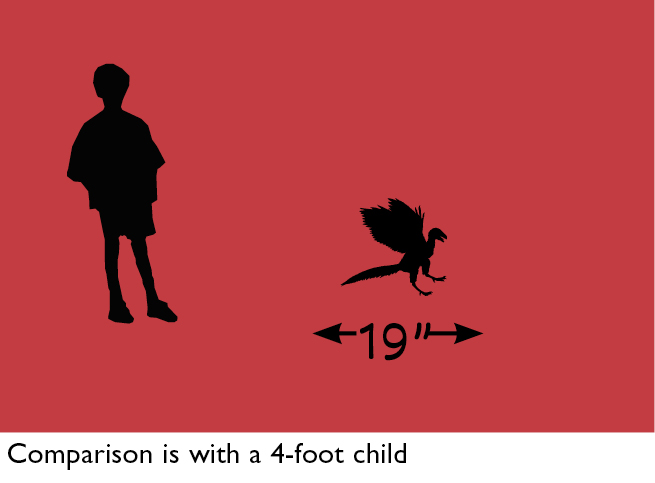



Baryonyx (“heavy claw”) was discovered by an amateur fossil hunter, William J. Walker, who came across its enormous thumb claw in a clay pit in Surrey, England. Further digging by paleontologists revealed one of the largest meat-eating dinosaurs ever found in Great Britain.
Baryonyx is a spinosaur, a member of the same group as the northern African dinosaurs Spinosaurus and Suchomimus. Baryonyx was smaller than these relatives but was still a big predator. It had a long, narrow snout filled with teeth that were cone-shaped—a real difference from the blade-shaped teeth of typical meat-eating dinosaurs.
Because of the shape of its snout and teeth (both of which are similar to those of modern crocodiles and alligators), some paleontologists think that Baryonyx ate lots of fish. Others, however, think that it ate other dinosaurs. In fact, both ideas are supported by the original Baryonyx specimen from Surrey. In the guts of this dinosaur, paleontologists found the partially digested scales of large fish as well as the partially digested bones of a young Iguanodon. This strongly supports the idea that Baryonyx ate both fish and dinosaurs!
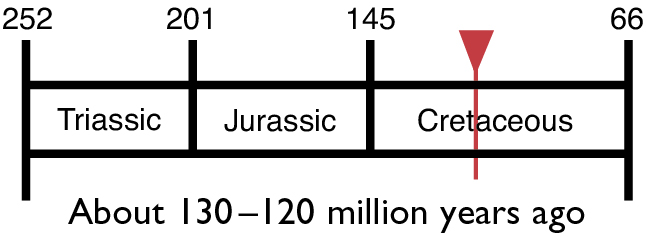

FUN FACTS: Baryonyx was given the nickname “Claws” because of its giant thumb claw.
LOCATION: Surrey, England
FOOD: Other dinosaurs (including Iguanodon) and fish
SIZE: 33 feet (10 m) long, 8 feet (2.5 m) high at the hips
WEIGHT: 1.7 tons
FRIENDS: None
ENEMIES: Neovenator
TRIVIA: Baryonyx was the first spinosaur known from a northern continent.
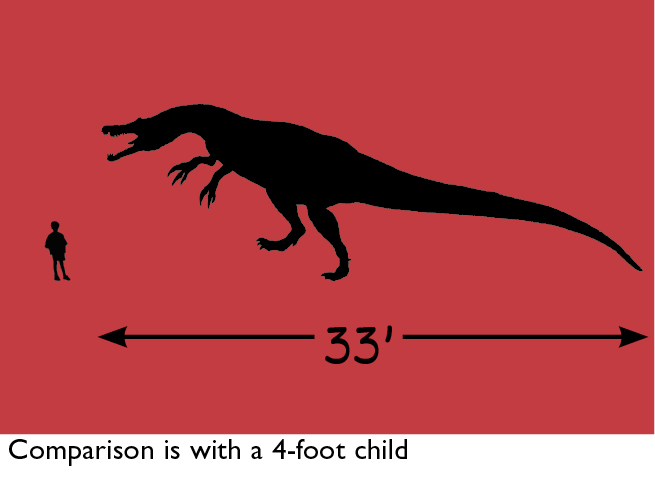

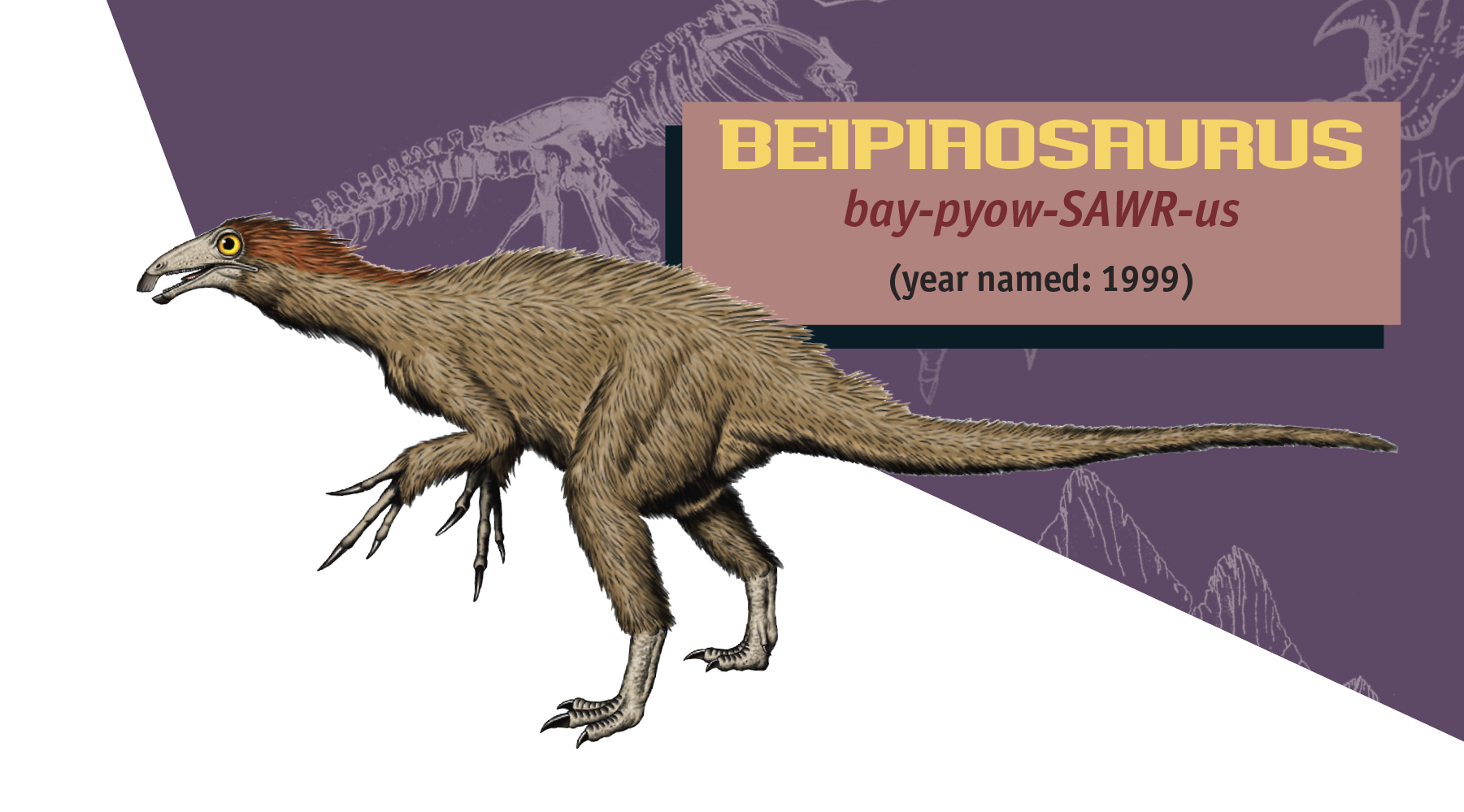

Beipiaosaurus (“Beipiao lizard”) is one of the therizinosaurs, a very strange group of theropods. Therizinosaurs (also known as “sloth dinosaurs”) have very short, heavy feet, wide bellies, long necks, big claws, and small heads at the end of long necks. Their teeth are leaf-shaped, like those of plant-eating dinosaurs, which makes them plant-eating members of a family of meat-eating dinosaurs!
Beipiaosaurus is known from one partial skeleton from the Yixian Formation in northeastern China. The volcanic ash that formed the mud of this formation was so fine-grained that it preserved very small details of the animals buried in it.
Fossils show that Beipiaosaurus ’s body was covered with long, slender filaments. These filaments were a sort of protofeather, a body cover that eventually evolved into true feathers in birds and some other dinosaurs (such as Caudipteryx). The protofeathers of Beipiaosaurus might have been used for insulation or for display, or both.


FUN FACTS: Beipiaosaurus is the smallest known therizinosaur. Its giant relative Therizinosaurus was almost as big as T. rex and had claws almost 3 feet (90 cm) long!
LOCATION: Liaoning Province, China
FOOD: Conifers, cycads, ginkgos, the earliest flowering plants
SIZE: 7.3 feet (2.2 m) long, just under 3 feet (0.88 m) high at the hips
WEIGHT: Perhaps 187 lbs (85 kg)
TRIVIA: Beipiaosaurus is the first therizinosaur known to have protofeathers.


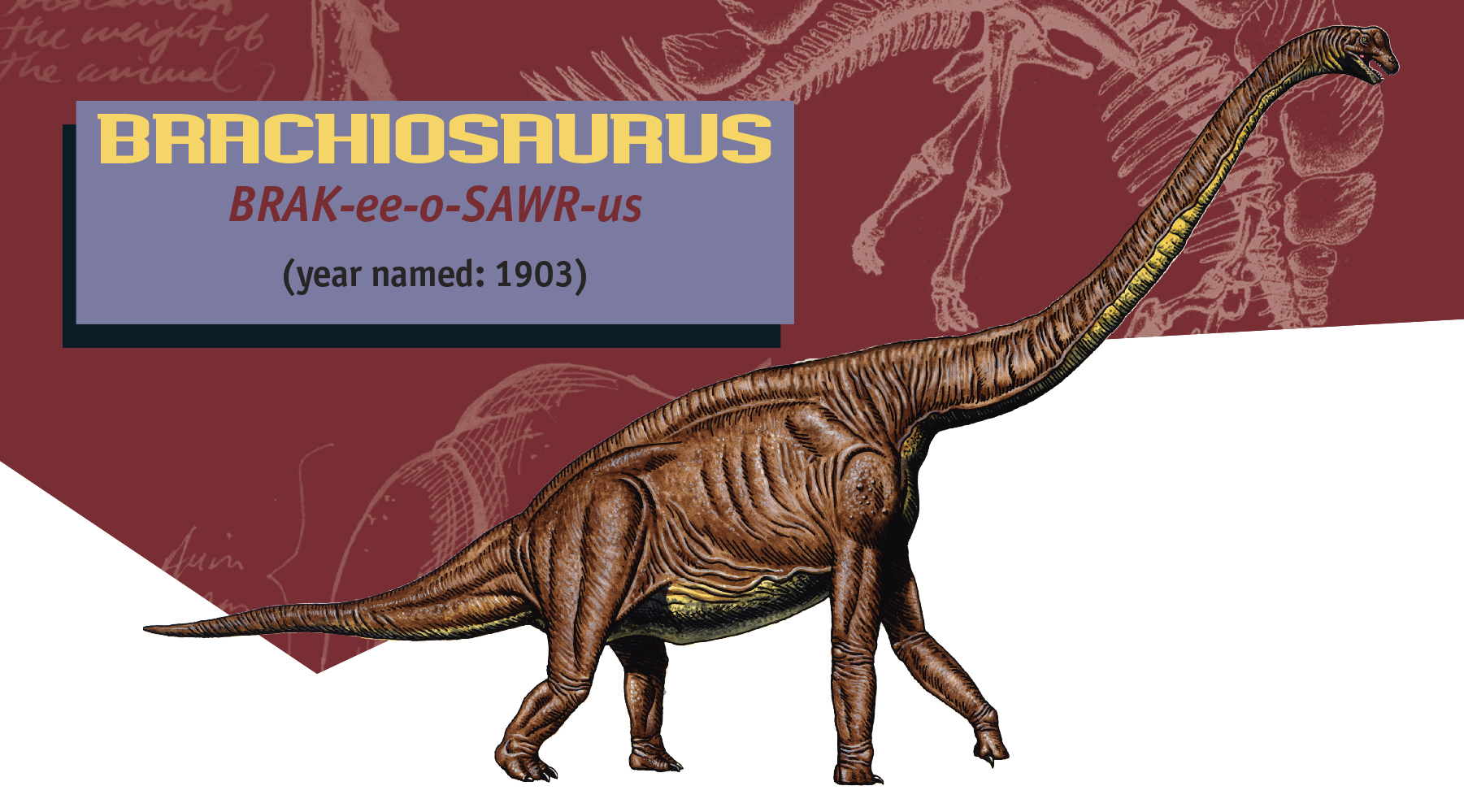

Brachiosaurus (“arm lizard”) is one of the most spectacular dinosaurs ever seen. It gets its name from the great height of its humerus, or upper arm bone—which is longer than most humans are tall! Originally discovered in 1900 in Colorado, Brachiosaurus was named in 1903 by Elmer Riggs of the Field Museum in Chicago.
For almost a century, Brachiosaurus was considered the tallest of all dino-saurs. It was over 50 feet (15 m) tall, and no other animal came close. Imagine going to the fifth floor of a building and looking down at the sidewalk.
Now imagine your feet are at street level and this is how tall you are! Get the idea? Today, however, there is a new contender for the title of tallest dinosaur. It is Sauroposeidon, named in 2000. Scientists believe it would stand 60 feet (18 m) tall!
New studies by computer specialists suggest that Brachiosaurus may not have carried its neck angled up as high as was once thought. It may have carried the neck more at a 45- to 60-degree angle. Although this changes its height, it does not change its length—or our wonder at this gigantic, graceful dinosaur.
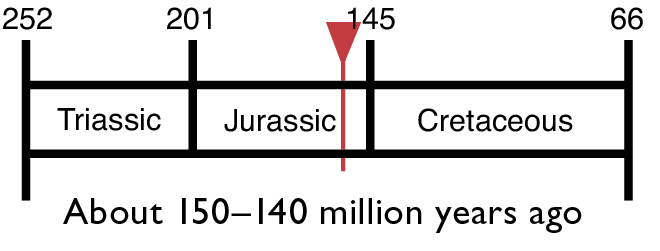

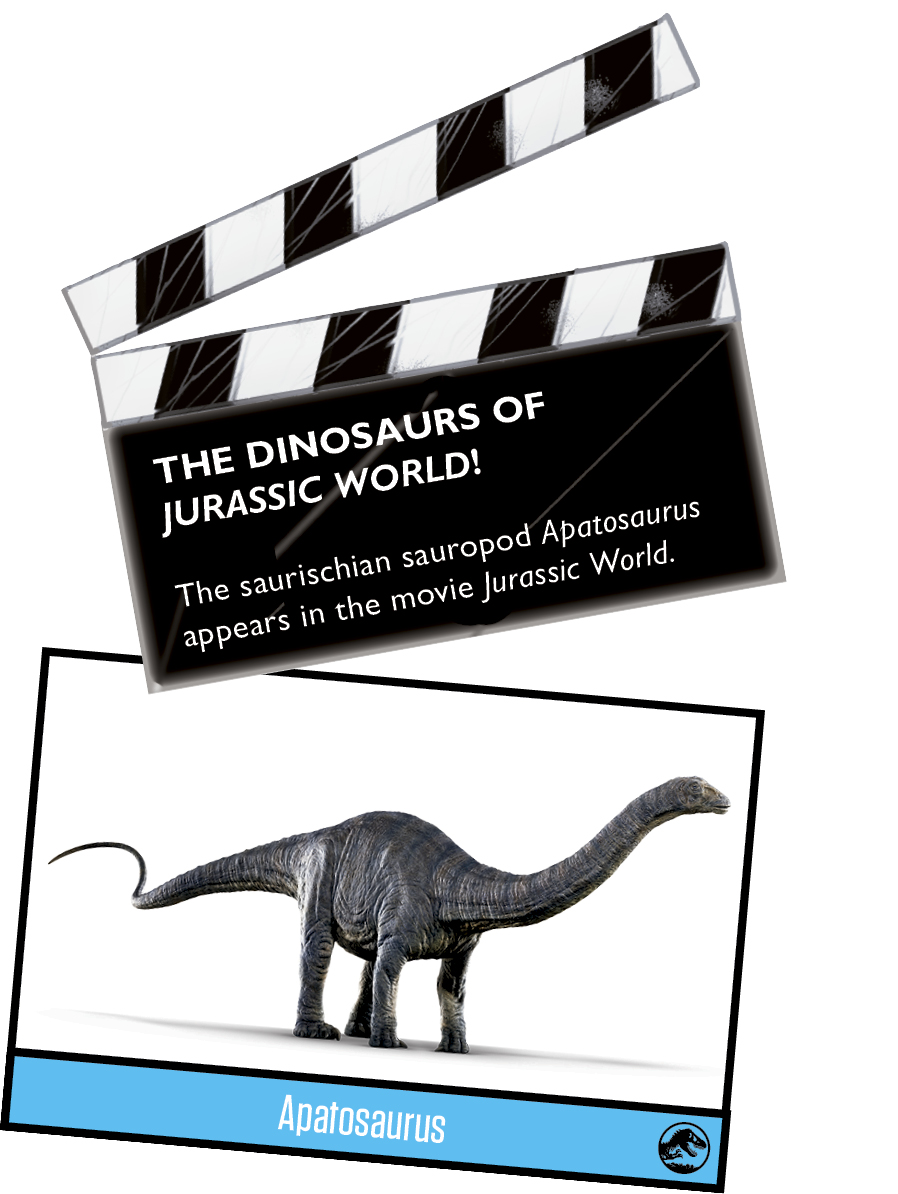

FUN FACTS: Brachiosaurus lived in the United States during the Jurassic, and a very similar dinosaur, Giraffatitan, lived in Africa. Because these dinosaurs would have been terrible swimmers, scientists know that Africa and North America were connected during the Jurassic.
LOCATION: Colorado, Utah, Wyoming, Oklahoma
FOOD: Conifers, cycads, ginkgos
SIZE: 80 feet (24 m) long, 23 feet (7 m) high at the hips
WEIGHT: 30 tons
FRIENDS: Camarasaurus, Apatosaurus
ENEMIES: Allosaurus, Ceratosaurus, Torvosaurus
TRIVIA: Brachiosaurus was one of the few dinosaurs that was literally too big to attack!




Camarasaurus (“chambered lizard”) is one of the most bulky of the sauropods, the big long-necked plant-eaters. It has teeth that are shaped like spoons, only much thicker. The head is large and boxlike, with powerful jaws and a wide bite. Camarasaurus fed on very tough, fibrous plants and, like all sauropods, did not chew food but swallowed it whole. This is why sauropods swallowed gastroliths, or stomach stones. The stones helped to grind up the plants inside their stomachs.
The name Camarasaurus comes from the chambers that can be seen in its vertebrae. These hollow chambers serve to lighten the skeleton and give it strength. Some scientists believe that these chambers also housed an air-sac system similar to that in birds. Air sacs are part of the respiratory system and are connected to the lungs. This would have greatly helped the air flow through the lungs. Gigantic animals like sauro-pods would have benefited from a more efficient system of breathing, because carrying around over twenty-five tons of weight would require a lot of oxygen.
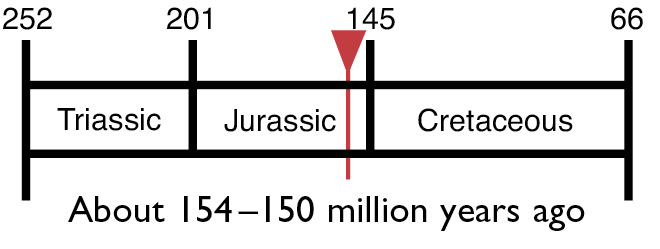

FUN FACTS: Camarasaurus is one of the very few dinosaurs for which juvenile skeletons have been found along with adults.
LOCATION: Colorado, Wyoming, Utah, New Mexico, Montana
FOOD: conifers, cycads, ginkgos
SIZE: 50 feet (15 m) long, 7 feet (2.1 m) high at the hips
WEIGHT: 25 tons
TRIVIA: This dinosaur was part of the famous “Bone Wars” of the 1870s between Edward Drinker Cope and Othniel C. Marsh, two scientists who competed to name the most dinosaurs.




Camptosaurus (“bent lizard”) is one of the ornithopods, or beaked dinosaurs. It gets its name from the fact that its thighbone is very slightly bent outward. This is common in many small bipedal dinosaurs. It is an adaptation to get the thighbone out and away from the rib cage while walking, increasing the freedom of movement. A quick escape was Camptosaurus ’s best defense against predators.
Camptosaurus is important in the study of the ornithopods because it represents the first step in a series of adaptations that eventually resulted in the hadrosaurs (duckbilled dinosaurs). In it we can see the first adaptations for carrying a large, heavy body (a thicker, wider pelvis) and the first indications of a staggered row of teeth (instead of a single row).
As far as we can tell, Camptosaurus was rare. Few specimens have been found, and no complete specimens. This may be because it lived in the Morrison Formation, along the Rocky Mountains. This formation is famous for its predators. A relatively small dinosaur like Camptosaurus would have made a good meal, and its remains would have been easily scavenged.


FUN FACTS: The camptosaurs were the closest relatives of the iguanodons.
LOCATION: Wyoming, Utah, Colorado, Oklahoma, Montana
FOOD: Conifers, cycads, ginkgos, horsetails
SIZE: 15 feet (4.5 m) long, 5 feet (1.5 m) high at the hips
WEIGHT: .5 ton
TRIVIA: The original specimens used to name two species of Camptosaurus were on display at the Smithsonian Institution in Washington, D.C.




Carcharodontosaurus (“great-white-shark-tooth lizard”) was first known only from its enormous teeth. When these teeth were first described in 1927, they were thought to come from a giant species of Megalosaurus. In 1931, however, paleontologists thought that they were different enough to be given their own name—after the great white shark, whose teeth this dinosaur’s resembled.
When parts of this dinosaur’s skeleton were finally discovered in northern Africa, they revealed a predator as big as Tyrannosaurus rex. Sadly, these fossils, kept in a museum in Munich, Germany, were destroyed by a bomb during World War II. But many decades later, in the summer of 1995, a team of paleontologists led by Paul Sereno found the most complete fossils yet of Carcharodontosaurus. These included most of the skull—including a braincase—as well as some other parts of the skeleton. This showed that Carcharodontosaurus was as big as the biggest Tyrannosaurus!
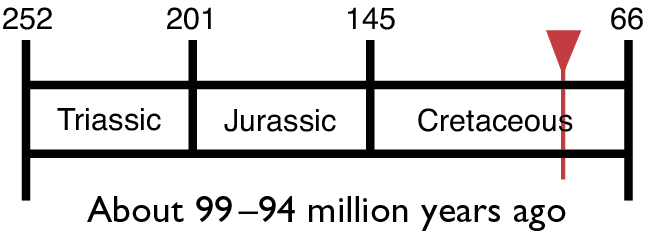

FUN FACTS: Carcharodontosaurus had a very narrow skull. Because its eyes faced sideways, it wouldn’t have been able to focus well on things right in front of it, but it could have seen almost all its surroundings at once.
LOCATION: Morocco, Niger, Egypt
FOOD: Other dinosaurs (titanosaurs)
SIZE: About 40 feet (12 m) long, 12 feet (3.6 m) high at the hips
WEIGHT: About 6 tons
FRIENDS: None
ENEMIES: Spinosaurus, Deltadromeus
TRIVIA: Carcharodontosaurus teeth seem to be relatively common fossils in northern Africa.
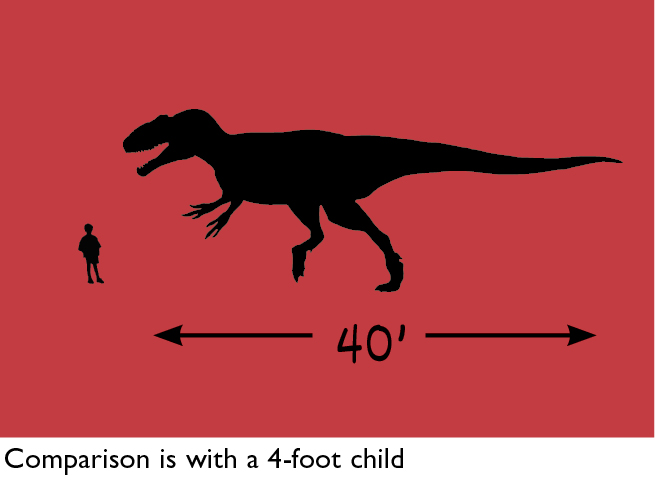



Carnotaurus (“meat [-eating] bull”) was one of the most bizarre meat-eating dinosaurs ever found. Its skull was short, with armor on the top and a pair of knobby horns over its eyes. The neck and shoulder blades were well developed, but the arms were incredibly short, with forearms so shrunken they were practically just wrists! Not even Tyrannosaurus rex had such small arms.
With its small skull, Carnotaurus might not have been able to attack big plant-eaters, but it was probably fast and could have easily chased down smaller, more agile prey.
The horns of Carnotaurus look something like those of a bull—and like a bull, it may have used them in contests with others of its own species. In this way, two Carnotaurus could test each other’s strength without either of them seriously injuring the other.
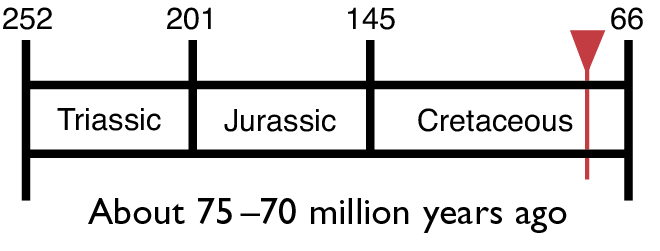

FUN FACTS: The first, and so far only, discovered specimen of Carnotaurus was found with impressions of skin from all over the body.
LOCATION: Chubut Province, Argentina
FOOD: Other dinosaurs
SIZE: Almost 22 feet (6.5 m) long, 6.6 feet (2 m) high at the hips
WEIGHT: 1 ton
TRIVIA: In Michael Crichton’s novel The Lost World: Jurassic Park II, the genetically re-created Carnotaurus had the power of chameleon-like camouflage. However, it is extremely unlikely that any dinosaur really had this ability.
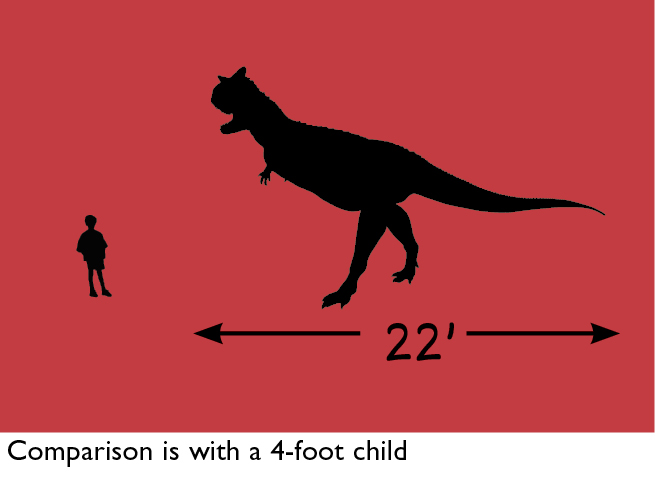



Caudipteryx (“tail feathers”) was one of the most amazing dinosaur discoveries of the 20th century. It showed a dinosaur that was not a bird but had true feathers on its arms and tail.
Some scientists thought Caudipteryx was no more than some kind of primitive flightless bird, but when the skeleton of this little creature was studied in detail, it turned out to be an oviraptorosaur. Oviraptorosaurs were a type of meat-eating dinosaur common in the Late Cretaceous of Asia and North America. Caudipteryx was the oldest of the oviraptorosaurs and one of the most primitive.
The arms of Caudipteryx were very short, so it certainly could not fly. Then why did it have feathers? Paleontologists suggest a number of possibilities. It might be that they were used for signaling other Caudipteryx, as a peacock does. They might have been used to cover Caudipteryx’s eggs while it brooded its nest. Or possibly the ancestors of Caudipteryx really did fly but later become grounded (as happened with ostriches, kiwis, and chickens). We may never know for sure.


FUN FACTS: Some Caudipteryx fossils have been found with stomach stones, which would have helped grind up their food.
LOCATION: Liaoning Province, China
FOOD: Possibly plants, small reptiles and mammals, eggs
SIZE: About 24 inches (61 cm) long, almost 20 inches (50 cm) high at the hips
WEIGHT: About 24 lbs (11 kg)
TRIVIA: One of the newest dinosaur museums in the world is in China, next to the site where Caudipteryx and other feathered dinosaur fossils were found.
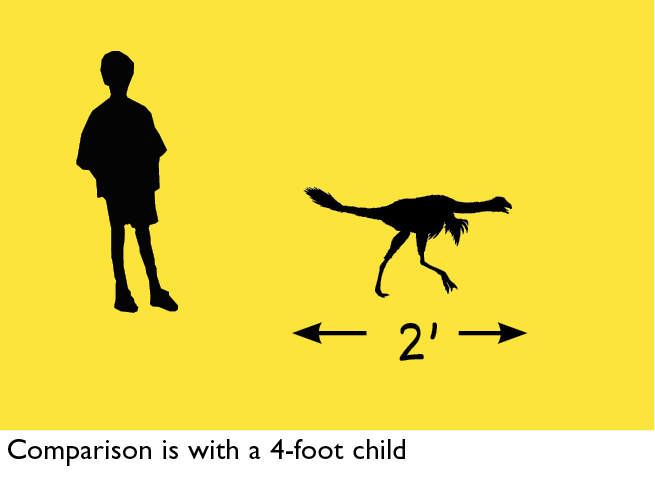

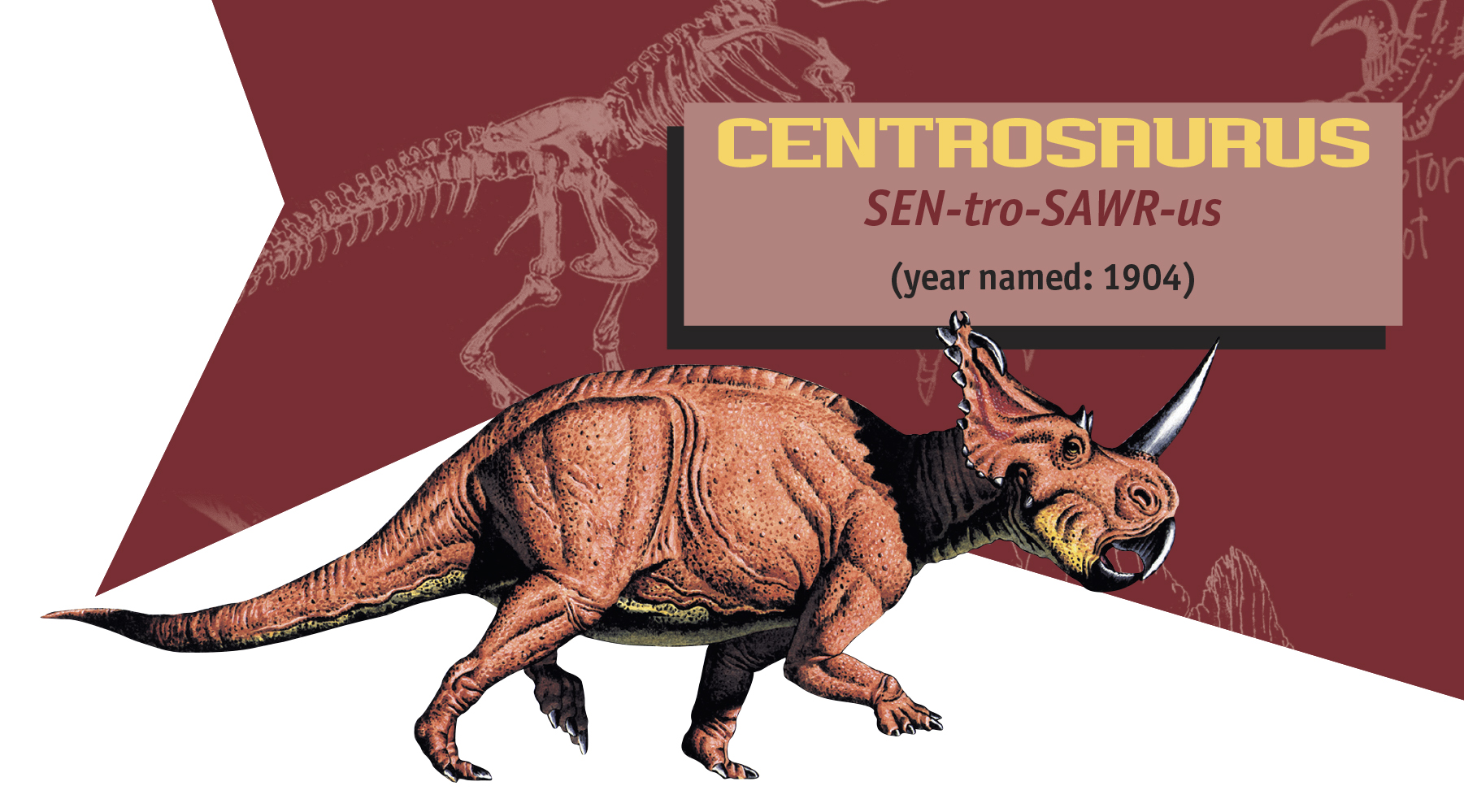

In the 1800s,Centrosaurus (“spur lizard”) was discovered in what is now called Dinosaur Provincial Park, in Alberta, Canada. This is one of the largest dinosaur graveyards in the world. In the 1980s, paleontologists discovered the “Centrosaurus Bonebed” within the park. The bonebed contains the skeletons of thousands of Centrosaurus that perished while crossing a river during a flood. This allows scientists a rare chance to see how Centrosaurus changed as it grew old.
Scientists had argued for years over whether Centrosaurus was the same animal as Monoclonius. The confusion resulted from the fact that horned dinosaurs’ heads changed a lot as the animals grew older. Juveniles did not have the bumps, hooks, spikes, and knobs found on the skulls of adults. The dinosaur once known as Monoclonius is now regarded as a juvenile form of Centrosaurus and other horned dinosaurs.


FUN FACTS: One of the most common injuries in Centro saurus skeletons is a broken tail. Apparently, it was quite common for them to get stepped on!
LOCATION: Alberta, Canada
FOOD: Conifers, cycads, ginkgos, flowering plants
SIZE: 20 feet (6 m) long, 6.6 feet (2 m) high at the hips
WEIGHT: 3 tons
TRIVIA: Dinosaur Provincial Park is a World Heritage Preserve. This means that the United Nations regards this park as a treasure for the whole world.
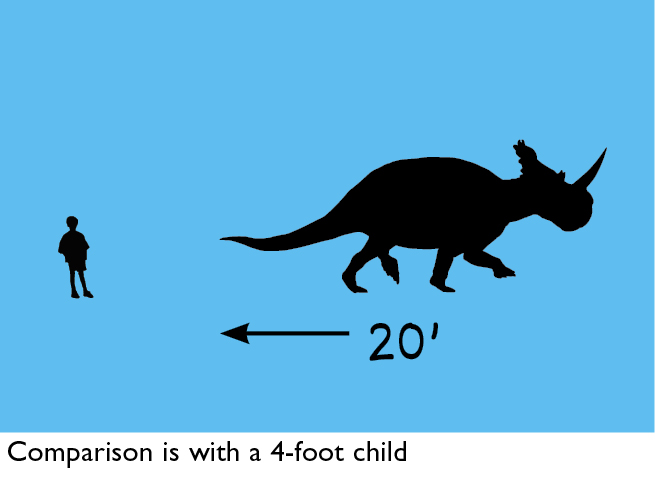



Ceratosaurus (“horned lizard”) was one of the first meat- eating dinosaurs known from a nearly complete skeleton. The first Ceratosaurus was found in 1883 in the Garden Park Quarry of Canyon City, Colorado. This area has produced many of the most important Jurassic fossils known. Although some parts of the arms and legs were missing, the rest of the skeleton was almost complete. Before this disco-very, no skeleton of a large meat-eating dinosaur had been found that was more than half complete. These bones gave paleontologists many of their first insights into predatory dinosaurs.
Ceratosaurus was unusual for a meat-eater—it had a horn on its nose. The horn was very thin side-to-side (unlike the horns of the plant-eaters like Centrosaurus and Triceratops, which were cone-shaped). This horn, and the smaller horns just in front of its eyes, were very delicate and probably used only for signaling to other Ceratosaurus. The huge teeth and powerful jaws were probably Centrosaurus’s main weapons, since its arms and claws were small.
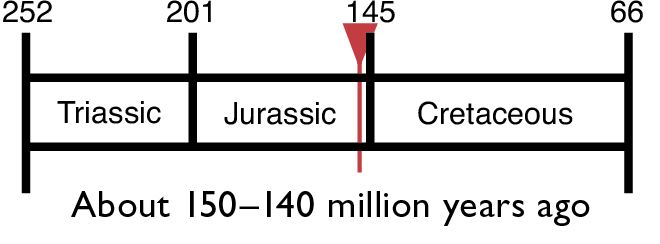

FUN FACTS: Although it was smaller overall than Allosaurus, Ceratosaurus had bigger teeth than its rival.
LOCATION: Colorado, Wyoming, Utah
FOOD: Other dinosaurs (sauropods, stegosaurs, ornithopods, smaller theropods)
SIZE: Almost 24 feet (7.2 m) long, over 6.2 feet (1.9 m) high at the hips
WEIGHT: Over 1 ton
TRIVIA: The horns on the nose and in front of the eyes of Ceratosaurus got bigger as the dinosaur got older. The original specimen is at the Smithsonian.


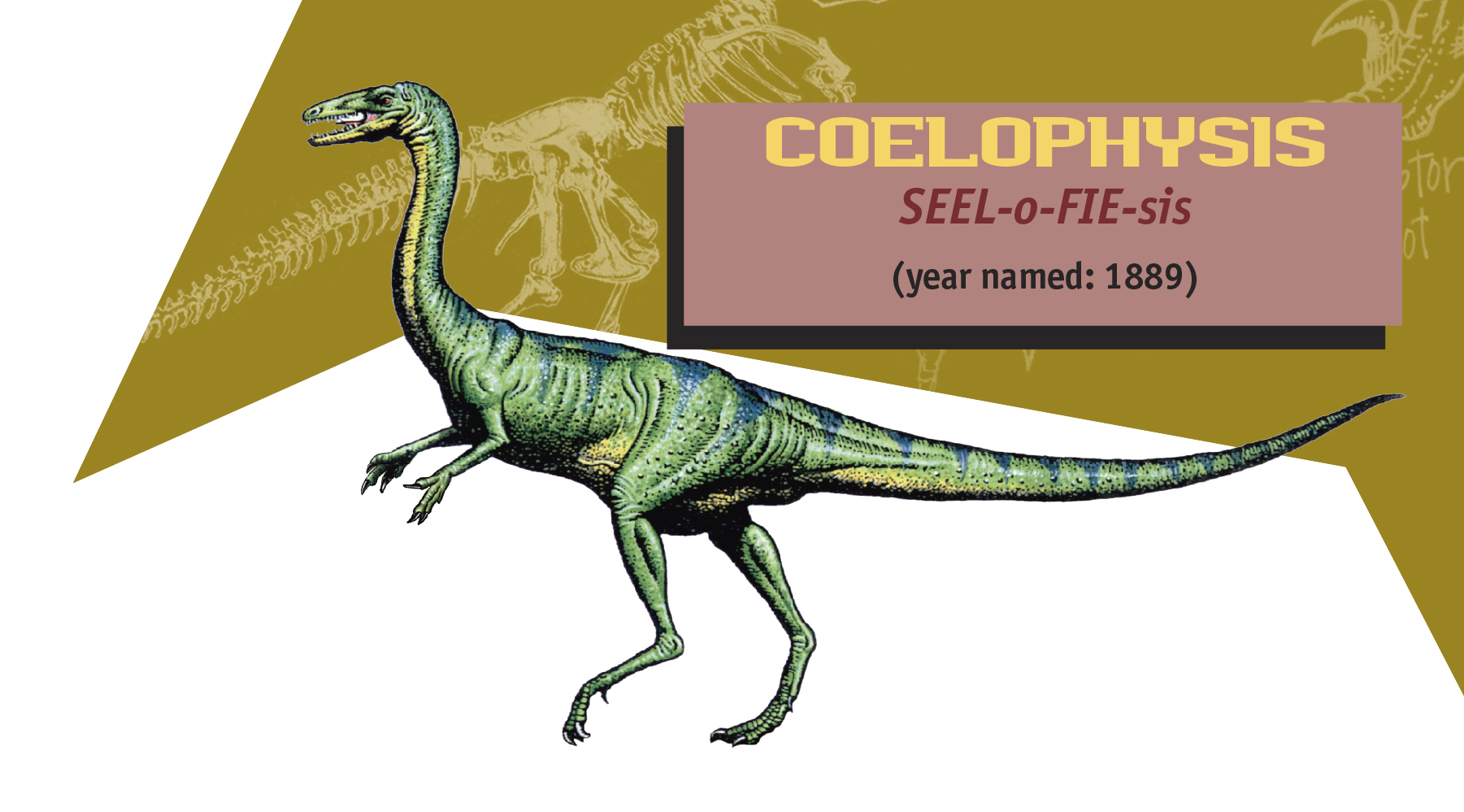

Coelophysis (“hollow form”) was one of the first meat-eating dinosaurs. When Coelophysis lived, dinosaurs had just evolved, and they did not yet dominate the land. Instead, giant relatives of crocodilians were the top predators, and armored crocodile relatives and ox-sized protomammals—primitive synapsids related to the ancestors of mammals—were the big plant-eaters. Coelophysis was a minor predator in its environment, but it was very successful. Unlike their crocodilian relatives, Coelophysis and other early dinosaurs were fast-running, agile hunters.
In 1947, hundreds of Coelophysisskeletons were found buried together at Ghost Ranch, New Mexico. This spectacular discovery included old individuals, babies, and all ages in between. Except for a few other reptiles, the only skeletons in this quarry were from Coelophysis. This suggests that these early dinosaurs would group together, at least occasionally.


FUN FACTS: Coelophysis is known from more skeletons than any other meat-eating dinosaur of the Mesozoic.
LOCATION: New Mexico, Arizona
FOOD: Small reptiles and fish
SIZE: 10 feet (3 m) long, 24 inches (60 cm) high at the hips
WEIGHT: 55 lbs (25 kg)
FRIENDS: None
ENEMIES: Postosuchus (a giant predatory crocodile relative)
TRIVIA: Coelophysis is the state fossil of New Mexico.
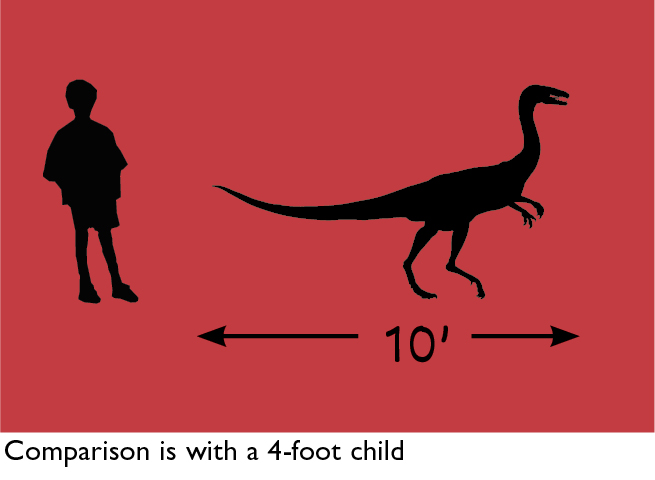



Compsognathus (“delicate jaw”) was once considered the smallest known dinosaur. The first discovered fossil of Compsognathus was less than 28 inches (70 cm) long; however, this specimen was probably not fully grown. Even so, adult Compsognathus probably weighed only about 7.7 pounds (3.5 kg). Although scientists now regard birds as dinosaurs (and therefore, there are many living dinosaurs smaller than Compsognathus), this little meat-eater from the Jurassic Period of Europe is still one of the smallest dinosaurs known from the Mesozoic Era, the Age of Dinosaurs.
Inside the belly of the original Compsognathus specimen is the skeleton of a fast-running lizard. This shows that Compsognathus was a meat-eater like its bigger relatives (such as Tyrannosaurus and Giganotosaurus), but it hunted much smaller prey. It lived on the same tropical islands as Archaeopteryx, and perhaps it would even eat its smaller flying relative.
Compsognathus had short arms that were probably not very useful in catching prey, but that were handy for holding on to victims it snatched up in its jaws. For many years, it was thought that Compsognathus had only two fingers on each hand (as in Tyrannosaurus and other tyrant dinosaurs). However, it now seems that Compsognathus had three fingers on each hand like most meat-eaters.
Compsognathus seems to have been a close relative of the Chinese Sinosauropteryx, and like that Asian dinosaur it probably had a covering of “protofeathers.” Unfortunately, neither protofeathers nor scales were preserved in the known fossils of Compsognathus.
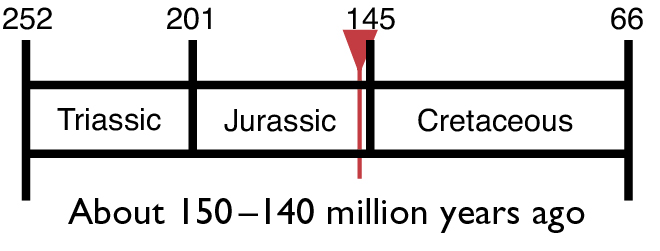

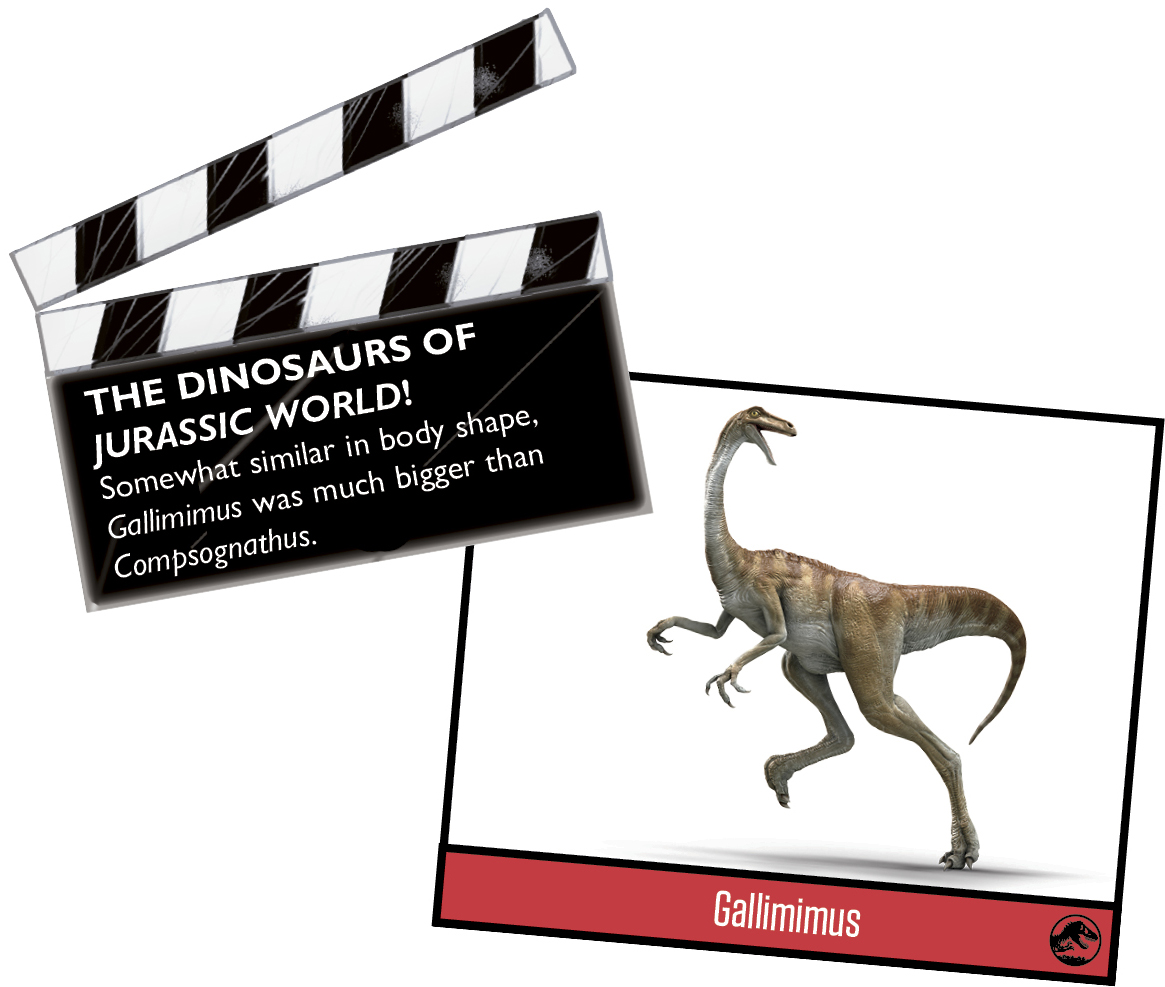

FUN FACTS: Compsognathus was the first dinosaur known from a nearly complete fossil.
LOCATION Germany and France
FOOD: Small reptiles and mammals, possibly insects
SIZE: 4 feet (1.1 m) long, 10 inches (26 cm) high at the hips
WEIGHT: 7.7 lbs (3.5 kg)
FRIENDS: None
ENEMIES: Bigger theropods
TRIVIA: Only two skeletons of Compsognathus are presently known: one from Germany and a slightly larger one from France.
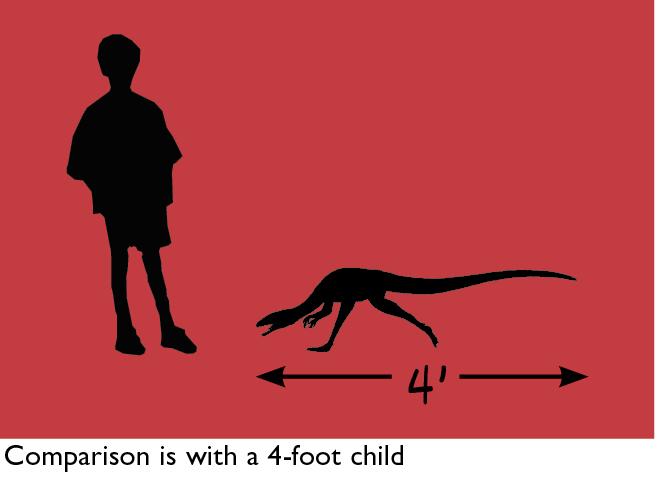



Confuciusornis (“Confucius’s bird”) is one of the oldest and most primitive birds known. It is more advanced than Archaeopteryx because the bones at the end of its tail are fused into a single structure, as in modern birds. Confuciusornis is also the oldest known bird that had lost all of its teeth. This actually evolved independently of the loss of teeth in modern birds. In fact, Mesozoic toothed birds like Hesperornis are much more closely related to the birds of today than to Confuciusornis.
Confuciusornis comes from the spectacular Yixian Formation of China, so the feathers in most specimens are very well preserved. From this we see that some Confuciusornis had two long tail feathers, while most did not. Perhaps the ones with the long tail feathers were males, and the ones without were females.
Confuciusornis is known from hundreds of skeletons. Perhaps great flocks of Confuciusornis flew across the skies of Early Cretaceous China.
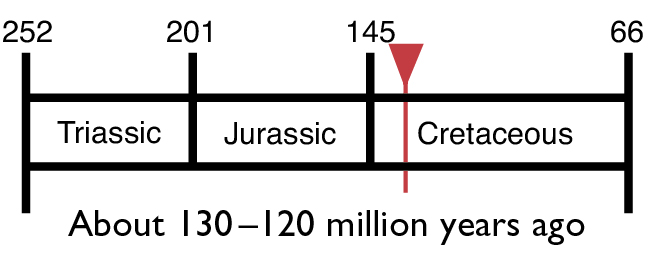

FUN FACTS: Confucius-ornis is known from so many fossils that it may be the most common Mesozoic dinosaur ever found.
LOCATION Liaoning Province, China
FOOD: Possibly insects and plants
SIZE: 8 inches (20 cm) long, 4 inches (10 cm) tall, 14 inches (36 cm) wingspan
WEIGHT: 14 ounces (400 g)
TRIVIA: People have often tried to sell fake Confuciusornis skeletons. They sometimes give them extra leg bones or leave bones out!
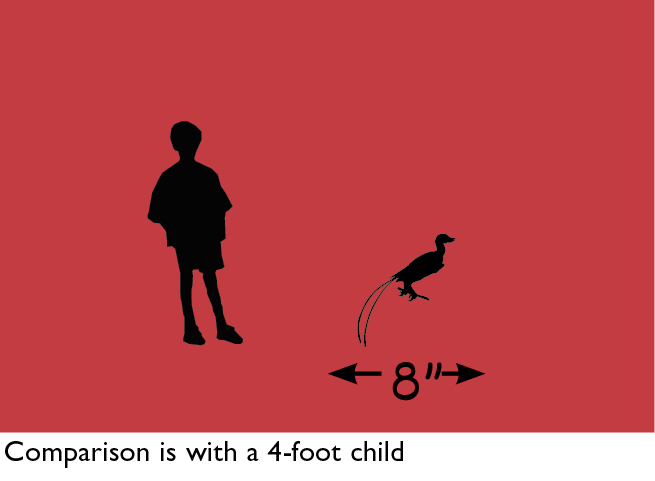



Corythosaurus (“Corinthian helmet lizard”) is one of the crested duckbill dinosaurs. At one time, over six species were named based on slight differences in the crest on the skull. But in 1975, paleontologist Peter Dodson showed that these changes are due to sexual dimorphism and growth allometry. In other words, they were all the same species, and the differences in the skulls and crests were normal among a large population of juveniles and adults of both sexes.
The famous crest of Corythosaurus is formed from the upper lip bone and the nasal bone. These two bones have grown back and up over the skull, taking the nasal passage with them. The result is a folded nasal passage comparable to a woodwind instrument, such as a clarinet. Each species of crested duckbill dinosaur would have made its own unique sound, like different instruments in an orchestra. The crest also housed the enlarged olfactory lobes of the brain, increasing the duckbill’s sense of smell. In some species, the olfactory lobes are actually bent toward the hollow crest in order to be closer to the nasal chambers!
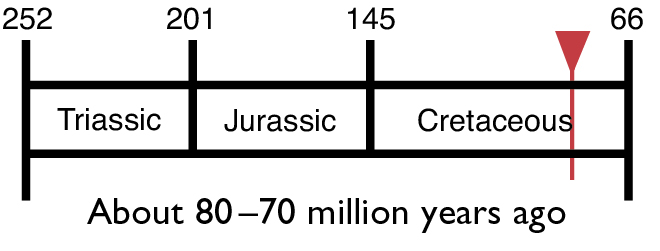

FUN FACTS: This was the first dinosaur found with an almost complete skin!
LOCATION Alberta, Canada
FOOD: Conifers, cycads, ginkgos, angiosperms
SIZE: 33 feet (10 m) long, 6.6 feet (2 m) high at the hips
WEIGHT: 5 tons
TRIVIA: The most beautiful and complete Corythosaurus skeleton is on display at the American Museum of Natural History in New York City.
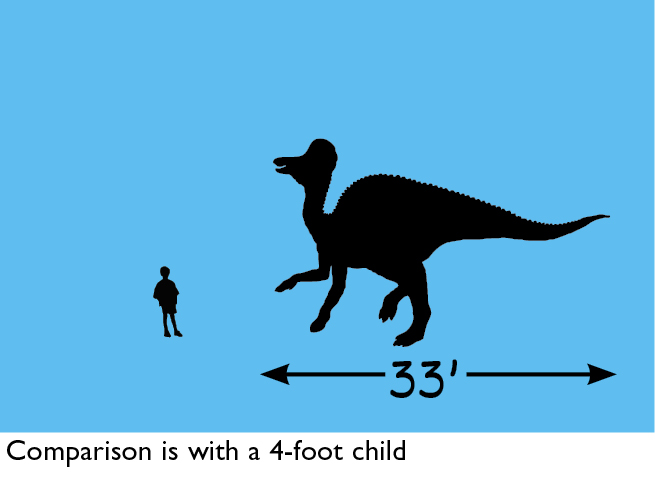

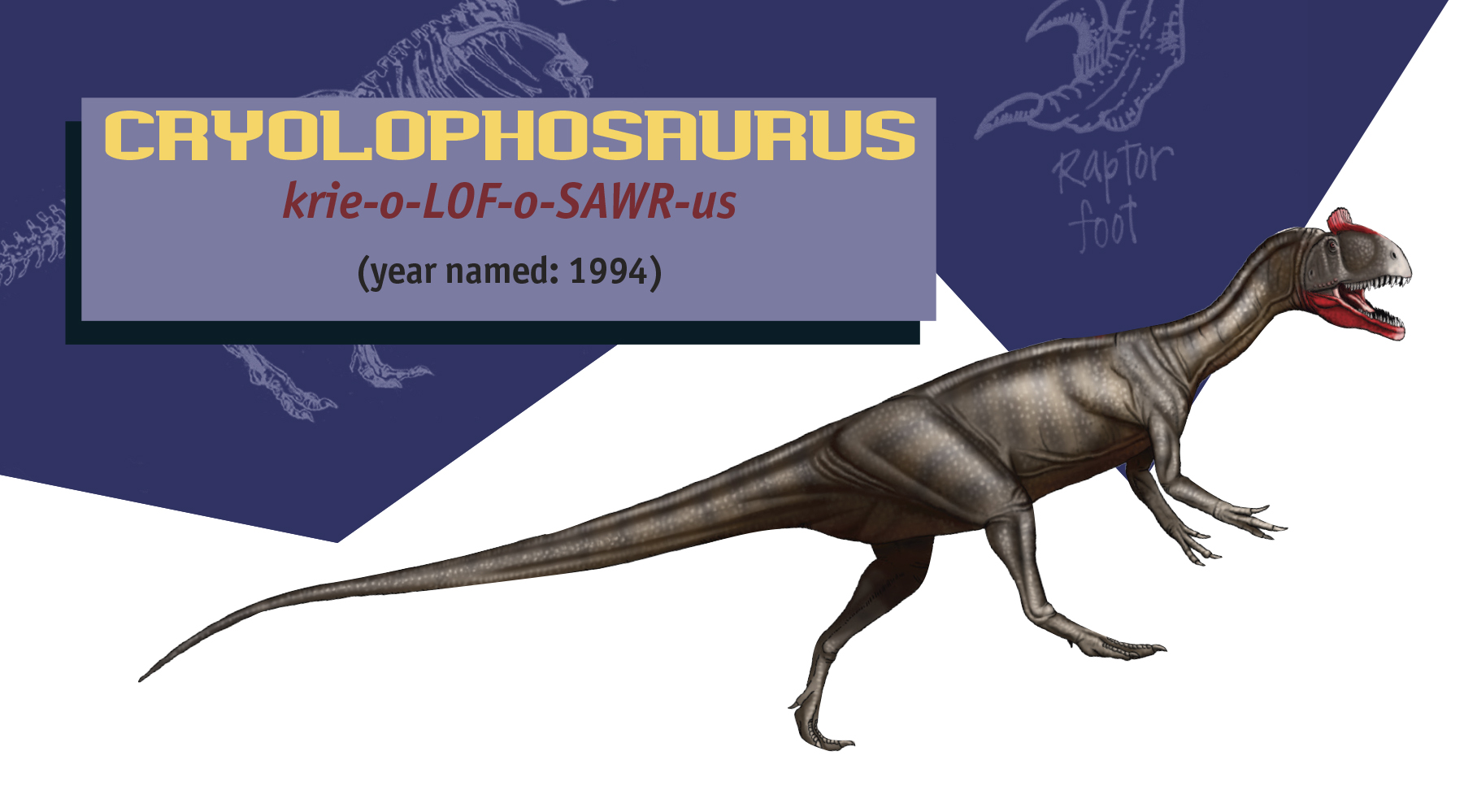

Cryolophosaurus (“frozen-crested lizard”) is the first fossil dinosaur from Antarctica that has been officially named. The only known fossil of this dinosaur was recovered from the Transantarctic Mountains in 1990. This is one of the few places in Antarctica where the rock sticks up through the glaciers. In most spots, the rocks (and fossils in them) are buried under a mile or more of ice.
Although a frozen land now, Antarctica was not always covered in ice. During the Age of Dinosaurs, the world was warmer in general, and Antarctica was farther north than it is today. All sorts of animals and plants once flourished there. It was only after the Age of Dinosaurs that Antarctica shifted over the South Pole and became buried in ice.
Cryolophosaurus was a meat-eating dinosaur. Its most distinctive feature is its forward-facing crest. The remains of a prosauropod dinosaur named Glacialisaurus were found with the skeleton of Cryolophosaurus, so it is likely that prosauropods were the prey of choice.
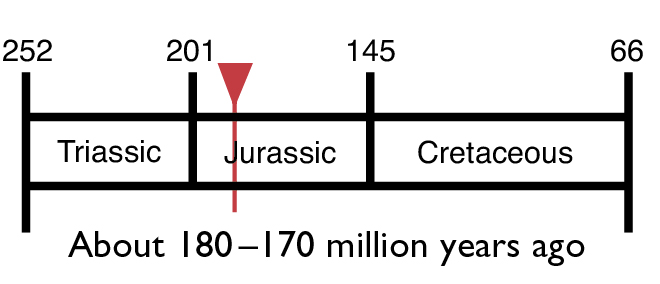

FUN FACTS: Other dinosaurs from Antarctica include ankylosaurs Antarctopelta and the ornithopod Trinisaura, both from the Cretaceous Period.
LOCATION Antarctica
FOOD: Other dinosaurs
SIZE: Perhaps 20 feet (6 m) long, perhaps 5 feet (1.5 m) high at the hips
WEIGHT: Perhaps 1,155 lbs (525 kg)
TRIVIA: Although Cryolophosaurus is the first named Mesozoic dinosaur from Antarctica, penguins are the best-known dinosaurs from the frozen land. (Remember: Birds are a kind of dinosaur, and penguins are a kind of bird!)
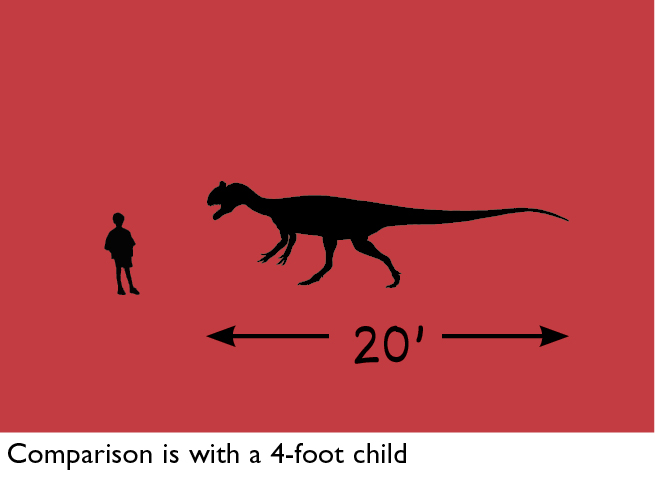



Deinonychus (“terrible claw”) is one of the most important dinosaurs ever found because it changed the way paleontologists thought about dinosaurs. For most of the 20th century, dinosaurs were generally thought of as being strange evolutionary “dead ends,” with no living descendants, mostly slow and sluggish. Then dinosaur paleontologist Dr. John Ostrom discovered Deinonychus in 1964.
Dr. Ostrom believed that this dinosaur was an agile, swift predator, more like a warm-blooded mammal or bird than a cold-blooded crocodile. His study of Deinonychus—and of the early bird Archaeopteryx—led him to realize that birds were in fact the descendants of dinosaurs, and that raptor dinosaurs such as Deinonychus and Velociraptor were among the closest relatives of birds.
Deinonychus was the first of the raptors (technically called “dromaeo-saurs”) to be known from a nearly complete skeleton. Velociraptor had been discovered forty years earlier but was known only from a skull and a few bones of its hands and feet. The skeletons of Deinonychus were the first to show the now infamous sickle-shaped retractable foot claw, used for ripping open the guts of its prey.
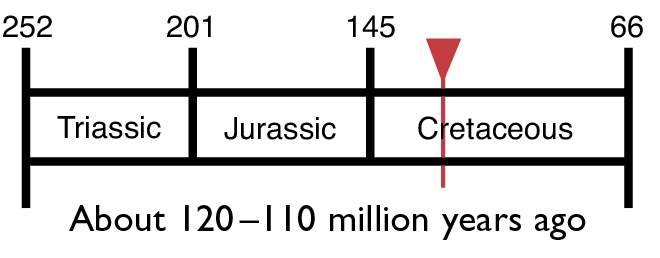

FUN FACTS: Deinonychus had “terrible claws,” but it also had a nasty bite, with over 60 knife-like teeth!
LOCATION Montana, Wyoming, Oklahoma, possibly Maryland
FOOD: Other dinosaurs
SIZE: Over 11 feet (3.4 m) long, 34 inches (87 cm) high at the hips
WEIGHT: Over 160 lbs (73 kg)
TRIVIA: The genetically re-created Velociraptors seen in Jurassic World are closer in size to a very large Deinonychus than to a true Velociraptor, which was much smaller.




Dilophosaurus (“double-crested lizard”) was one of the first large meat-eating dinosaurs. It was a close relative of the smaller dinosaur Coelophysis. Little Coelophysis lived in the Late Triassic, when Rauisuchus and other reptiles related to the ancestors of crocodilians were the top predators. At the end of the Triassic, however, there was a series of great extinctions, and the giant crocodile relatives became extinct. Dinosaurs then became the top meat-eaters.
In general, Dilophosaurus looks like a shorter-necked, more heavily built version of Coelophysis. Like its little relative, Dilophosaurus has a characteristic “kink” in the front of its snout. This probably helped hold on to struggling victims. One dramatic difference (other than size) between the two is the pair of tall crescent-shaped crests along the top of Dilophosaurus’s skull. These were very thin and probably used only for display.
Footprints that match the feet of Dilophosaurus are found in many parts of the world, dating from Early Jurassic. Since the continents of the Earth were still mostly attached as the supercontinent of Pangaea at this time (see map), it is possible that the double-crested hunter lived in most parts of the world.




FUN FACTS: The state fossil of Connecticut is a dinosaur footprint, very likely the footprint of Dilophosaurus or a close relative.
LOCATION Arizona
FOOD: Prosauropods, primitive bird-hipped dinosaurs
SIZE: Over 22 feet (6.8 m) long, 5 feet (1.5 m) high at the hips
WEIGHT: 880 lbs (400 kg)
TRIVIA: When the first skeleton of this dinosaur was found (in 1942), it was thought to be from a new species of Megalosaurus. Only later in the lab did paleontologist Sam Welles discover the pair of crests on its head.


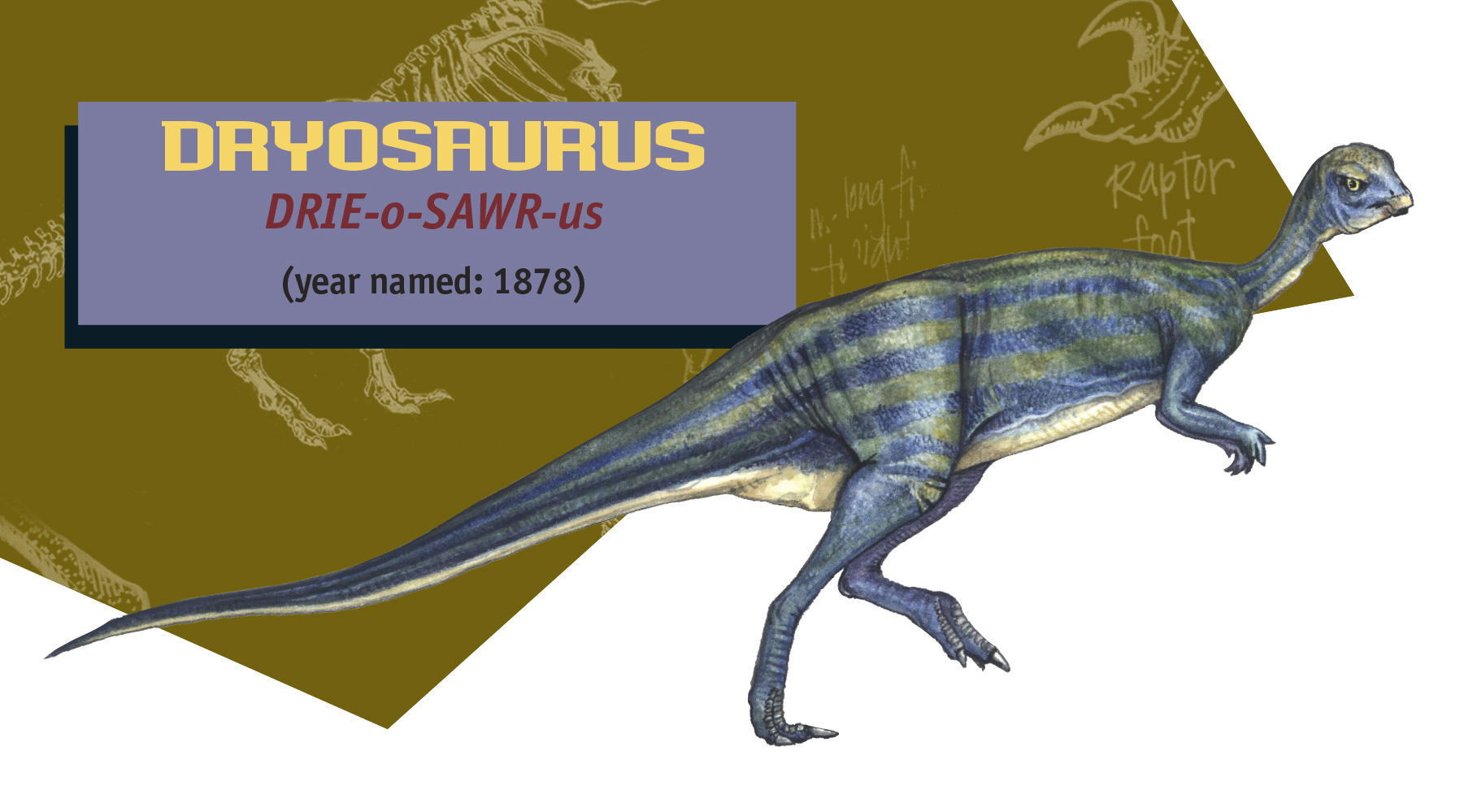

Dryosaurus (“oak-tree lizard”) literally lived in the shadows of most Late Jurassic plants. It was a small to medium-sized dinosaur and was very lightly built (as compared to its closest relative, the bulkier Camptosaurus). Dryosaurus was one of the ornithopods, or beaked dinosaurs. Its pelvis is small compared to the rest of the body. The arms are very short and the long legs not powerfully built. The skull has a short face and relatively big eyes.
A dinosaur like Dryosaurus had to rely on running from predators (rather than standing and fighting), so it had to grow as fast as possible. The longer its legs, the faster it would run. Not all dinosaurs grew as fast as Dryosaurus. Modern lizards, for example, grow in spurts, depending on the season. But Dryosaurus’s bones grew fast at all times, which was a great benefit to its survival.
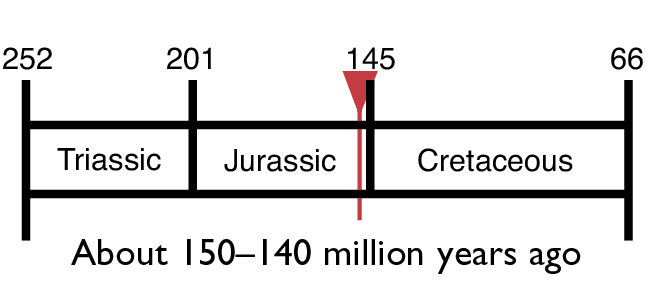

FUN FACTS: Dryosaurus could outrun a human.
LOCATION Wyoming, Utah, Colorado
FOOD: conifers, cycads, ginkgos
SIZE: 9.5 feet (just under 3 m) long, 5 feet (1.7 m) high at the hips
WEIGHT: 200 lbs (91 kg)
FRIENDS: Othnielosaurus, Camptosaurus, Stegosaurus
ENEMIES: Coelurus, Ornitholestes, Allosaurus
TRIVIA: A close relative to this dinosaur, named Dysalotosaurus, lived in Africa at the same time.
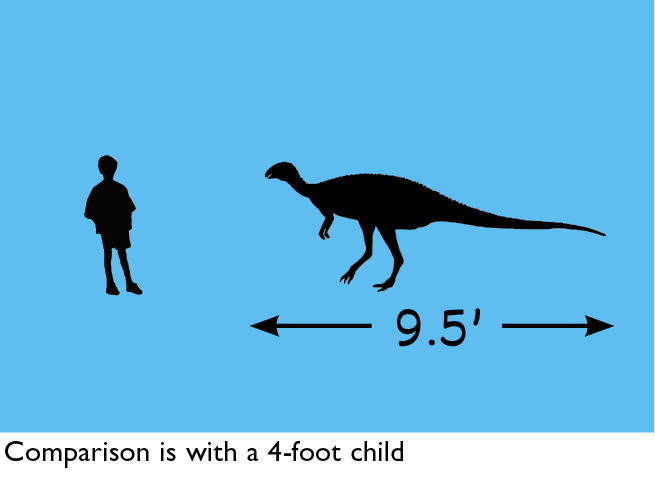

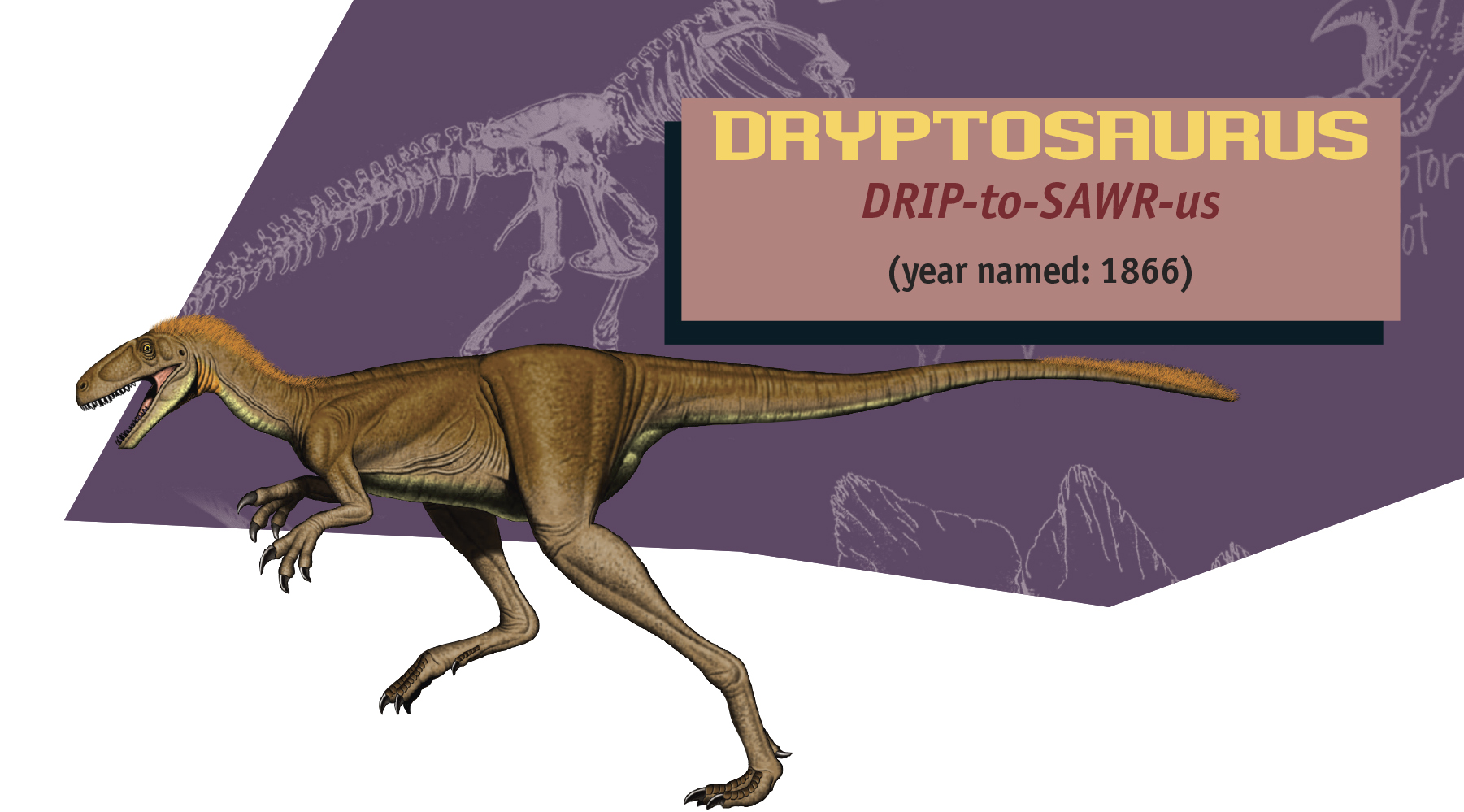

Dryptosaurus (“tearing lizard”) has an important place in the history of dinosaur science. Before this species was discovered in 1866, paleontologists had never found the arms and legs of the same species of a meat-eating dinosaur. Because of this, they thought that meat-eaters were four-legged hunters, like giant lizards or bears. However, when Dryptosaurus was found, scientists saw that meat-eating dinosaurs had arms that were much shorter than their legs, and realized they had to be bipedal, or two-footed.
Dryptosaurus was named for its enormous 8-inch (21-cm) claw. Its discoverer, Edward Drinker Cope, thought that this claw came from the foot, but it was later realized that this was actually a hand claw. Unfortunately, not much of the skeleton of Dryptosaurus was ever found. Paleontologists must guess at what it may have looked like.
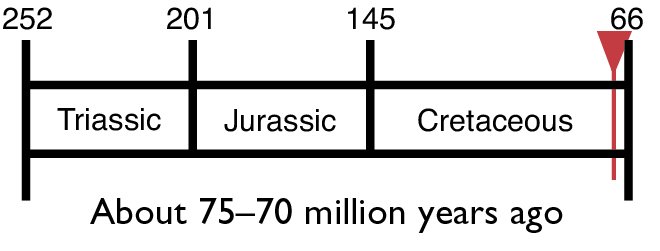

FUN FACTS: A famous painting by artist Charles R. Knight shows two Dryptosaurus fighting, with one of them leaping high in the air to pounce on the other. This is an exciting image but an unlikely scenario for animals of their size!
LOCATION New Jersey
FOOD: Hadrosaurus
SIZE: Perhaps 22 feet (6.5 m) long, 6 feet (1.8 m) high at the hips
WEIGHT: Perhaps 1.2 tons
FRIENDS: None
ENEMIES: None
TRIVIA: Dryptosaurus was first named Laelaps. It was then discovered that the name had already been used—for a type of mite!


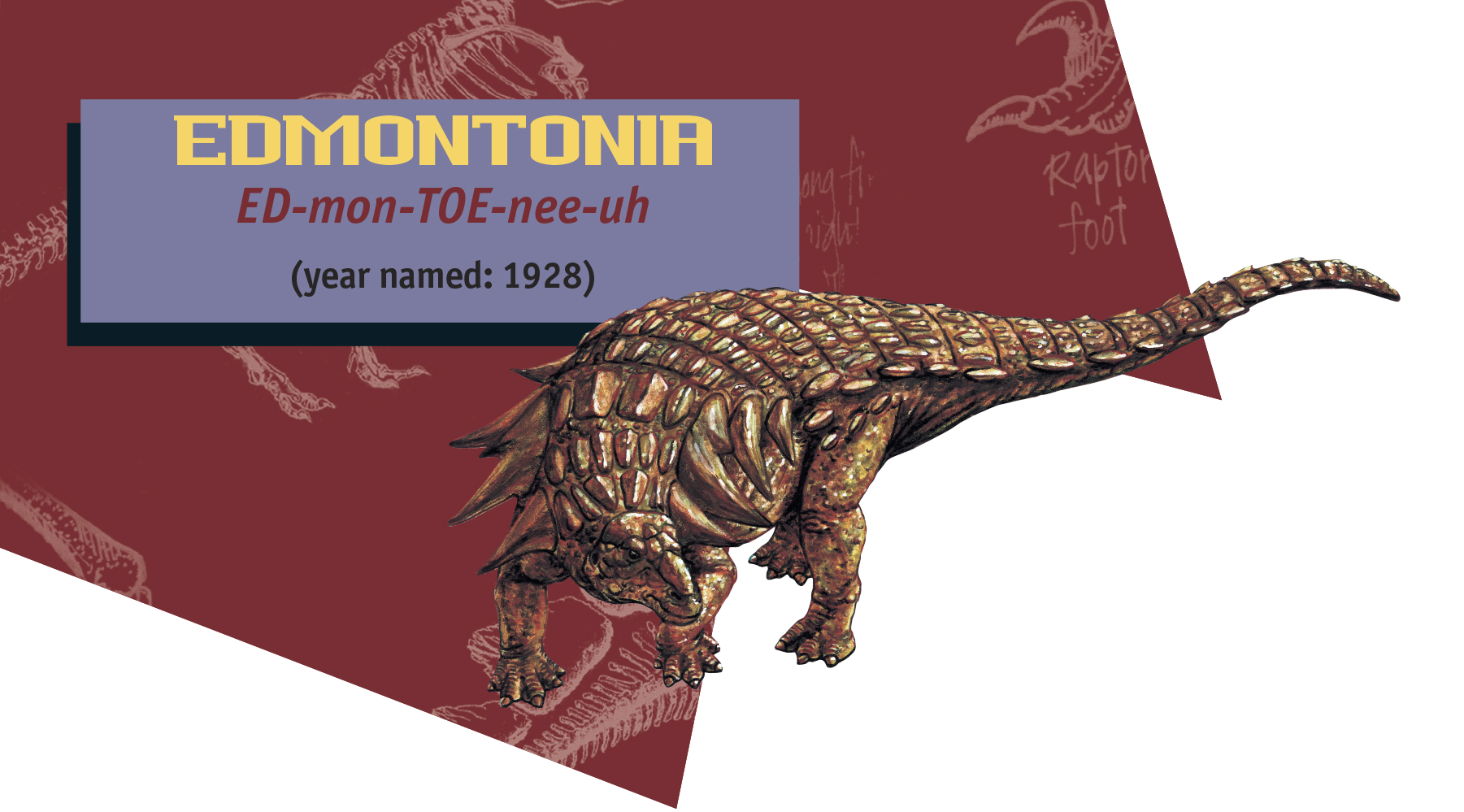

Edmontonia (“lizard from Edmonton [Canada]”) is a nodosaur, a kind of ankylosaur without a tail club. It had two large spikes on each shoulder that pointed out to the side. These spikes were a great defense against predators because they were at the same level as the knee and calf muscles of a larger theropod, or meat-eating dinosaur. If attacked, this slow-moving tank would throw its weight behind these spikes and drive them into a predator’s legs. This would immediately disable the attacker and allow Edmontonia to walk away.
Although the skull of Edmontonia was long and shallow, it had room for four sinus cavities. This meant the skull was lighter, and probably improved the dinosaur’s sense of smell. Edmontonia’s teeth were amazingly small for such a large animal. One tooth was only half an inch (1 cm) long and barely a fifth of an inch (5 mm) wide—far too small for eating most plants. Did Edmontonia also eat ants and insects, like the modern anteater? Or were its teeth disappearing over time because its beak did all the work? These are mysteries that dinosaur detectives have yet to solve!
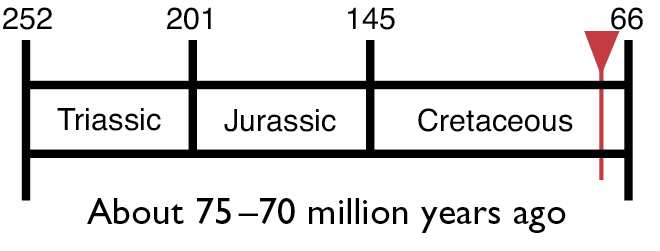

FUN FACTS: Edmontonia had flexible body armor.
LOCATION Montana; South Dakota; Wyoming; Alberta, Canada; possibly Alaska
FOOD: Conifers, cycads, ginkgos
SIZE: About 23 feet (just under 7 m) long, 6.6 feet (2 m) high at the hips
WEIGHT: 2.5 tons
TRIVIA: The best full-scale restoration is on display at the Royal Tyrrell Museum in Drumheller, Alberta, Canada.




Edmontosaurus (“Edmonton lizard”) was the largest, and last, of the non-crested duckbill dinosaurs. Its name refers to the city of Edmonton, Canada. Edmontosaurus is part of the Hadrosauridae, or duckbill family of dinosaurs, who are known for their amazing teeth—or as paleontologists call it, their “dental battery.” On each side of Edmontosaurus’s jaw are three rows of sixty or more perfectly interlocking teeth—that’s 720 per mouth, compared to thirty-two in an adult human! Not only did Edmontosaurus have a lot of teeth, but when one fell out, another from inside its jaw would take its place! Teeth like these are called “evergrowing.”
Edmontosaurus ate plants and had to be on constant alert for predators such as Tyrannosaurus and Acheroraptor. Edmontosaurus could not outrun any of the meat-eaters and had to rely on out- maneuvering them—like a crafty football player—or traveling in large herds, where there was safety in numbers.
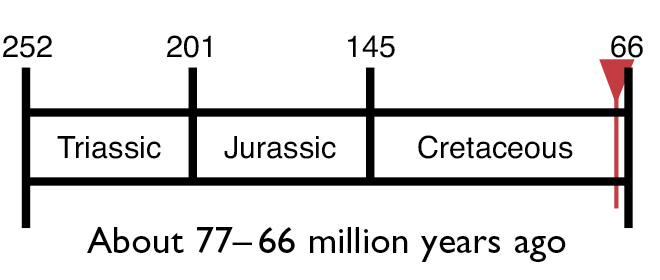

FUN FACTS: For many decades, the only complete “dinosaur mummies” were Edmontosaurus and Corythosaurus, both on display at the American Museum of Natural History in New York City.
LOCATION: Wyoming, Montana, South Dakota, Alaska, Canada
FOOD: Plants
SIZE: 33 feet (10 m) long, 8 feet (2.5 m) high at the hips
WEIGHT: 5 tons
FRIENDS: Triceratops
ENEMIES: Tyrannosaurus, Acheroraptor
TRIVIA: There were three species of Edmontosaurus. The last one to appear is considered by some to be its own genus—Anatotitan.
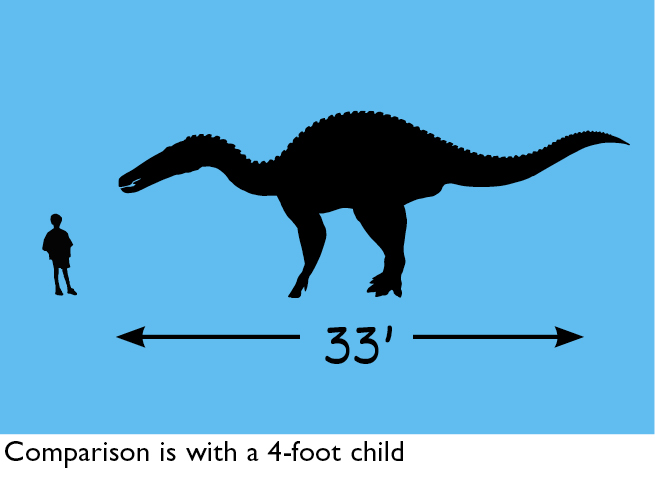

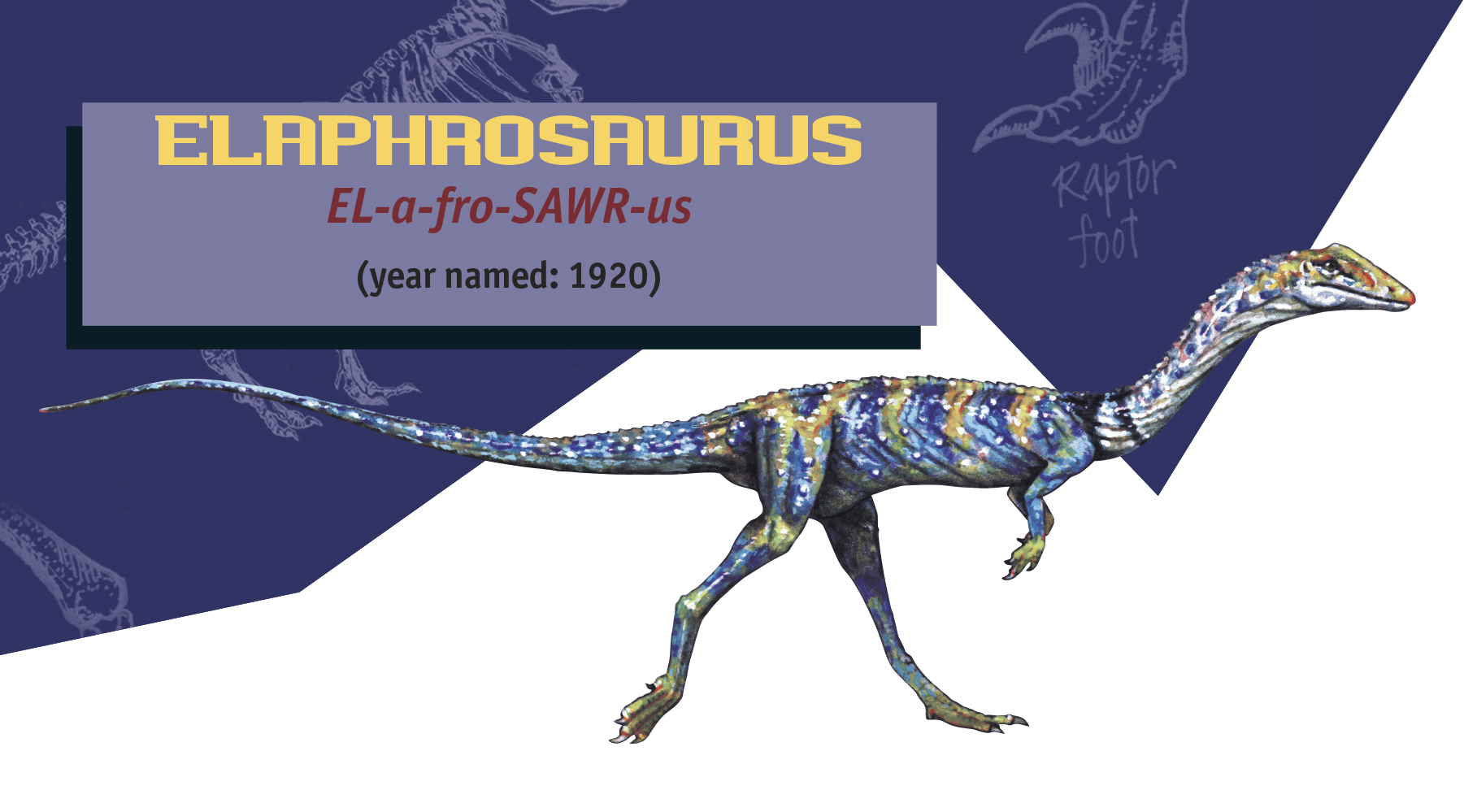

Elaphrosaurus (“fleet lizard”) was a meat-eating dinosaur with a long neck and tail and very long hind legs. Unfortunately, we don’t know what its head looked like because the skull has never been found.
What scientists know of Elaphro-saurus comes from a nearly complete skeleton recovered from the Tendaguru Beds of Tanzania. These beds contain the best Late Jurassic Epoch dinosaur fossils in Africa. They are famous for the many skeletons of giant long-necked sauropods, plated stegosaurs, and beaked ornithopods that have been found there.
Unfortunately, paleontologists digging at Tendaguru have found very few fossils of theropods, or meat-eating dinosaurs. They have found teeth and bones and other bits, but the only nearly complete skeleton of a theropod found there was Elaphrosaurus.
Bones that might be from Elaphrosaurus (or a very closely related dinosaur) were found in the Morrison Formation, a famous series of rocks in western North America from the same time period as the Tendaguru Beds.
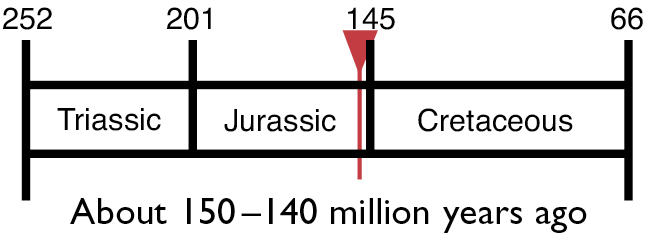

FUN FACTS: The only known skeleton of Elaphrosaurus on display is mounted with a skull based on that of a Velociraptor.
LOCATION: Tanzania, possibly western North America
FOOD: Small reptiles, including smaller dinosaurs
SIZE: Almost 20.5 feet (6.2 m) long, 5 feet (1.5 m) high at the hips
WEIGHT: About 460 lbs (210 kg)
TRIVIA: Based on the proportions of its very long legs, paleontologists think that Elaphrosaurus may have been the fastest dinosaur of the Jurassic Period.
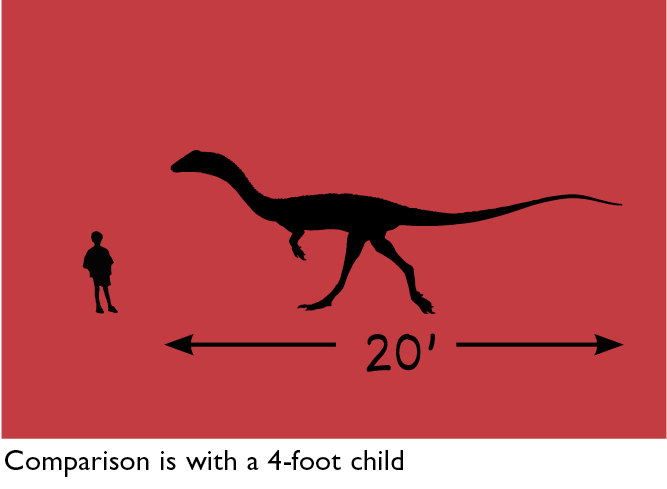



Eoraptor (“dawn hunter”) is the most primitive known dinosaur, and for paleontologists it serves as a model for what the very first dinosaur probably looked like.
Before Eoraptor was found, scientists looked at the oldest and most primitive members of each of the major groups of dinosaurs. They saw that most of these were only about 3.3 feet (1 m) long, and that they walked on their back legs. Then, in 1991, Ricardo Martinez found the skeleton of Eoraptor in Argentina. It matched what paleontologists had expected to find in a common ancestor. It was only 3.3 feet (1 m) long, and it walked on its back legs.
Was Eoraptor the ancestor of all dinosaurs?
Unfortunately, no. It lived too late in time. Other, more advanced dinosaurs were found in the same Late Triassic rocks where Eoraptor was found. But paleontologists haven’t given up the search for that very first dinosaur. They are now searching for new fossils in even older rocks.
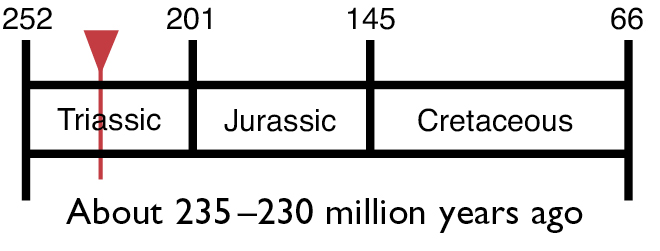

FUN FACTS: Eoraptor was found in the Valley of the Moon.
LOCATION: Argentina
FOOD: Small reptiles and mammals, plants
SIZE: 3.3 feet (1 m) long, 15 inches (39 cm) high at the hips
WEIGHT: About 9.5 lbs (4.3 kg)
TRIVIA: When the thighbone of Eoraptor was first found, paleontologists at first thought it was a little crocodile relative. They realized that it was a dinosaur when the rest of the skeleton was dug up.
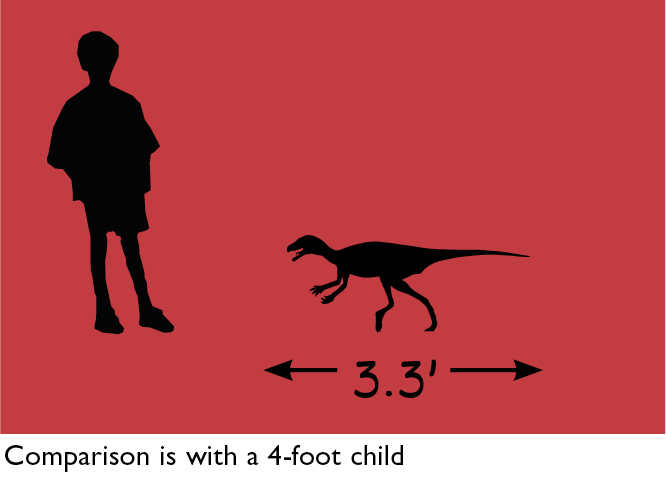



Gallimimus (“chicken mimic”) is one of the largest of the ornithomimosaurs (or “bird mimics”). Ornithomimosaurs are often called “ostrich dinosaurs” because they are shaped very similar to modern flightless birds.
Ostrich dinosaurs were compact, with long arms and legs. The arms ended in long hands with hook-like fingers all curling in the same direction. Their feet were long, narrow, and compact, and had a special shock-absorbing shape that let them run very fast. In fact, ostrich dinosaurs were probably the fastest dinosaurs of the Cretaceous Period. This would have been useful, since both raptors and tyrant dinosaurs hunted in the places where Gallimimus and its relatives lived!
Although Pelecanimimus and other early ostrich dinosaurs had teeth in their jaws, Gallimimus and its relatives were totally toothless. Their beaked heads had large eyes and were at the end of long, slender necks.
Some paleontologists think that ostrich dinosaurs ate only meat, although without good grasping hands or strong jaws they could kill only smaller animals. Others think that they were plant-eaters. Many suspect that like the modern ostrich, they ate small animals and plants.
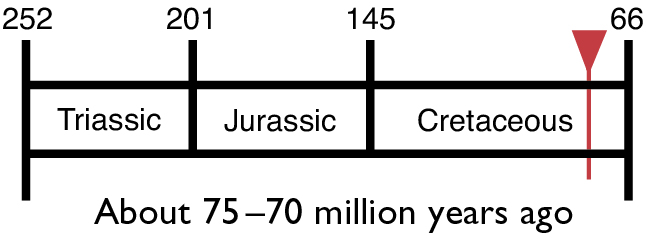

FUN FACTS: Gallimimus was not the largest of all the ostrich dinosaurs. Deinocheirus from Mongolia was nearly as big as T. rex.
LOCATION: Mongolia
FOOD: Possibly small mammals and reptiles, plants, insects
SIZE: 20 feet (6 m) long, 6.3 feet (1.9 m) high at the hips
WEIGHT: 968 lbs (440 kg)
TRIVIA: Paleontologists have not found skeletons of different Gallimimus together, but there was a discovery that an earlier related Mongolian dinosaur did live in flocks.




Gargoyleosaurus (“gargoyle lizard”) is one of the rarest of the armored dinosaurs. It is from the Jurassic Period, not the Cretaceous like most ankylosaurs. It has many primitive features. For example, in most ankylosaurs, the upper part of the beak has no teeth. The more teeth present in the beak, the more primitive the dinosaur. Gargoyleosaurus has seven teeth, more than in any other ankylosaur. Most ankylosaurs also have a set of large, folded nasal air passages. In Gargoyleosaurus, the small nasal air passage is straight. The most highly armored ankylosaurs have solid plates of bone (armor) on the outside of the body. In Gargoyleosaurus, they are hollow.
Ankylosaurs and stegosaurs are classified together in a larger group called the Thyreophora, or “armored dinosaurs.” They share the common feature known as “dermal armor,” or armor that grows out of the skin.


FUN FACTS: The armor of Gargoyleosaurus looks amazingly like the painted and spiked fans at an Oakland Raiders football game!
LOCATION: Wyoming
FOOD: Conifers, cycads, ginkgos
SIZE: 10 feet (3 m) long, 3.3 feet (1 m) high at the hips
WEIGHT: 1 ton
FRIENDS: Stegosaurus, Othnielosaurus, Mymoorapelta
ENEMIES: Ornitholestes, Torvosaurus
TRIVIA: The first Gargoyleosaurus skull and skeleton on display are in the Denver Museum of Natural History.
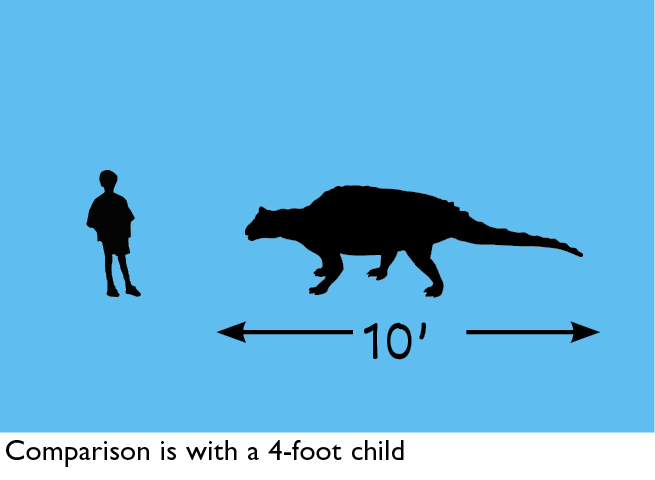

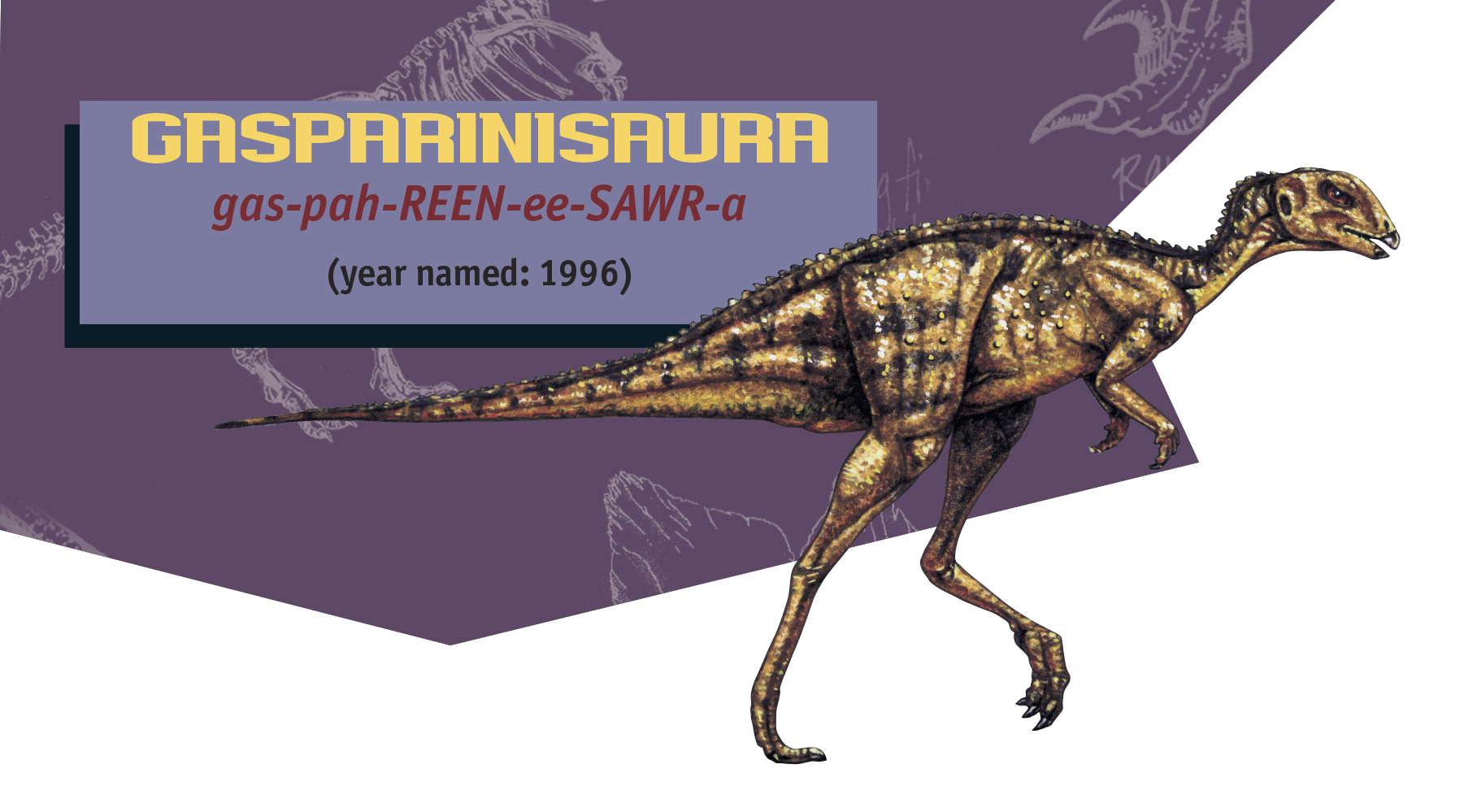

Gasparinisaura (“[Dr. Zulma B.] Gasparini’s lizard”) is one of the rare ornithopods, or beaked dinosaurs, from the middle of the Cretaceous Period. Remains of dinosaurs from this time span are so extremely rare, all the specimens in the world would fit in one small exhibit hall!
Gasparinisaura is also one of those rare small dinosaurs that had a primitive body design. The features of its skeleton place it with the dryosaurs, from the Jurassic Period, but Gasparinisaura lived well into the Cretaceous Period—a time when the hadrosaurs, the most evolved of the ornithopods, had already appeared. Many features of the skull are primitive: for example, the teeth with low crowns (not much showing above the gum line) and the shortened face (later ornithopods have a long muzzle). Normally, the skull evolves faster than the body bones. But in Gasparinisaura, the reverse has occurred. The hip bone is more like that of the later hadrosaurs. This indicates a dinosaur with a well-developed hip musculature.
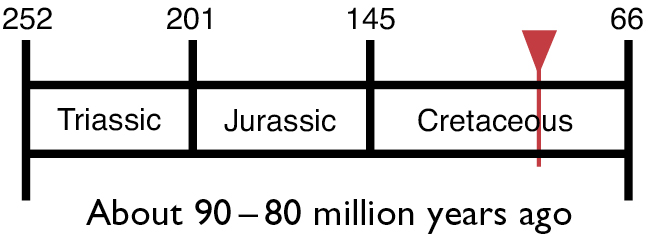

FUN FACTS: Ornithopods are very common in North America, but they are extremely rare in South America, where the sauropods were the main herbivores.
LOCATION: Patagonia, Argentina
FOOD: Conifers, cycads, ginkgos, possibly early weedlike flowering plants
SIZE: 2.5 feet (.8 m) long, 1 foot (.3 m) high at the hips
WEIGHT: 75 lbs (34 kg)
TRIVIA: The scientists who are studying the very small Gasparinisaura are the same scientists at work on the very large Giganotosaurus.
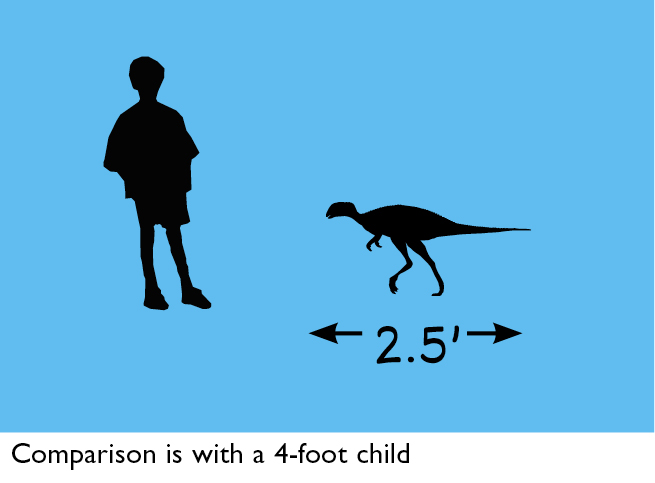



Gastonia (“[Robert] Gaston’s lizard”) is a small, armored dinosaur with large, curved spikes projecting out of its back and along both sides of its body. The tail has sideways-aiming spikes along the sides. Gastonia was one of the most highly ornamented of all the ankylosaurs, or tank dinosaurs. Although it has an armored shield over the pelvis like the polacanthid ankylosaurs of Europe, it also has spiked armor, more like the nodosaurid ankylosaurs of North America.
Gastonia shares one major feature with most other later ankylosaurs. It has very short, powerful legs. This means that Gastonia could not outrun a predator but would stand and fight (which explains the fancy armor). Since Gastonia had spikes from the shoulder to the tip of the tail, plus a large shield of bone over the hips, there was no good place for a meat-eater to take a bite!
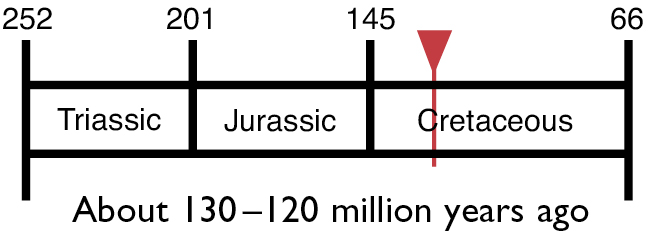

FUN FACTS: The original specimen is in the collections at the College of Eastern Utah in Price, Utah.
LOCATION: Utah
FOOD: Conifers, cycads, ginkgos
SIZE: 20 feet (6 m) long, almost 6.6 feet (2 m) high at the hips
WEIGHT: 1.5 tons
FRIENDS: Other small ankylosaurs
ENEMIES: Utahraptor
TRIVIA: The species name (Gastonia burgei) honors Don Burge, a dinosaur hunter from Utah.
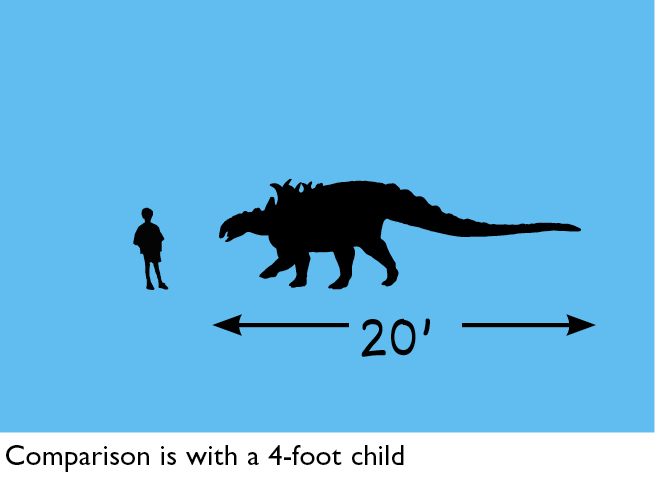



Giganotosaurus (“giant southern lizard”) is one of the largest known meat-eating dinosaurs ever. For many years Tyrannosaurus held that record (although bits and pieces of Carcharodontosaurus and Spinosaurus showed that they were as large as any individual T. rex). Then, in 1995, paleontologists Rodolfo Coria and Leonardo Salgado reported the discovery of a new meat-eater at least as large as the biggest T. rex.
They named this dinosaur Giganotosaurus. The skull alone was 6 feet (1.8 m) long! What’s more, a lower jawbone was later found from an individual even bigger than the first one—with a skull perhaps 6.5 feet (2 m) long. Clearly, Giganotosaurus was a gigantic dinosaur.
When Giganotosaurus was alive, the most common plant-eaters in South America were the titanosaur sauropods. While a single Giganotosaurus could kill a young titanosaur, it would take many Giganotosaurus to bring down a giant adult. At present, there is no evidence that Giganotosaurus hunted in groups, but a recent discovery from slightly younger rocks shows that the as-yet-unnamed descendant of Giganotosaurus may have lived in packs.
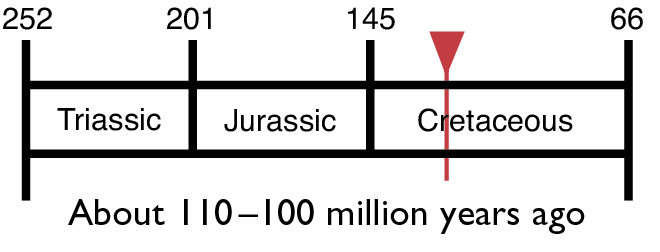

FUN FACTS: A cast of the skeleton of Giganotosaurus is on display at the Academy of Natural Sciences in Philadelphia.
LOCATION: Argentina
FOOD: Titanosaurs and other sauropods
SIZE: Almost 43 feet (13 m) long, 13 feet (3.9 m) high at the hips
WEIGHT: About 8 tons
TRIVIA: Giganotosaurus might be the dinosaur whose name is most often misspelled and/or mispronounced. People often call it Gigantosaurus (with only one “o”) instead of the proper Giganotosaurus, with two. The name Gigantosaurus was actually given to bits and pieces of a British long-necked sauropod dinosaur back in 1869.
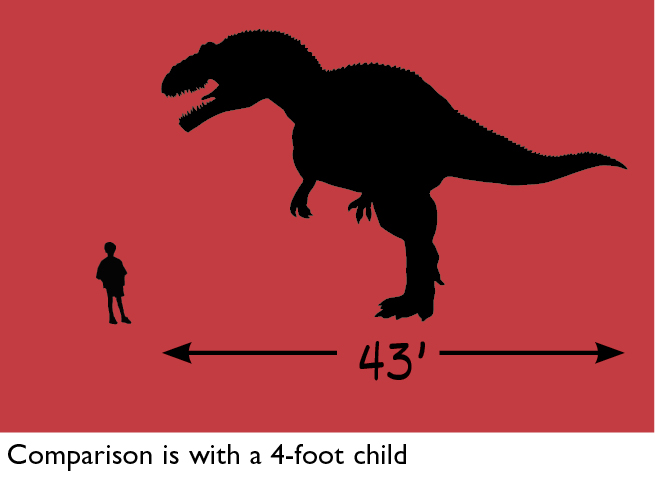



Gorgosaurus (“fierce lizard”) was a tyrannosaur, or tyrant dinosaur. It was a very close relative of Tyrannosaurus—although Gorgosaurus was a little smaller and lived somewhat earlier.
The tyrant dinosaurs were very specialized meat-eaters. Their arms were extremely short, and they had only two fingers (the thumb and the index finger). The arms of Gorgosaurus—like those of Tyrannosaurus—were so short they couldn’t even reach its mouth!
Tyrant dinosaurs’ legs were long and slender, and their narrow, compact feet had a special shock-absorbing shape. A young Gorgosaurus was probably as fast as an ostrich dinosaur, and even an adult was probably faster than any of the duckbills and horned dinosaurs it hunted. Although its arms would be useless in catching prey, it could use its powerful jaws, filled with many strong teeth, to grab its victims. Tyrant dinosaurs’ teeth, unlike those of most theropods, or meat- eating dinosaurs, were not shaped like blades. Instead, they were thick and round in cross-section. This meant that the teeth could be used to hold and grip tighter, and maybe even to crush bone.
When tyrant dinosaurs were around, they were the largest predators in their environment. The only meat-eater a Gorgosaurus had to fear was another Gorgosaurus, or the even larger tyrant dinosaur Daspletosaurus, which lived at the same time. Of course, Gorgosaurus would have to be careful when attacking a Centrosaurus or other horned dinosaur. Although these ceratopsians ate plants, they could still defend themselves with their deadly horns.


FUN FACTS: Gorgosaurus was once considered a species of Albertosaurus, which is really a different (but closely related) tyrant dinosaur from later in the Cretaceous.
LOCATION: Alberta, Canada
FOOD: Centrosaurus, Styracosaurus, Lambeosaurus, Corythosaurus, Euoplocephalus, Edmontonia
SIZE: Over 28 feet (8.6 m) long, 9.3 feet (2.8 m) high at the hips
WEIGHT: 2.5 tons
FRIENDS: None
ENEMIES: Daspletosaurus
TRIVIA: Almost every dinosaur labeled “Albertosaurus” in a museum is really a Gorgosaurus!
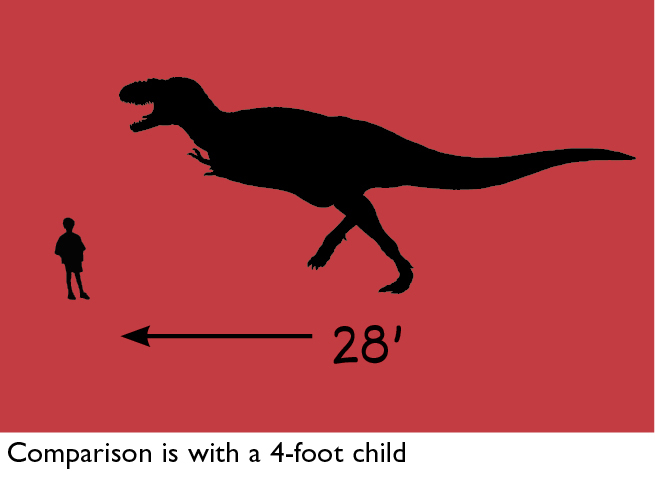

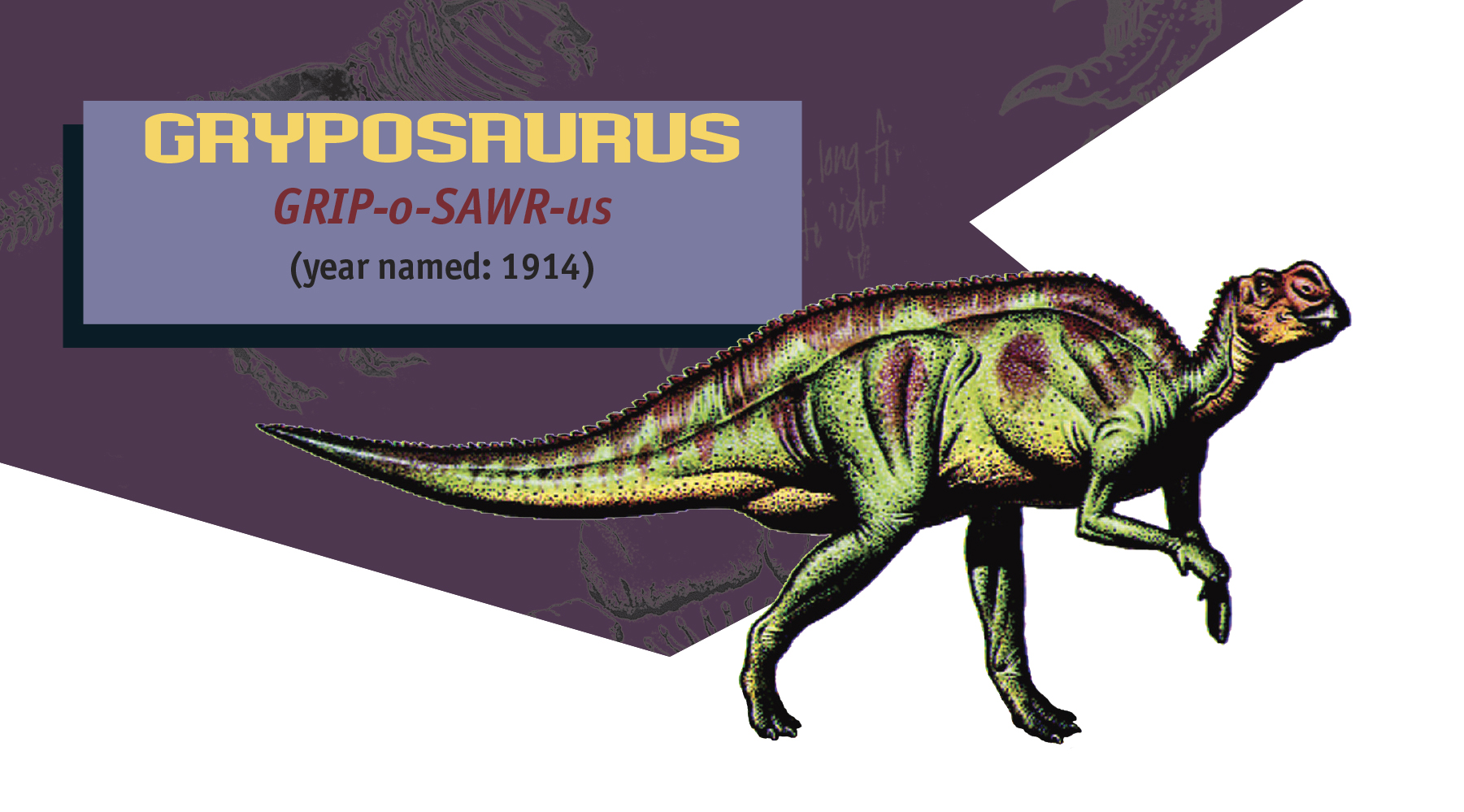

Gryposaurus (“hook-nosed lizard”) is a duckbill dinosaur known from several complete skeletons and skulls. Nevertheless, its relationship with other duckbills is shrouded in mystery. In the 1850s, a partial duckbill was discover in New Jersey. It was named Hadrosaurus. In 1910, another, more complete duckbill was found in New Mexico. It was named Kritosaurus. Although Hadrosaurus lacked a skull, the body looked just like Kritosaurus. Then in 1914, the first complete duckbill was found in Alberta, Canada. It had an excellent skull and was named Gryposaurus.
Some scientists considered Gryposaurus and Kritosaurus to be the same creature. Priority went to the name Kritosaurus because it was named first.
Enter Jack Horner in the early 1990s. Horner believed that only Gryposaurus was complete enough to have a valid name, and he confined the name Kritosaurus to the skeleton in New Mexico.


FUN FACTS: Gryposaurus belongs to the “Roman-nose” group of hadrosaurs (duckbills).
LOCATION: Montana, Utah, Canada
FOOD: Flowering plants like magnolias and cycads
SIZE: 28 feet (8.4 m) long, 7 feet (2.1 m) high at the hips
WEIGHT: 3.5 tons
TRIVIA: When a new duckbill was found in the mid-1990s in Argentina, it was classified as a Kritosaurus!
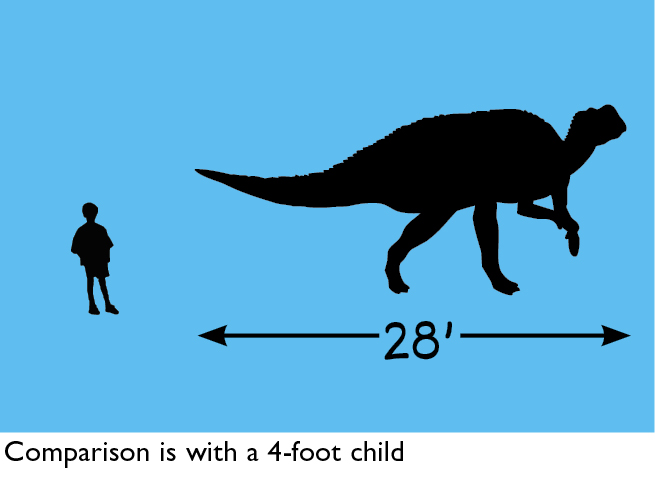



Hadrosaurus (“sturdy lizard”) was—in the 1860s—the first dinosaur skeleton to be exhibited in North America. Its skeleton proved the theory that some dinosaurs walked on two legs, and not on all fours, as scientists of the time had thought. This dinosaur is poorly known because, to date, no skull has ever been found for it and no new skeletons have been found.
Older books may show you a head on this dinosaur, but those drawings are a guess on the part of the illustrators. At one time, scientists believed they had found the skull of Hadrosaurus, but it turned out to be the skull of another duckbill dinosaur, its closest relative, called Gryposaurus.
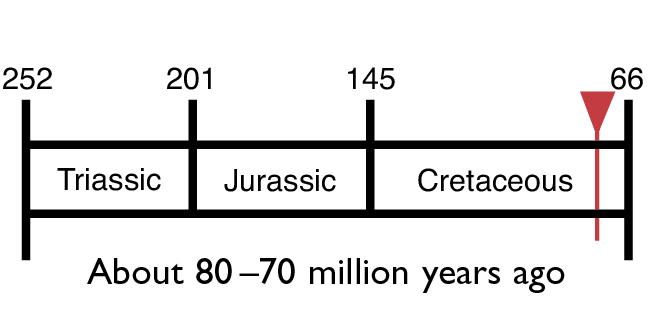

FUN FACTS: Hadrosaurus has its own website: levins.com/dinosaur.html
LOCATION: New Jersey
FOOD: Flowering plants, conifers, cycads, ginkgos
SIZE: 26 feet (8 m) long, about 6.6 feet (2 m) high at the hips
WEIGHT: 3 tons
FRIENDS: Other duckbills and ceratopsians, or horned dinosaurs
ENEMIES: Theropods, or meat-eaters, of any size
TRIVIA: The only Hadrosaurus specimen on exhibit in the world is at the Academy of Natural Sciences in Philadelphia.




Herrerasaurus (“[Victorino] Herrera’s lizard”) was one of the oldest and most primitive theropods, or meat-eating dinosaurs. And its body displayed many of the same features of the later theropods. It walked on its two hind legs, and its arms ended in powerful clawed hands for grasping prey. Its teeth—like those of most theropods—were shaped like blades and had knife-like serrations running up the front and down the back. Its lower jaw had a special hinge about half-way along its length. This joint would have helped Herrerasaurus to better hold on to struggling victims. Many later theropods also had this hinge.
Although Herrerasaurus shared the basic body design of future rulers of the Earth (like Allosaurus, Giganotosaurus, and Tyrannosaurus), it lived at a time when dinosaurs were not the most powerful predators. Herrerasaurus would have had to run away from the much larger Saurosuchus, a giant land-dwelling crocodile relative, which was the largest meat-eater in Argentina during the beginning of the Age of Dinosaurs.
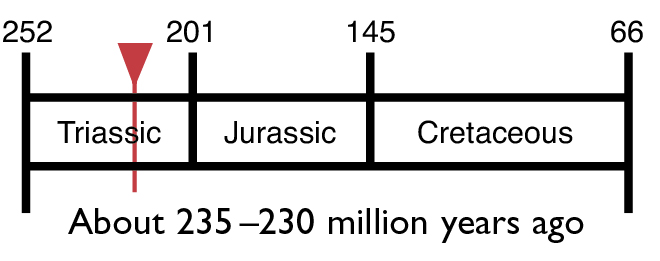

FUN FACTS: One of the most complete mounted skeletons of Herrerasaurus can be seen at the Field Museum of Natural History in Chicago.
LOCATION: Argentina
FOOD: Eoraptor and prosauropods, and primitive bird-hipped dinosaurs
SIZE: Almost 13 feet (3.9 m) long, 4 feet (1.1 m) high at the hips
WEIGHT: 460 lbs (210 kg)
FRIENDS: None
ENEMIES: Saurosuchus (a giant crocodile relative)
TRIVIA: Before the first skull was discovered in 1988, Herrerasaurus was thought to be a prosauropod, an early form of the giant long-necked plant-eaters, like Plateosaurus.
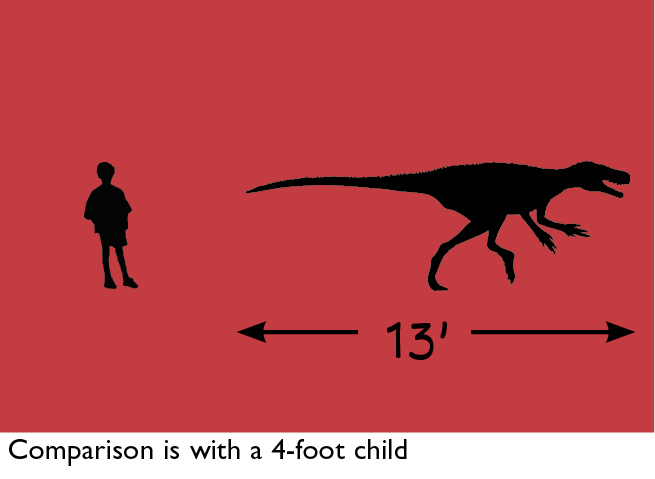

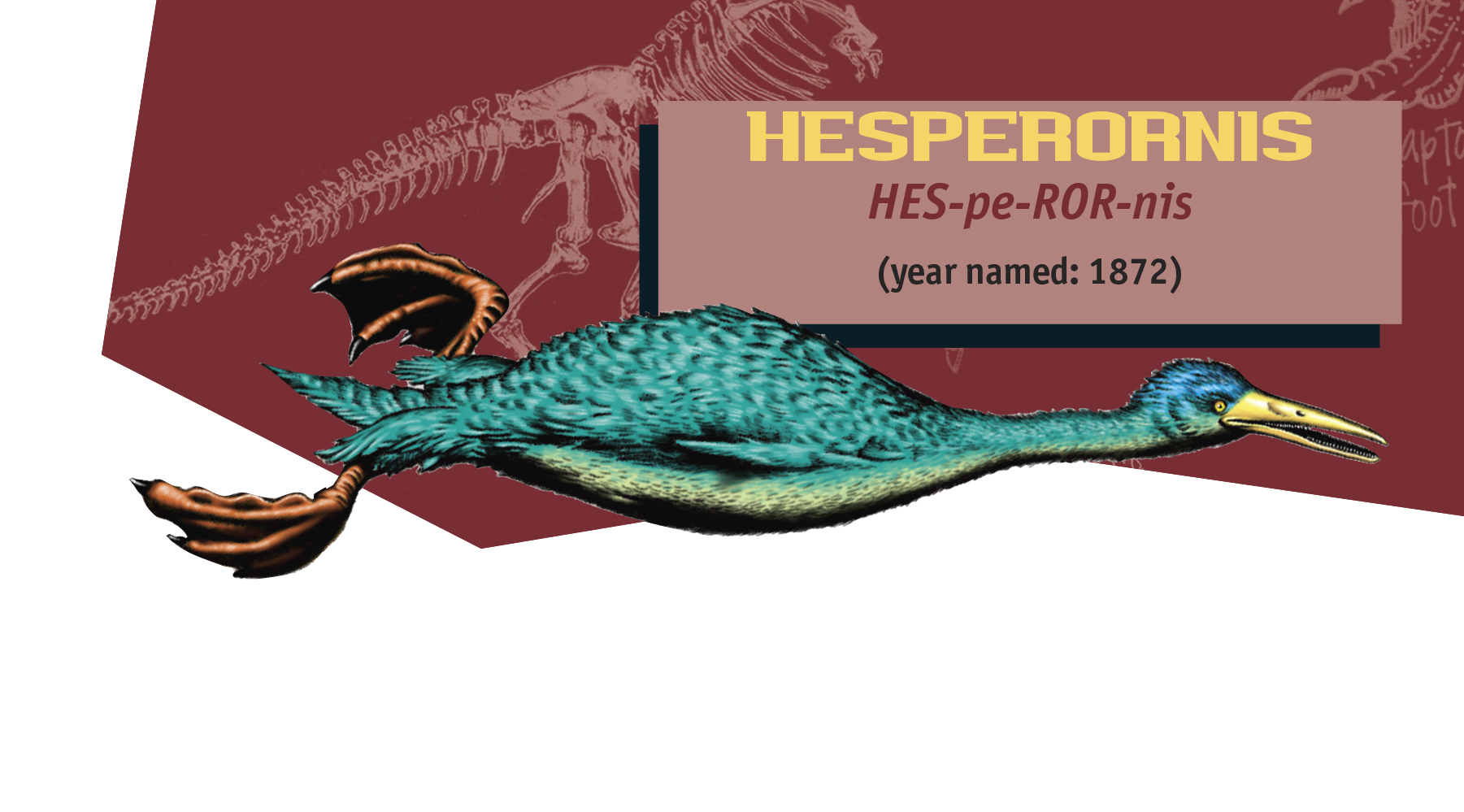

Hesperornis (“western bird”) was a flightless swimming bird with teeth. This may sound like a strange combination, but it is less weird than it seems. After all, there are flightless swimming birds today, such as the various species of penguin or the flightless cormorant of the Galápagos Islands.
Birds and raptors are closely related to each other, and both types of dinosaurs diverged from a common ancestor during the Jurassic. Birds evolved the ability to fly, and most birds of the Cretaceous were fliers. The ancestors of Hesperornis, however, became swimmers that chased fish. As time went by, the wings of this group of birds became shorter and shorter, until nothing remained of each wing but a simple spike. Hesperornis swam by using its feet to push itself quickly through the water, chasing after fish and squid. Its legs were so far back on its body that it probably had problems moving on land. However, like modern penguins, Hesperornis almost certainly came up onto land to lay its eggs.


FUN FACTS: During the Late Cretaceous, most of the middle of North America was covered by a shallow tropical sea. You could have taken a boat and sailed from the Gulf of Mexico to the Arctic Ocean over lands that are now prairies!
LOCATION: Kansas, Canada
FOOD: Fish, squid
SIZE: About 5 feet (1.5 m) long
WEIGHT: About 132 lbs (60 kg)
TRIVIA: Because birds are now classified as a kind of dinosaur, Hesperornis is technically a swimming dinosaur. Therefore, older books that say no dinosaurs lived in the sea are incorrect.
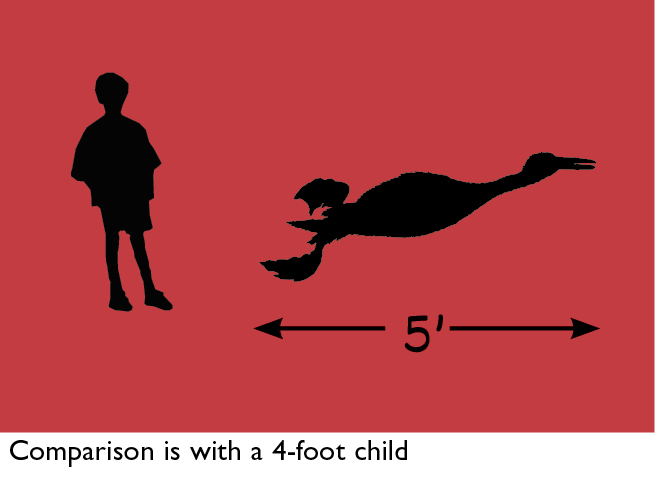



Heterodontosaurus (“different-tooth lizard”) was a small, fast dinosaur with strong, grasping hands, long arms, and a powerful bite. These features are, for the most part, unnecessary in a plant-eater. It does not take speed, agility, and dexterity to overpower a leaf! Heterodontosaurus’s most notable feature, however, is the set of “fangs” at the front of its mouth. It is quite unusual for a plant-eating dinosaur to have teeth like this, which you’d normally expect in a meat-eater.
We know of only one other Early Jurassic group of dinosaurs—the prosauropods—where some of its members had teeth structurally intermediate between those of meat-eaters and of plant-eaters. The same may be true here. Heterodontosaurus and prosauropods both might be examples of the transition from meat-eater to plant-eater.
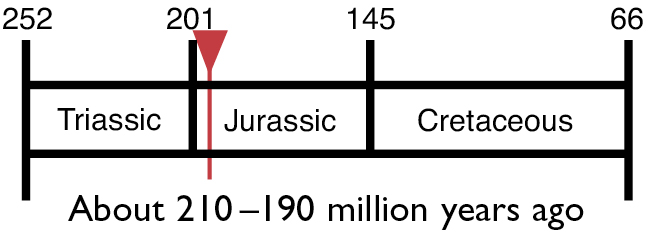

FUN FACTS: This small dinosaur could have outrun a ten-year-old human.
LOCATION: Cape Province, South Africa
FOOD: Conifers, cycads, ginkgos, possibly insects
SIZE: Just over 3.3 feet (1 m) long and about 19 inches (less than .5 m) high at the hips
WEIGHT: 100 lbs (45 kg)
FRIENDS: Other early ornithopods
ENEMIES: Juvenile theropods, crocodiles
TRIVIA: Its close relative, Tianyulong, was the first bird-hipped dinosaur found with body fuzz.




Homalocephale (“even-headed lizard”) and Prenocephale (“inclined head”) are representatives of the Pachycephalosauria, or thick-headed dinosaurs, the last of the seven major groups of dinosaurs to appear, and the rarest. Some scientists divide pachycephalosaurs into two groups: flat heads and big-dome heads. Homalocephale is a flat head, and Prenocephale is a big-dome head. Other scientists consider Homalocephale to be the young form of Prenocephale. In all cases, the skull and dome are composed of the same skull bones that are found in humans (the frontal and parietal bones). The edge of the pachycephalosaur’s dome may include bumps, knobs, and, in some forms, spikes. Early pachycephalosaurs had small domes, which got progressively bigger over time. The largest dome can be found in Pachy-cephalosaurus.
Both dinosaurs are known from unusually complete skeletons. They were found in Mongolia—in an area supposedly barren of fossils!
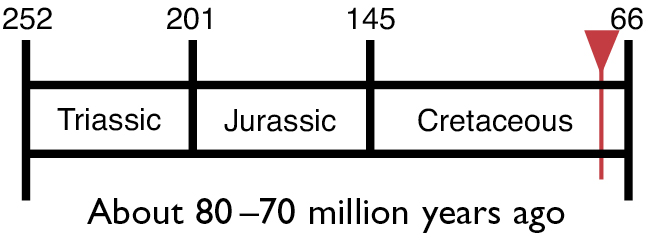

FUN FACTS: Some paleontologists think Homalocephale is just a young Prenocephale.
LOCATION: Mongolia
FOOD: Plants
SIZE: About 5 feet (over 1 m) long and 3 feet (less than 1 m) high at the hips
WEIGHT: 350 lbs (159 kg)
TRIVIA: You can read an account of the amazing expedition that uncovered the fossils of these dinosaurs in Hunting for Dinosaurs by Zofia Kielan-Jaworowska.


Iguanodon (“iguana tooth”) was the first really huge ornithopod, or two-legged plant-eating dinosaur. The arms were longer than an adult human’s, and all the bones of the skeleton were thick. This was a very powerful dinosaur that could defend itself quite well. Its massive arms ended in large hands that carried “thumb spikes.” These were the perfect weapons to put out the eye of an attacking theropod.
Iguanodon is one of the original three members of the group Dinosauria. When Richard Owen coined the word dinosaur in 1842, he defined it to mean “fearfully great, a lizard.” He based the name on three dinosaurs—Megalosaurus, Iguanodon, and Hylaeosaurus. The story of the discovery and naming of Iguanodon has been the subject of several books. No other two-footed plant-eater is as historically famous. One reason for this was a spectacular find in Bernissart, Belgium, in 1878. Workers in a coal mine found over a dozen well-preserved skeletons at a depth of over 1,000 feet (300 m).


FUN FACTS: Most Iguanodon skeletons are exhibited in the “old style,” with the tail dragging on the ground. We now know that dinosaurs did not drag their tails.
LOCATION: Western Europe, mostly England and Belgium
FOOD: Conifers, cycads, ginkgos
SIZE: About 35 feet (11 m) long, 9 feet (2.7 m) high at the hips
WEIGHT: 5 tons
TRIVIA: The owners of the coal mine in Belgium shut it down for two years so that scientists could excavate the bones—a very rare case of cooperation between scientists and corporate land owners!
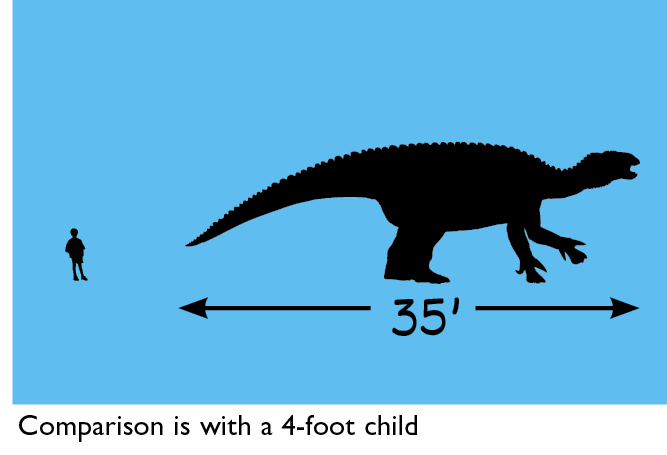

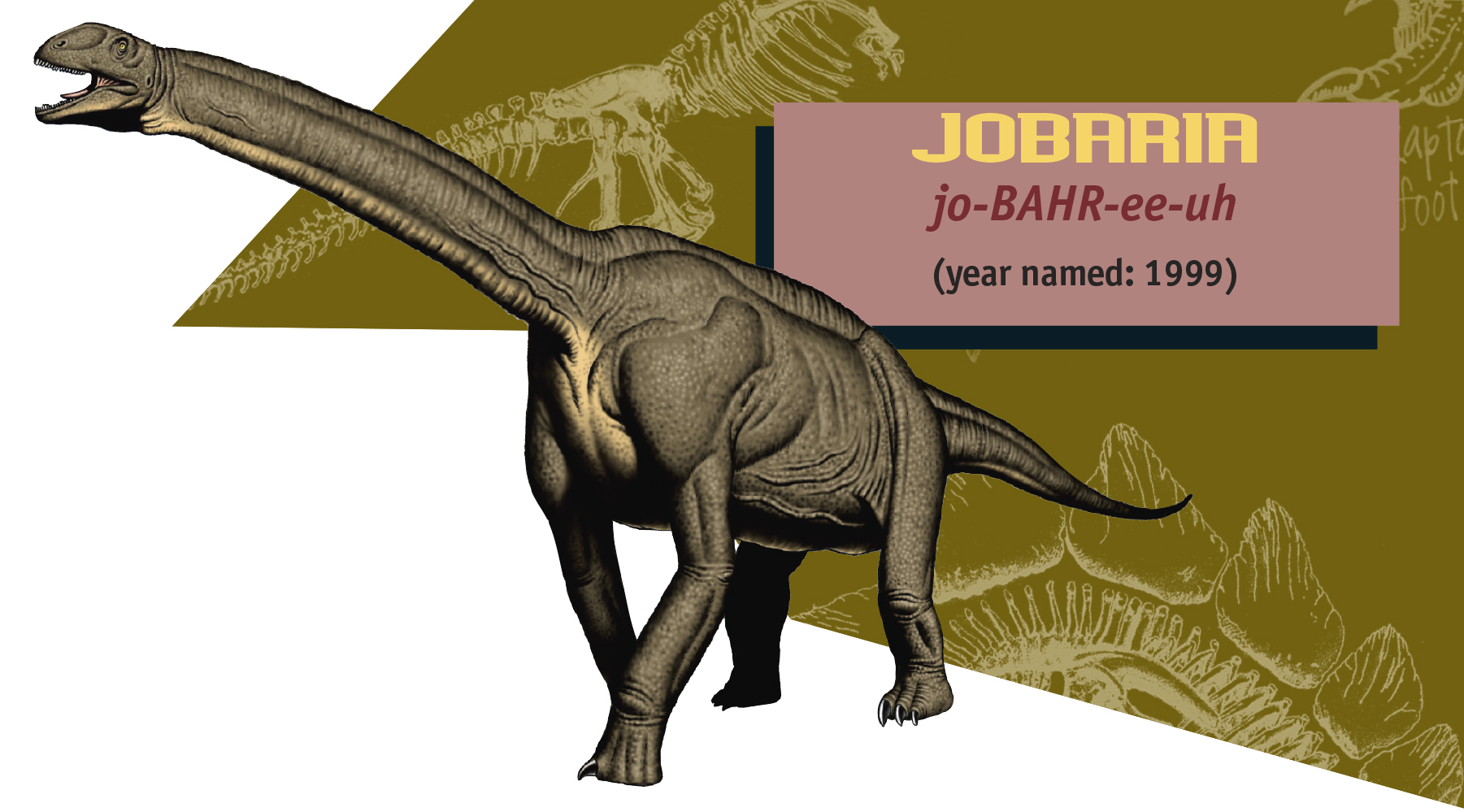

Jobaria (after a creature from Tuareg mythology) is a unique sauropod, or large long-necked dinosaur. It has thick, heavy legs and a very wide stance. Its teeth are thick and heavy, too. Jobaria’s neck is short, and so is the tail. This is a very powerful dinosaur. It fed mostly on the leaves of trees, so it had to be big enough to reach them, and big enough to support its own weight. Jobaria also had to fight off Afrovenator (the “Allosaurus” of this time) with its thumb claw!
Jobaria was found in 1997 but not named until 1999. Skeletons of several other specimens of Jobaria were unearthed at the same time, so it took years for the material to be prepared. Without the help of laboratory technicians who prepare the bones, scientists would need decades to describe and prepare new finds by themselves.
Imagine finding a dinosaur in the field. It has over 200 bones, many up to 6 feet (1.8 m) long and weighing several hundred pounds. You are working in a desert. The daily temperature is over 100 degrees, and the wind blasts sand in your face, clothes, and food. The nearest English-speaking country is over 1,000 miles (1,600 km) away! That’s what Paul Sereno and his University of Chicago crew had to deal with while digging in the Sahara Desert for Jobaria.
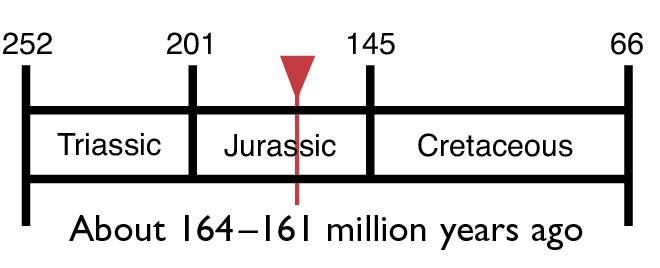

FUN FACTS: Because its leg bones are so strong, Jobaria may have been able to rear up to feed on even higher branches.
LOCATION: Niger
FOOD: Conifers, cycads, ginkgos
SIZE: 70 feet (21 m) long, 15 feet (4.5 m) high at the hips
WEIGHT: 18 tons
FRIENDS: Other sauropods
ENEMIES: Afrovenator
TRIVIA: Casts of Jobaria are on display in Chicago.
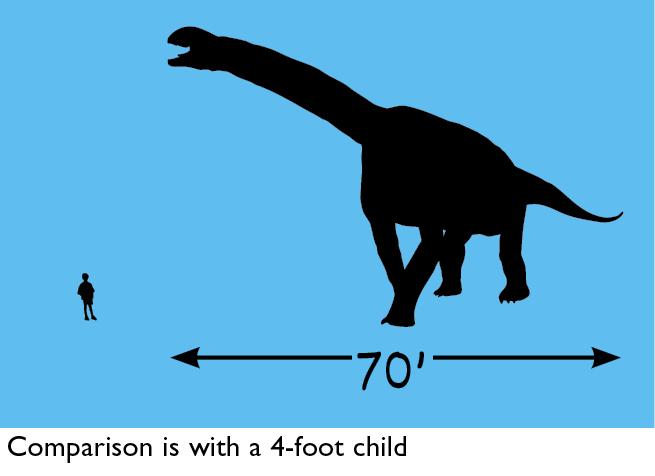



Kentrosaurus (“spiked lizard”) is well named. A member of the Stegosauria, it has large spikes from the middle of its back down to the base of its tail. When compared to the North American Stegosaurus, Kentrosaurus has smaller plates. It appears that spikes evolved first in the Stegosauria, then plates developed from the spikes.
The bases of Kentrosaurus’s tail spikes are large and rounded, showing that they were solidly planted into the skin. This means that the spikes could not be waved independently in the direction of an attacker. There is also another shoulder spike that has been restored at times as facing both forward and backward. A backward-facing spike is more logical, however. With a forward-facing spike, Kentrosaurus might have impaled itself in the neck!


FUN FACTS: The stegosaurs are the second rarest major group of dinosaurs. (The first are the pachycephalosaurs.)
LOCATION: Tanzania
FOOD: Conifers, cycads, ginkgos
SIZE: 18 feet (5.5 m) long, 5 feet (1.5 m) high at the hips
WEIGHT: 1 ton
FRIENDS: Dryosaurus, Tornieria, Dicraeosaurus
ENEMIES: Elaphrosaurus, Veterupristisaurus
TRIVIA: The Humboldt Museum in Germany has the only mounted skeleton on display.
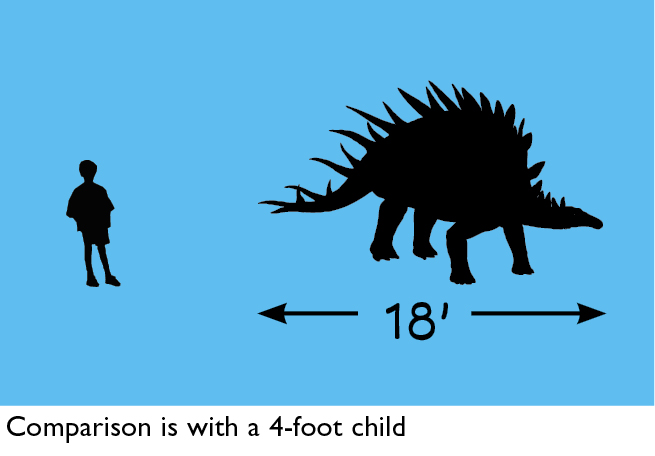



Leptoceratops (“slender horned face”) had a head that was relatively large for its stocky body. This may mean that it never grew big, or that we have only found fossils of juveniles. Leptoceratops had only one defense, its parrot-like beak. The jaws of horned dinosaurs like Leptoceratops were the most powerful for their size of any plant-eater’s. They had enough power, for example, to break the arm of any similar-sized theropod.
Leptoceratops is most similar to the earlier Psittacosaurus and Protoceratops. But Leptoceratops lived over 30 million years later, at the very end of the Age of Dinosaurs in North America. There are two possible explanations for this. The first is that Leptoceratops, or its ancestors, immigrated across the land bridge between Asia and North America at the end of the Cretaceous, but their fossils have so far been found only in North America. The second is that they were an early group of immigrants that survived only in North America, while their Asian ancestors went extinct.
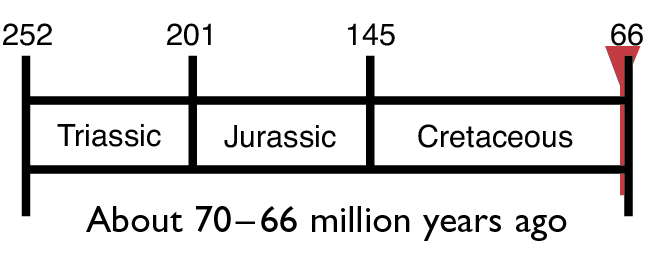

FUN FACTS: Leptoceratops was named by Barnum Brown, the same man who found Tyrannosaurus rex.
LOCATION: Wyoming and Alberta, Canada
FOOD: Ground cover such as cycads and flowering plants
SIZE: 6.6 feet (2 m) long, 2.5 feet (.75 m) high at the hips
WEIGHT: 150 lbs (68 kg)
FRIENDS: Edmontosaurus, Thescelosaurus
ENEMIES: Troodon, juvenile tyrannosaurids
TRIVIA: The best display of Leptoceratops fossils is at the Museum of Nature in Ottawa, Canada.




Majungasaurus (“Majunga lizard”) was, until recently, a very poorly understood dinosaur. Bits and pieces of it have been found since 1896. In 1979, paleontologists described a piece of the top of the head of this dinosaur. Because it was so thick, and was covered by a knob of bone, they thought it was some kind of plant-eating pachycephalosaur.
In 1996, an expedition in Madagascar found the first good Majungasaurus skull. It turned out that the thick dome and knob belonged not to a plant-eating pachycephalosaur but to a meat-eater! In fact, Majungasaurus was a close relative to Abelisaurus and Carnotaurus (who also had thick skull roofs, although not as thick as that of Majungasaurus).
Like Carnotaurus, Majungasaurus had a fairly short skull with small teeth. It probably could not kill extremely large animals but could easily hunt down young ones. Also, like most theropods, or meat-eating dinosaurs, Majungasaurus would almost certainly have scavenged a dinosaur corpse if it found one.


FUN FACTS: The first pieces of Majungasaurus found—some teeth and a jawbone—were thought to be from Megalosaurus.
LOCATION: Madagascar
FOOD: Titanosaurs
SIZE: About 26.4 feet (8 m) long, 7.9 feet (2.4 m) high at the hips
WEIGHT: About 1.9 tons
FRIENDS: Unknown
ENEMIES: Unknown
TRIVIA: For most of the Mesozoic, what is now the island of Madagascar was connected to India.
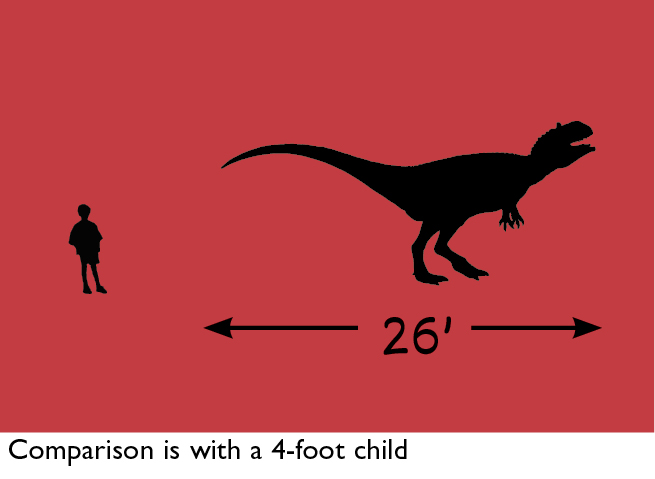



Mamenchisaurus (“lizard from Mamen’s Brook”) is basically a giant neck attached to a small body. The neck is about 40 feet (12 m) long, and the body is about the same length! The purpose of this short, wide body is to act as a stable, heavy base to anchor the neck. At the end of the neck is a short head with thick teeth. Its length allowed Mamenchisaurus to eat the leafy parts at the tops of some Jurassic trees. By doing so, it did not have to compete with its own young, who had to eat plants closer to the ground.
Functionally, this dinosaur could be called a “plant vacuum.” Its super-long neck allowed it to suck up hundreds of pounds of leaves from treetops. Structurally, the neck represents the pinnacle of animal engineering. The vertebrae have hollow portions where there is little internal stress on the bones. This lightens the bones and makes them stronger. Struts and braces give added strength for load bearing. On top of the neck vertebrae are split spines that form a V-shaped trough. Inside this trough lies a series of ligaments that function like the cables on suspension bridges, holding up the neck.
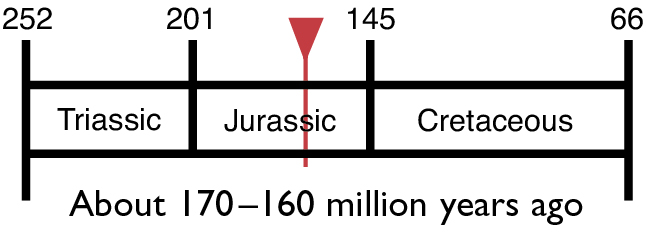

FUN FACTS: This dinosaur had the longest neck in the history of Earth.
LOCATION: China
FOOD: Conifers, cycads, ginkgos
SIZE: About 80 feet (24 m) long, 15 feet (4.5 m) high at the hips
WEIGHT: 20 tons
FRIENDS: Omeisaurus, Tuojiangosaurus, Chungkingosaurus
ENEMIES: Szechuanosaurus, Yangchuanosaurus
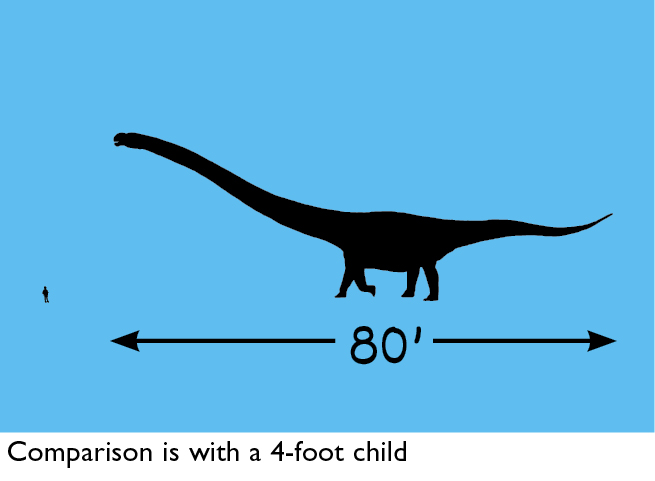



Massospondylus (“bulky vertebra”) is a long, sleek plant-eating dinosaur with a huge claw on each hand. Theropods during the Early Jurassic had not yet reached “super size” (like Allosaurus), so a claw of this type would make an excellent weapon. Plants take a lot more energy to digest than meat, so Massospondylus has a wider pelvis and a larger set of guts in order to process them properly. The neck is longer to get at more food higher up in the trees. Dinosaurs were the first four-legged ground dwellers to be able to feed higher off the ground than sprawling animals. Being able to get at this new food source allowed prosauropods (such as Massospondylus), and then sauropods, to become the dominant plant-eaters for the next 50 million years.
For a long time, prosauropods were considered to be the ancestors of true sauropods because they look like smaller versions of the true sauropods. But there are some problems with this theory. Their foot anatomy is different enough from that of true sauropods to suggest that they are just a side branch that died out.


FUN FACTS: Only the meat-eating theropods had bigger claws than prosauropods.
LOCATION: South Africa, Zimbabwe
FOOD: Conifers, cycads, ginkgos
SIZE: About 19 feet (5.7 m) long, 6 feet (1.8 m) high at the hips
WEIGHT: 1.5 tons
FRIENDS: Heterodontosaurus, Lycorhinus
ENEMIES: Syntarsus
TRIVIA: Massospondylus could be the first dinosaur to claim the nickname “Claws.” The first meat-eaters to have a claw that size did not appear until tens of millions of years later.
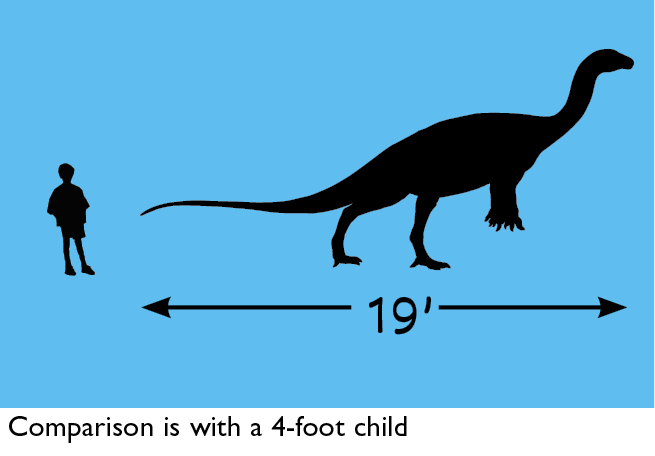



Megalosaurus (“giant lizard”) was the first Mesozoic dinosaur to be named. For centuries, fragments of meat-eating dinosaurs had been found, but scientists thought these came from giant human beings (!) or elephants.
Then around 1815, Reverend William Buckland, a scientist at the University of Oxford, came across the remains of a jawbone with teeth, leg bones, and other parts of a skeleton. The teeth reminded Buckland of those of the monitor lizards, meat-eating lizards of the modern world. But these teeth and bones came from a reptile far larger than any monitor lizard!
In 1822, this new creature was given the name Megalosaurus. Buckland did not call his creature a dinosaur. That word would not be invented until 1842.
No complete Megalosaurus skeleton has yet been found. However, we can compare the bones we have found to more complete theropods and see that Megalosaurus was a two-legged predator with short but powerful arms. It seems to have been the largest meat-eater on land in Europe during the Middle Jurassic Period.
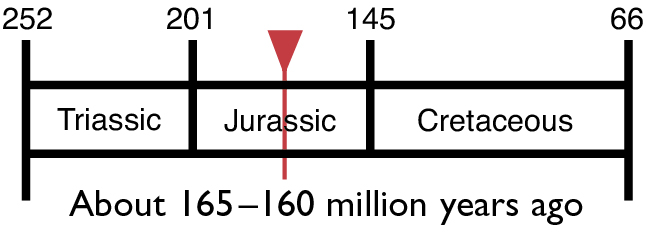

FUN FACTS: The book Bleak House by Charles Dickens (published in 1853) begins with the author imagining a 40-foot-long Megalosaurus “waddling like an elephantine lizard” up a muddy street in London.
LOCATION: England
FOOD: Sauropods, stegosaurs
SIZE: About 25 feet (7.5 m) long, 6.1 feet (1.9 m) high at the hips
WEIGHT: 1.1 ton
TRIVIA: In the early days of paleontology, any meat-eating dinosaur fossils were considered to come from Megalosaurus; however, as more and better skeletons were found, scientists realized how diverse the meat-eating dinosaurs truly were.


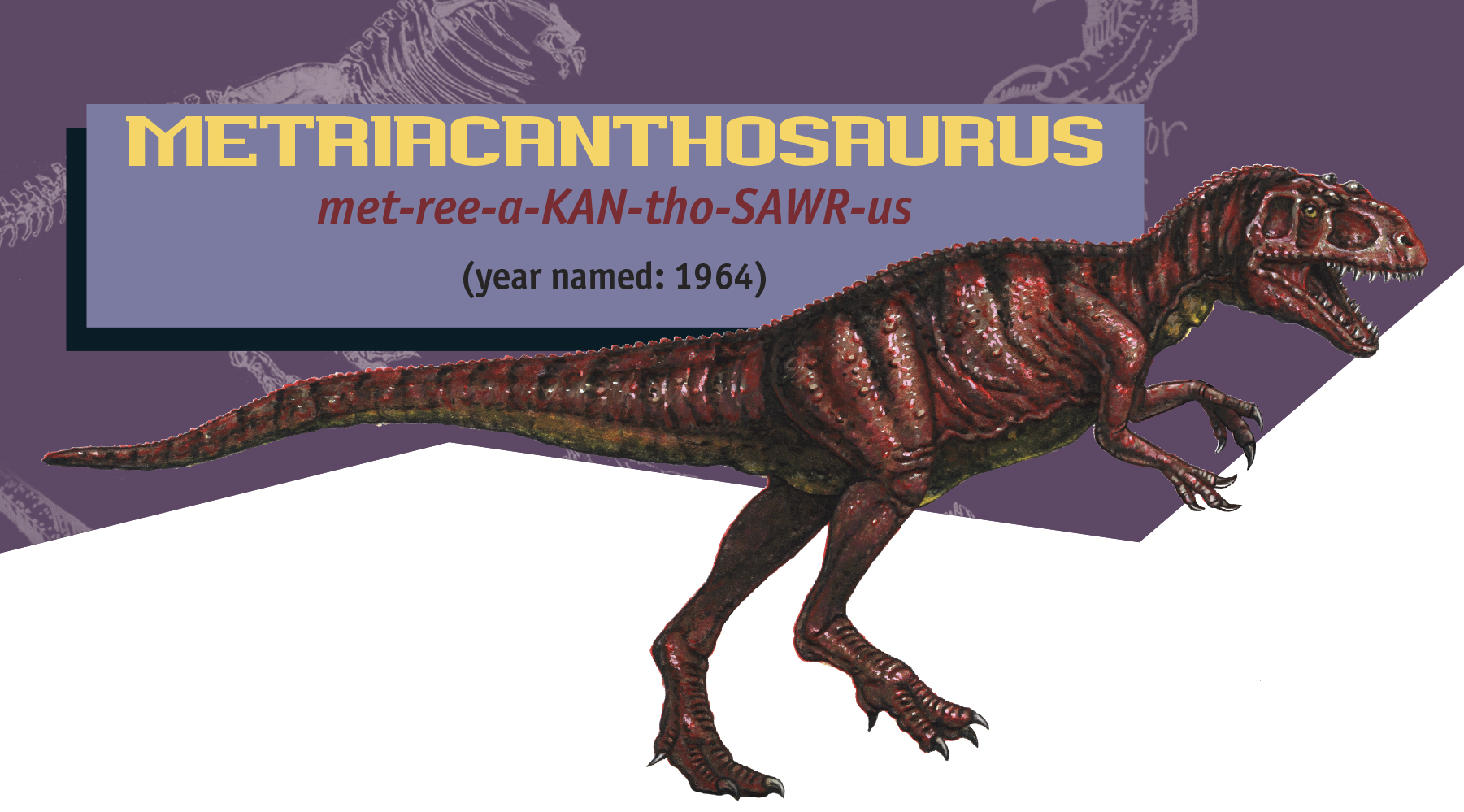

Metriacanthosaurus (“moderate spine lizard”) is one of the many dinosaurs that paleontologists would like to know more about. In 1923, the great German paleontologist Friedrich von Huene wrote a scientific paper describing all the theropod (or meat-eating) dinosaur fossils from the Jurassic and Cretaceous Periods of Europe. In his study, he examined a partial skeleton—an incomplete hip, a leg bone, and part of the backbone. He named it a new species of Megalosaurus. In 1964, however, scientist Alick Walker decided that these bones were too different from those of Megalosaurus and named the dinosaur Metriacanthosaurus.
Because so little is known about this dinosaur, any pictures of it or speculation on its habits are based on comparisons with meat-eating dinosaurs of which we have more complete skeletons. What is known is that this dinosaur was a theropod distinct from all the others. Perhaps someday more complete remains of this dinosaur will be found.


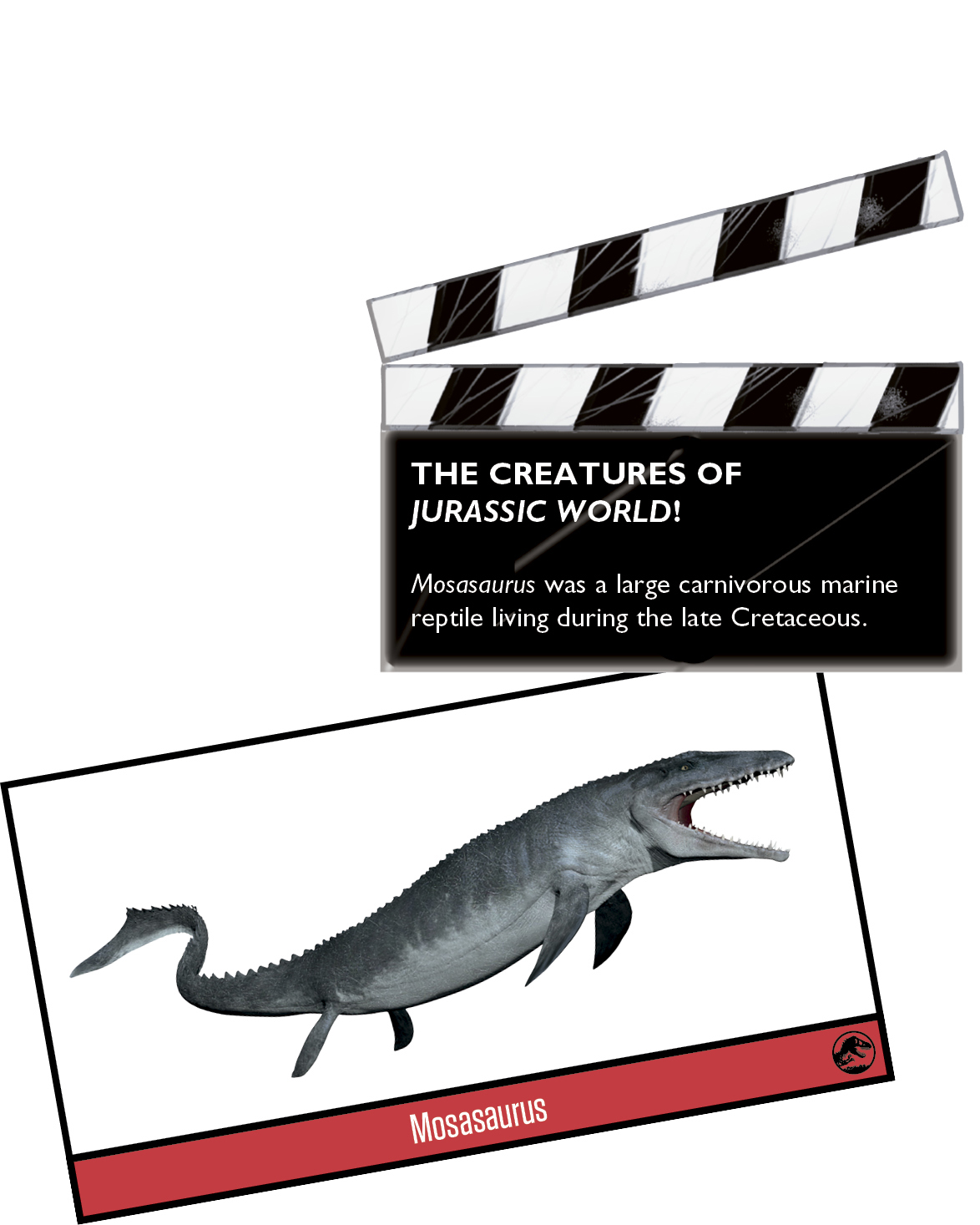

FUN FACTS: Most dinosaurs are known from only one very incomplete fossil, like Metriacanthosaurus.
LOCATION: England
FOOD: Sauropods, stegosaurs
SIZE: Perhaps 23 feet (7 m) long, almost 6 feet (1.8 m) high at the hips
WEIGHT: Maybe 1 ton
TRIVIA: Metriacanthosaurus gets its name from its backbones, which have spines on top that are taller than in many meat-eaters (such as Allosaurus or Tyrannosaurus) but much smaller than those of Spinosaurus.
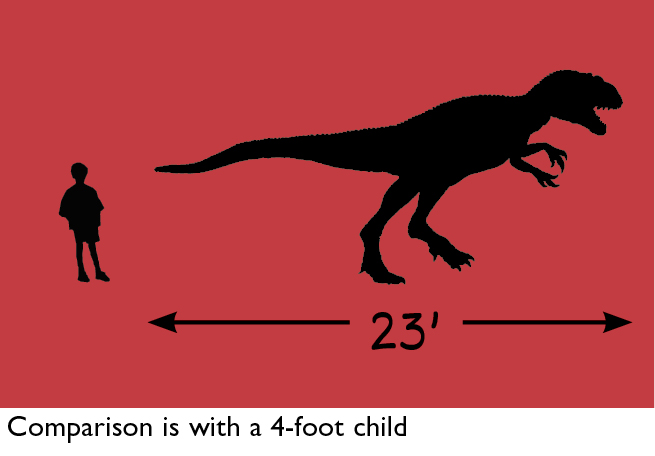



Monolophosaurus (“single-crested lizard”) was the top meat-eating dinosaur in China about the same time that Megalosarus ruled England. In many ways it was a typical medium-sized Jurassic theropod: Its skull was about 2.25 feet (67 cm) long; it stood about 5.75 feet (1.7 m) high at the hips, and its jaws were filled with blade-like teeth for slicing through meat.
The most outstanding feature of Monolophosaurus was its crest. Other meat-eating dinosaurs had crests or horns on their heads, but nothing quite like that of Monolophosaurus. The single fat crest ran from the tip of its nose to just above its eyes. The bones of this crest were hollow, but it was not connected to the windpipe, so it couldn’t be used to make sounds the way that some duckbills could. Instead, this crest was probably hollow so that it didn’t weigh down the dinosaur’s head too much.
What could this crest have been for? Many modern animals have horns or fan tails or other features that are used for display, to show off in order to win mates or defend territory. It seems likely that Monolophosaurus did the same thing with its crest.
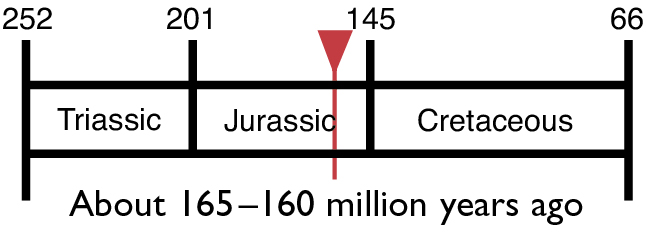

FUN FACTS: Many dinosaur fossils are found by accident. Monolophosaurus, for example, was found by geologists searching for oil deposits.
LOCATION: Xinjiang, China
FOOD: Sauropods, stegosaurs, early ankylosaurs
SIZE: Almost 17 feet (5.1 m) long, 5.6 feet (1.7 m) high at the hips
WEIGHT: 1,870 lbs (850 kg)
TRIVIA: Monolophosaurus’s crest may have been brightly colored, but this is just a speculation. Colors are only very rarely preserved in the fossil record.
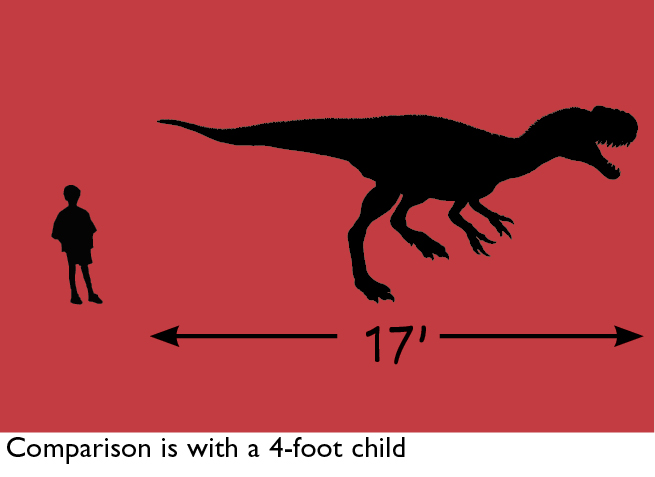

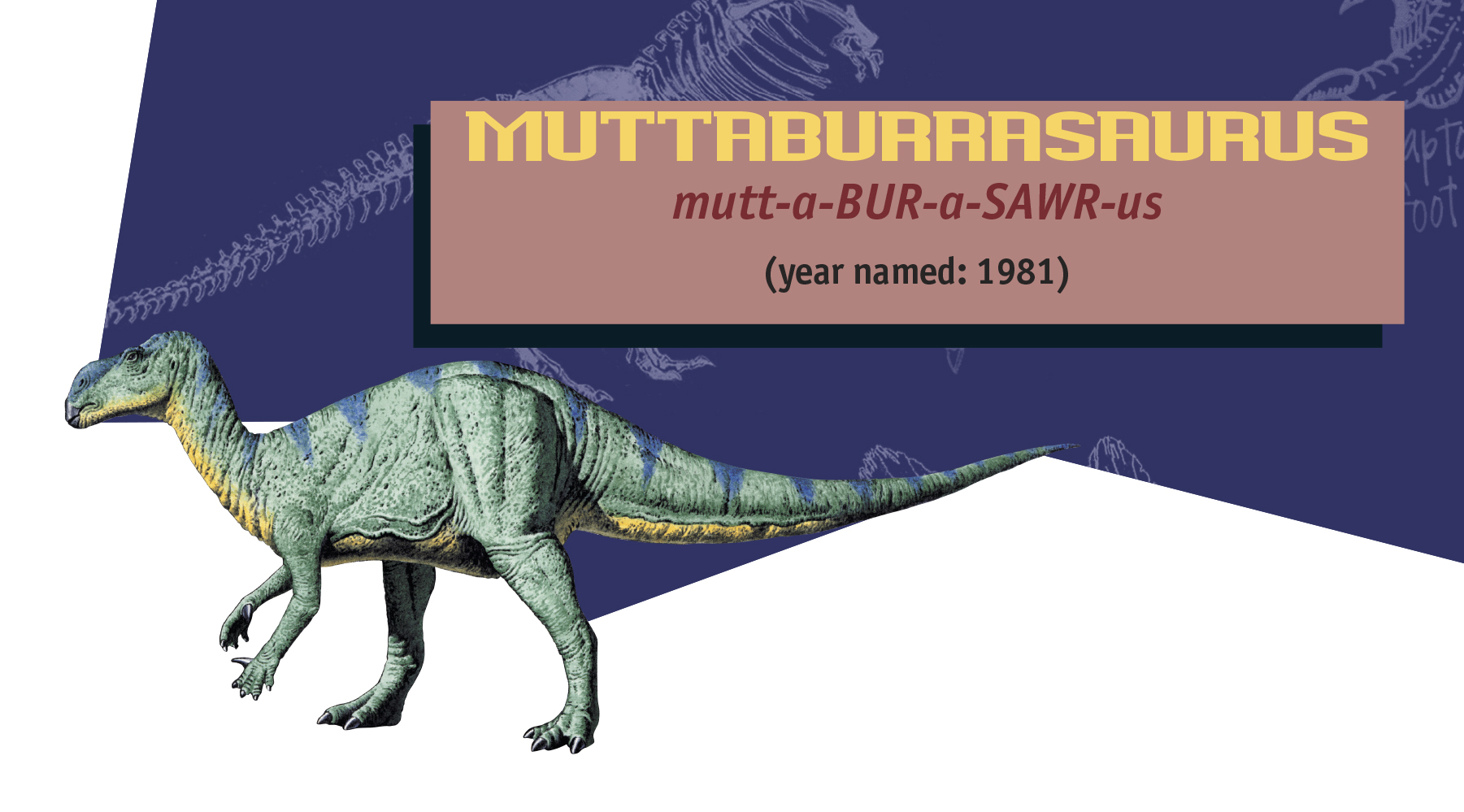

Muttaburrasaurus (“lizard from Muttaburra”) has a stocky, well-muscled body. Although the only mounted skeleton in the world is shown with a thumb spike as big as Iguanodon’s, some scientists question the restoration of this feature. That’s because the original “spike” bone in Muttaburrasaurus is only partially preserved.
One feature Muttaburrasaurus has in common with later ornithopods, or two-legged plant-eating dinosaurs, is its large nose. It is not known if this nose allowed Muttaburrasaurus to communicate, as the hadrosaurs are believed to have done. The nose is closer to the tip of the snout than in hadrosaurs, but it is still large enough to block any stereoscopic vision directly ahead. Humans and predators have stereoscopic vision, which allows them to see in depth. Plant-eating dinosaurs and other prey have non-overlapping fields of vision, which gives them the ability to see more widely but hinders depth perception.
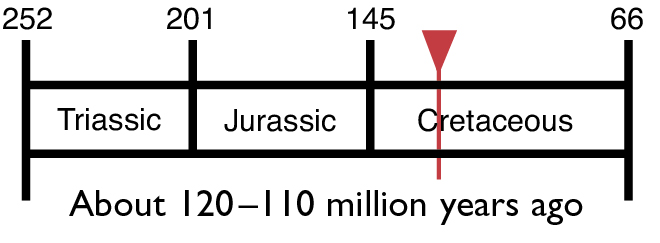

FUN FACTS: Because this dinosaur cannot be confidently placed within any known ornithopod family, it is considered a “free agent” (like an unsigned football player).
LOCATION: Australia
FOOD: Conifers, cycads, ginkgos
SIZE: 26 feet (8 m) long, about 10 feet (3 m) high at the hips
WEIGHT: 3 tons
FRIENDS: Minmi
ENEMIES: Theropods, or meat-eating dinosaurs
TRIVIA: The original specimen of Muttaburrasaurus was found in marine rocks. The dinosaur’s body may have floated out to sea before fossilization.
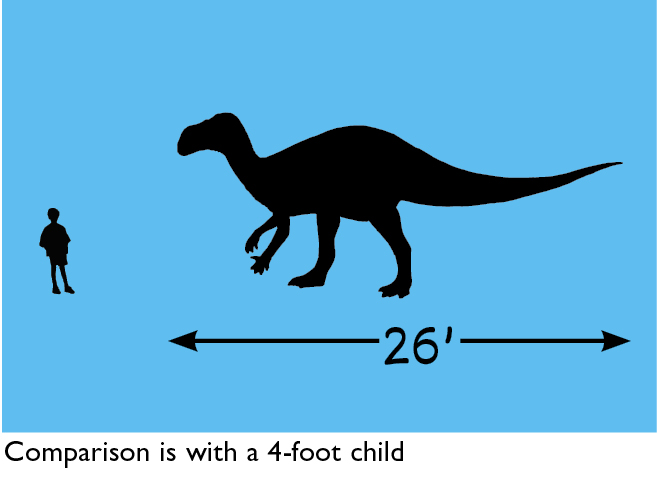

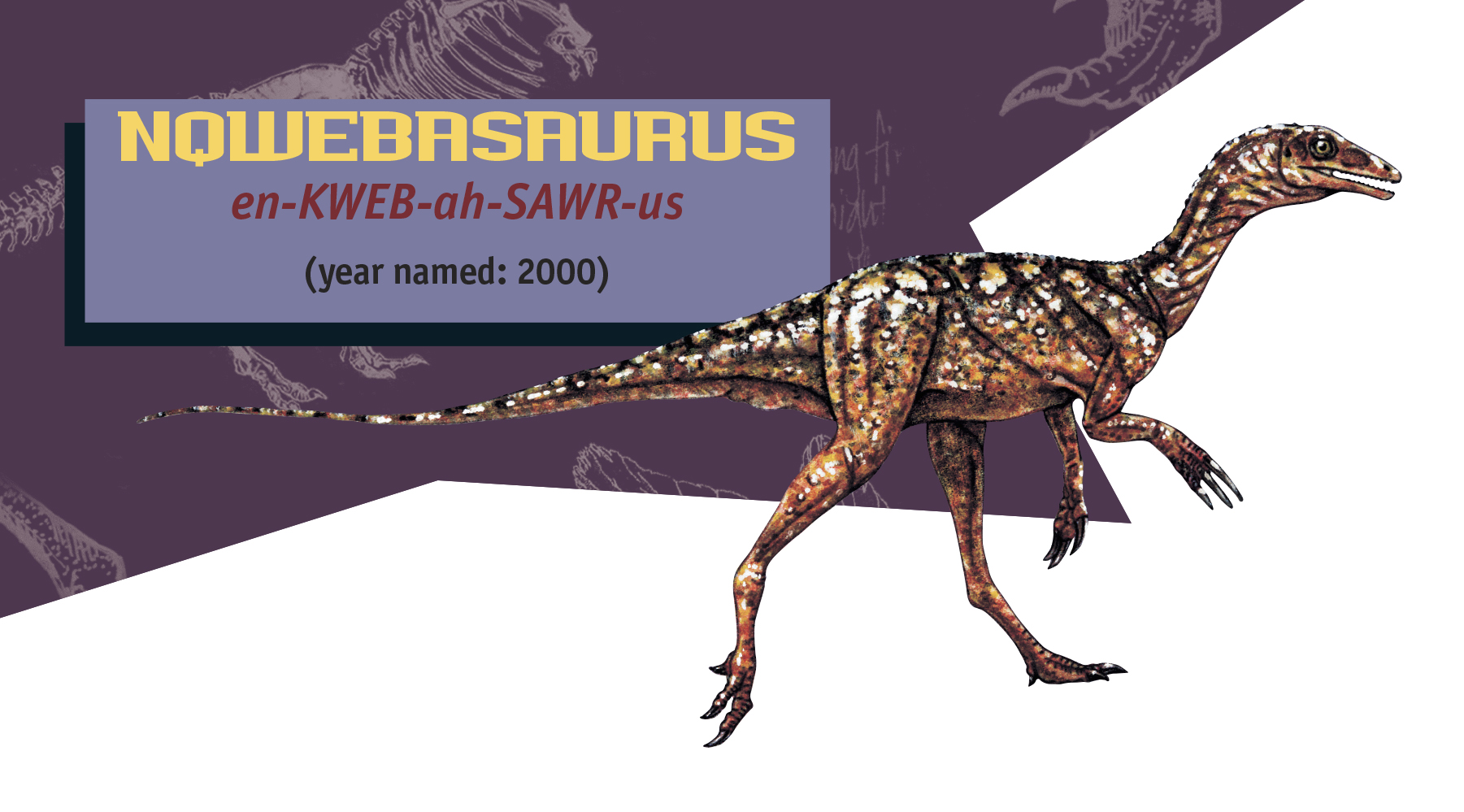

Nqwebasaurus (“Nqweba lizard”) is one of the smallest of all dinosaurs, except for birds. It seems to be related to ostrich dinosaurs such as Pelicanimimus and Gallimimus.
Two South African paleontologists, William De Klerk and Callum Ross, discovered the skeleton of this dinosaur in 1996. It was not complete, but the fossil clearly showed a small theropod (or meat-eating dinosaur), about 31 inches (80 cm) long. Like many theropods, it had a three-fingered hand. Its hind legs were long and built for running fast. When these paleontologists teamed up with American scientists to describe this dinosaur in 2000, they gave it the name Nqwebasaurus (Nqweba is the name of the Kirkwood region of South Africa—where this dinosaur was found—in the Xhosa language).
Nqwebasaurus is about the size of a chicken, as are Compsognathus and Sinosauropteryx. But unlike these other dinosaurs, its arms are relatively big. It probably could grab food with them. Its gizzard stones and very small teeth suggest that it mostly ate plants.


FUN FACTS: The first (and so far only) specimen of Nqwebasaurus was nicknamed “Kirky” for the Kirkwood Formation of rock in which it was found.
LOCATION: South Africa
FOOD: Plants, possibly small mammals and reptiles, possibly insects
SIZE: 2.5 feet (80 cm) long, about 13 inches (33.3 cm) high at the hips
WEIGHT: 1.3 lbs (580 grams)
TRIVIA: “Kirky” was found with gizzard stones in its belly. Although it is well known that plant-eaters used “stomach stones” to help them grind up food, some meat-eating dinosaurs, such as the spinosaur Baryonyx, and crocodiles also used them.
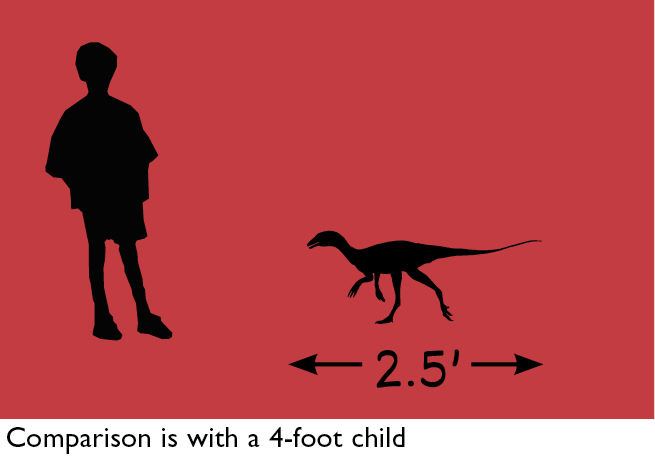

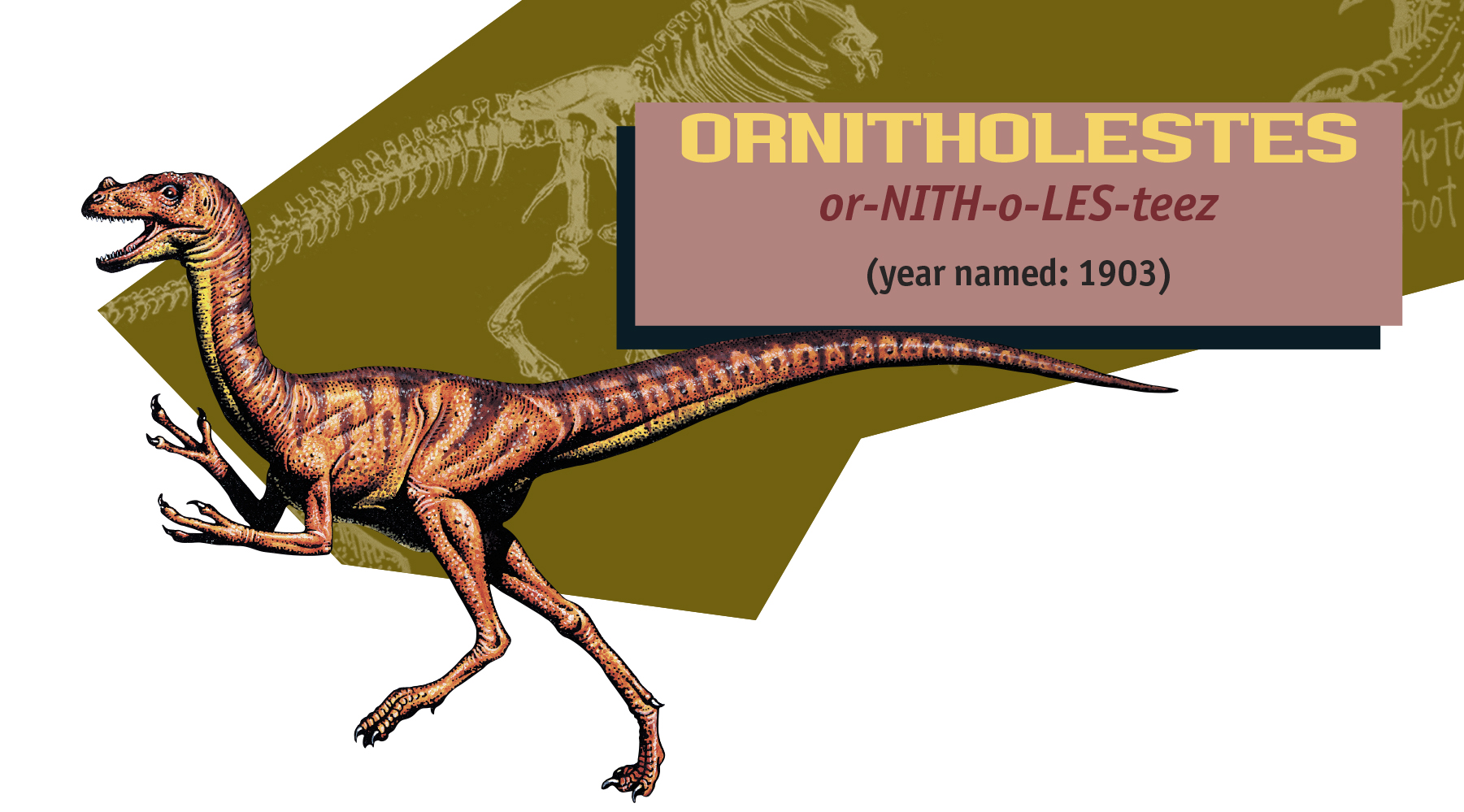

Ornitholestes (“bird thief”) is the best-known small theropod, or meat-eating dinosaur, from the famous Morrison Formation. The formation is a series of rocks in the western United States in which the best Late Jurassic dinosaur fossils in the world are found. The Morrison is well known for its sauropods (giant long-necked dinosaurs), impressive stegosaurs (plated dinosaurs), and giant meat-eaters such as Allosaurus and Ceratosaurus. However, small predators are also found in these rocks.
Ornitholestes is a small dinosaur, about 6.9 feet (2.1 m) long, half of which is tail. It has long arms—some paleontologists suggest that it could use these arms to catch birds. There is no evidence of this behavior, but primitive birds would have been about the proper size for this dinosaur to eat. More common victims may have been mammals, lizards, and baby dinosaurs.
The only known skull of Ornitholestes is damaged near the tip of its snout. It may have had a small horn over its nose.


FUN FACTS: A famous painting by Charles R. Knight showed an Ornitholestes leaping after an Archaeopteryx. Ornitholestes may have eaten early birds, but Archaeopteryx lived in a different part of the world, and it is unlikely that even an agile hunter like Ornitholestes could have caught a bird in midair.
LOCATION: Wyoming
FOOD: Small mammals and reptiles, possibly including little dinosaurs
SIZE: 6.9 feet (2.1 m) long, 1.55 feet (0.47 m) high at the hips
WEIGHT: 27.7 lbs (12.6 kg)
TRIVIA: Ornitholestes is not the only small theropod from the Morrison Formation; another such dinosaur is called Coelurus.
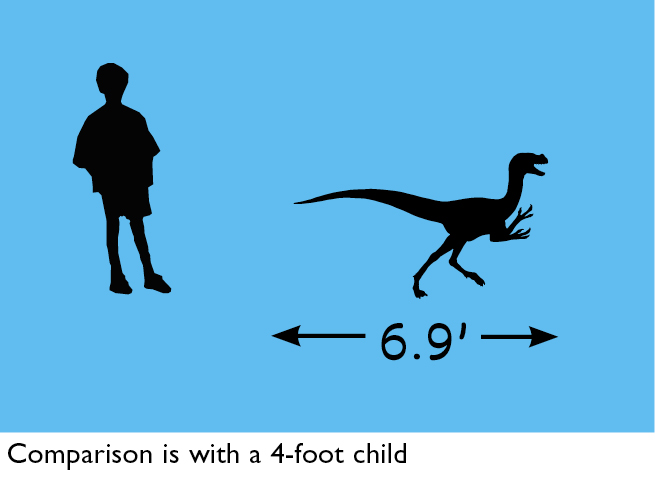



Othnielosaurus (after Othniel C. Marsh) was originally found in the 1870s at Garden Park near Canyon City, Colorado. This is one of the most famous Jurassic quarries in the world and has given the world such dinosaurs as Allosaurus, Ceratosaurus, and Stegosaurus.
Despite years of searching, scientists have not found many ornithopods from the Late Jurassic Period. What we do know is that most of these were small, fast, agile plant-eaters with a single row of leaf-cutting teeth. The arms were proportionally small, making these dinosaurs back-heavy. This gave them better balance while running on their well-muscled hind limbs. Othnielosaurus’s teeth have a short crown with a root that extends four times longer. The dinosaur must have eaten soft plants, because the whole tooth is too small to eat any of the hard plant parts. (This left hard, fibrous plants to be eaten by the larger sauropods.) As one of the smallest dinosaurs, Othnielosaurus made good eating for the juveniles of bigger theropods. Othnielosaurus fossils have been found from hatchling to juvenile sizes. No adult skeletons have yet been found.


FUN FACTS: The young of this small dinosaur would fit in your hand.
LOCATION: Colorado, Utah, Wyoming
FOOD: Ground plants and soft parts of conifers, cycads, ginkgos
SIZE: Less than 4 feet (1.1 m) long, about 1 foot (.3 m) high at the hips
WEIGHT: 50 lbs (22.7 kg)
FRIENDS: Dryosaurus, Camptosaurus
ENEMIES: Juvenile theropods
TRIVIA: Fragments of a similar dinosaur were named Othnielia in 1977.




Oviraptor (“egg hunter”) is a dinosaur once thought to have been an egg hunter. It is now known to have been an egg protector!
When paleontologists first found this little meat-eater in the Mongolian desert, it was sitting on top of a bunch of fossilized eggs. The scientists thought these eggs were from the horned dinosaur Protoceratops. Knowing that Oviraptor was a theropod, or meat-eating dinosaur, the scientists guessed that Oviraptor was about to eat the eggs. Many decades later, however, paleontologists discovered that these eggs were actually Oviraptor eggs, and that (like birds) Oviraptors sat on their eggs before they hatched. Since then, many Oviraptor nests (and nests of related dinosaurs) have been found with parents on top.
Oviraptor is one of the oviraptorosaur dinosaurs. Like other Late Cretaceous oviraptorosaurs, Oviraptor had a deep, toothless beak. It also had long, grasping hands, which would have been useful for clutching food.
The exact diet of Oviraptor is debated by paleontologists. The first skeleton of Oviraptor contained a lizard skeleton in its belly, so it definitely ate some meat. Some paleontologists, however, think that it may have eaten plants.


FUN FACTS: Oviraptor’s skull was so unusual that, when it was first dug out of the rock, paleontologists were not sure which end was the front!
LOCATION: Mongolia, China
FOOD: Small reptiles (including baby dinosaurs), possibly also plants and eggs
SIZE: 7.6 feet (2.3 m) long, almost 2.5 feet (0.75 m) high at the hips
WEIGHT: 71 lbs (32.4 kg)
TRIVIA: Oviraptor was originally going to be named Fenestrosaurus (“window lizard”) because of the openings in its skull, but the paleontologist who named it thought that “egg hunter” was a more interesting name.
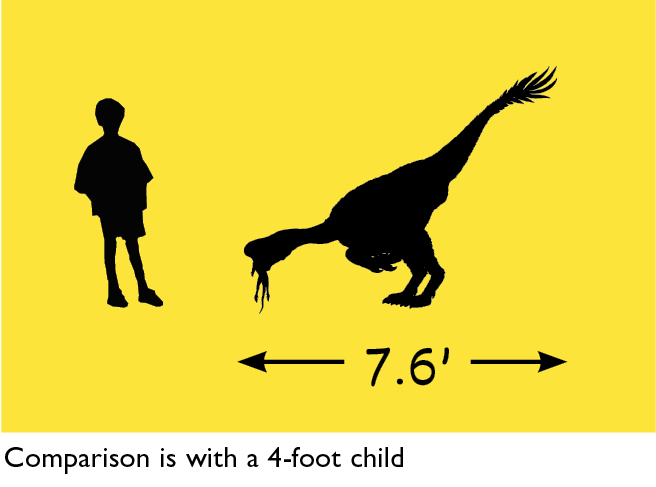



Pachycephalosaurus (“thick-headed lizard”) is the last and most famous member of the Pachycephalosauria, or thick-headed dinosaurs. In the 1970s, paleontologist Peter Galton proposed that male pachycephalosaurs used their domed heads as battering rams, like bighorn sheep. The idea caught the public’s imagination.
But by the 1990s, scientists began to question Galton’s head-butting theory. It was pointed out that animals who do butt heads have a wide surface area where the heads come into contact to prevent “head slippage.” This happens when two animals butt heads at high speed and do not hit straight on. They risk breaking their necks when their heads suddenly snap to one side. Pachycephalosaurus has a domed, or rounded, head, which would minimize surface contact and therefore increase the risk of head slippage.
This throws doubt on the idea of any high-speed head-butting between pachycephalosaurs, but it does not exclude “head-pushing” or “head-ramming” against non-pachycephalosaurs. It just happens that if a pachycephalosaur lowered its head and charged at a theropod, the impact would be right at the level of the theropod’s head or pelvis—the perfect place to stop an attacker. Since Pachycephalosaurus had a skull up to 9 inches (23 cm) thick, guess who’d lose?
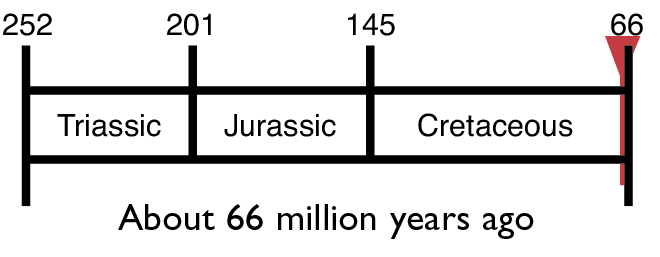

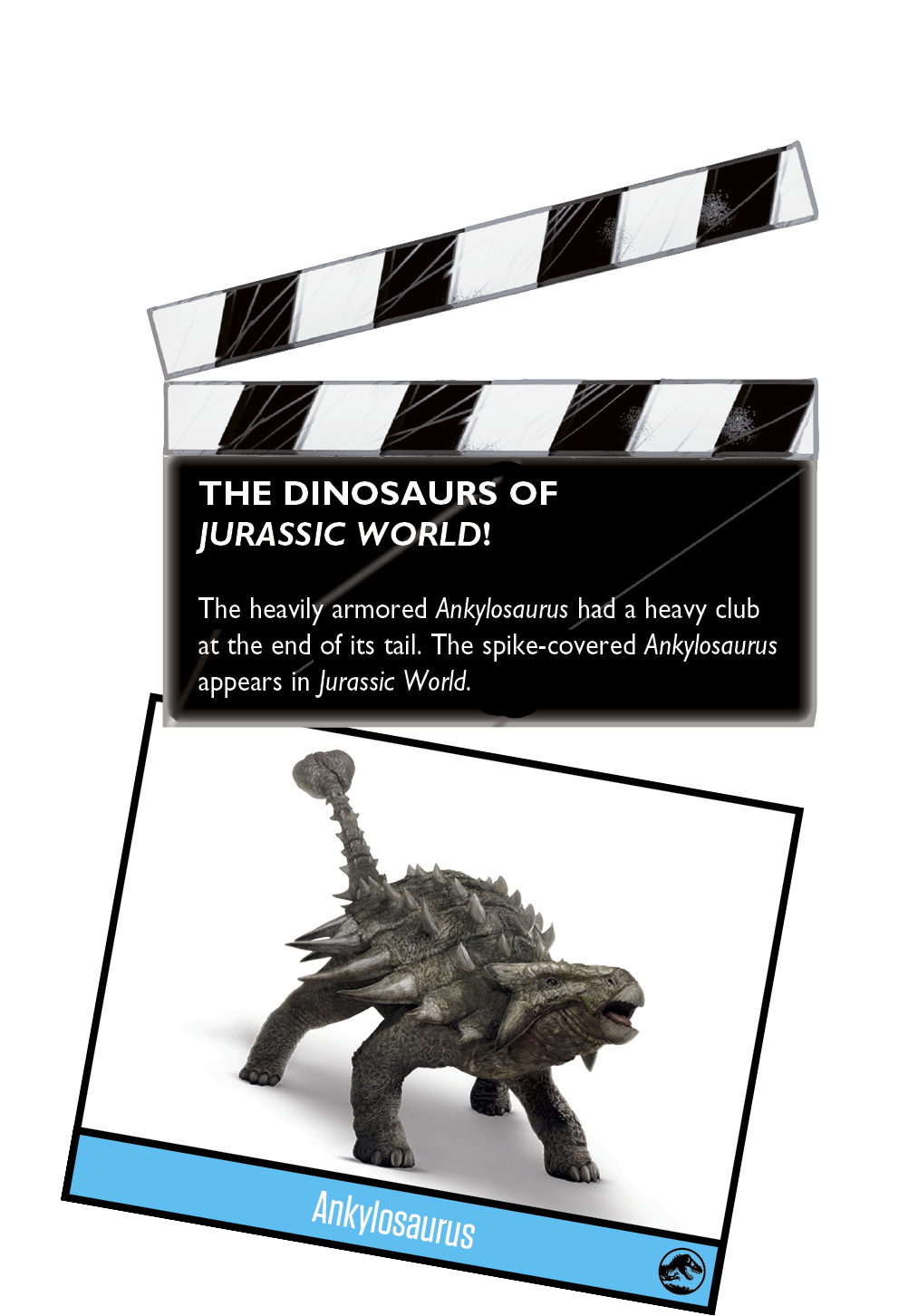

FUN FACTS: Males had larger and more ornamented bumps on the back of their skulls than females.
LOCATION: Montana, South Dakota, Wyoming
FOOD: Low-growing conifers, cycads, ginkgos, flowering plants
SIZE: Over 13 feet (about 4 m) long, over 5 feet (1.6 m) high at the hips
WEIGHT: 800 lbs (364 kg)
FRIENDS: Hadrosaurs, small ceratopsians (horned dinosaurs)
ENEMIES: Troodon, Tyrannosaurus, Acheroraptor
TRIVIA: The teeth of Pachycephalosaurus are smaller than the first teeth of a human baby!
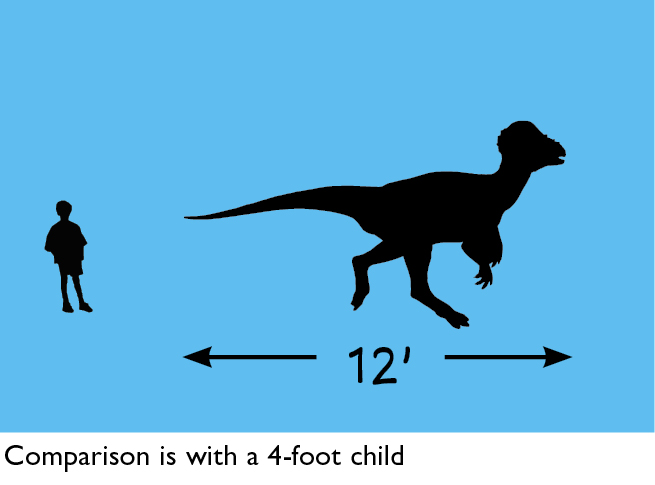



Parasaurolophus (“like Saurolophus”) and Charonosaurus (“Charon’s lizard”) are two very closely related duckbill dinosaurs. They have one major feature in common: a long nasal tube. This hollow tube has up to three paired chambers that connect the nostrils with the back of the throat. Scientists Thomas Williamson and Robert Sullivan have studied these chambers with a computer axial tomography (CAT) scan. They theorize that these dinosaurs could not only make sounds within the range of human hearing but also in “infra-sound,” or below the range of human hearing, like modern elephants!
The nasal tube also served other purposes and is the perfect example of a multi-function device. It aided species recognition during mating, enhanced the dinosaur’s sense of smell, humidified the air it breathed, and indicated how old it was.
Charonosaurus is from China and Parasaurolophus is from western North America. This indicates that these areas were connected by a land bridge at the end of the Cretaceous Period. They are both lambeosaurs, or crested duckbills. Lambeosaurs made up a larger percentage of the herbivore communities in Asia than in North America, where flat-headed hadrosaurs and horned dinosaurs are more common. This means that although the two areas were connected, they had different fauna.
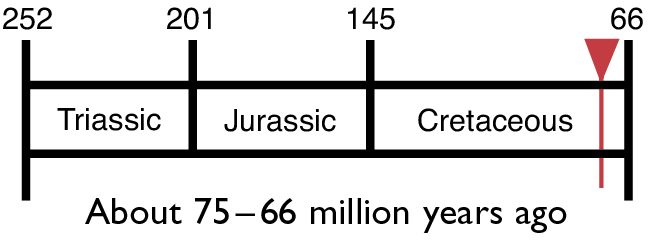

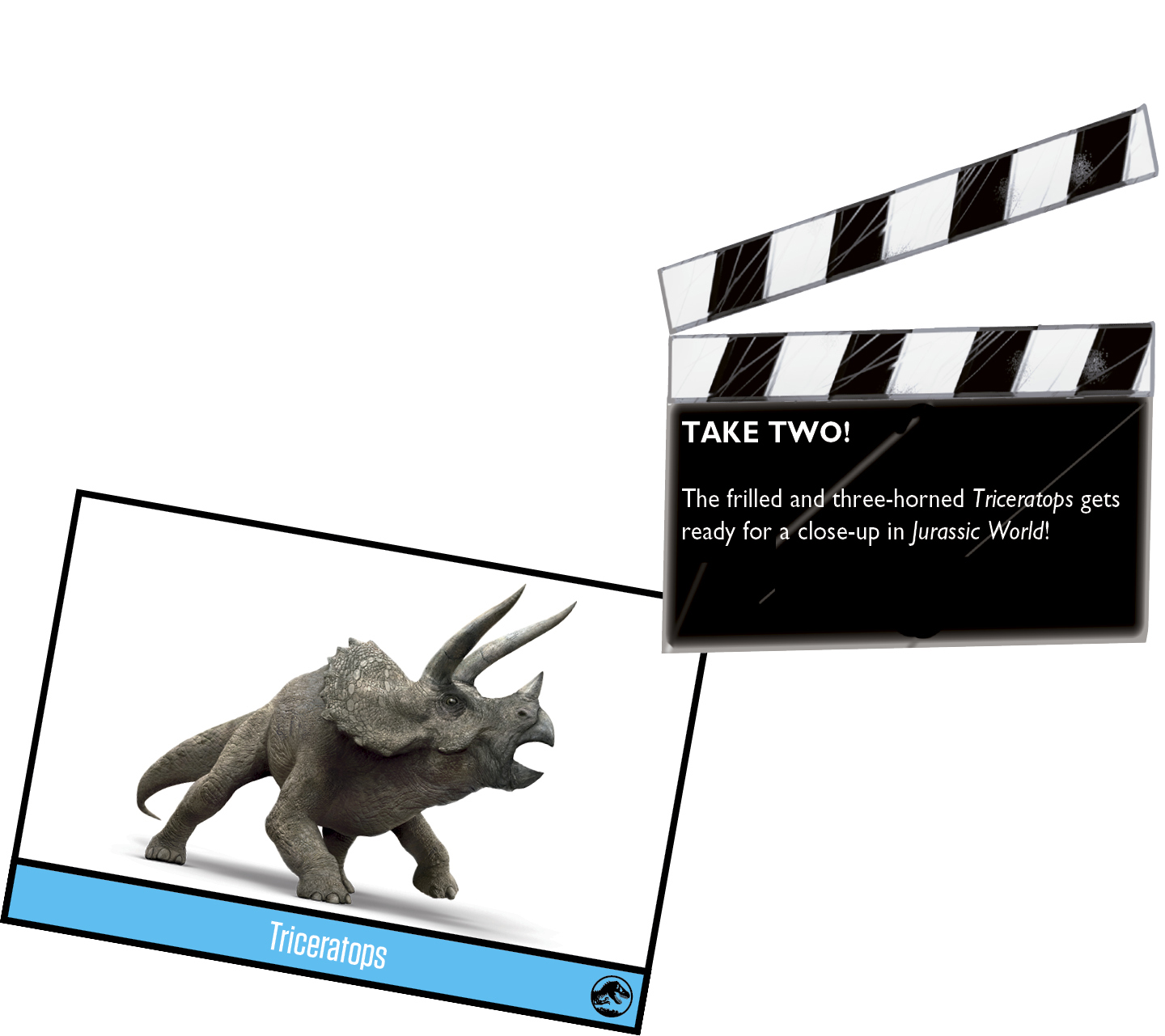

FUN FACTS: Computer studies of Parasaurolophus crests suggest they sounded like a deep bassoon.
LOCATION: Charonosaurus in China. Parasaurolophus in New Mexico; Utah; Montana; Alberta, Canada.
FOOD: Conifers, cycads, ginkgos, flowering plants
SIZE: 40 feet (over 12 m) long, about 9 feet (2.8 m) high at the hips
WEIGHT: 2 tons
FRIENDS: Edmontosaurus
ENEMIES: Daspletosaurus, Tarbosaurus
TRIVIA: The Parasaurolophus specimen on display at the Royal Ontario Museum in Toronto has two broken back bones.
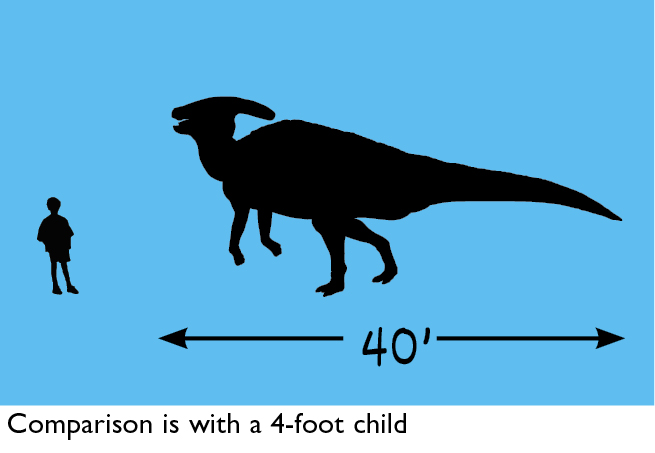



Pelecanimimus (“pelican mimic”) is the earliest known ornithomimosaur, or “bird mimic,” often called an ostrich dinosaur. It lived during the early part of the Cretaceous Period, whereas most ostrich dinosaurs lived millions of years later, during the Late Cretaceous Period.
Like other ornithomimosaurs, Pelecanimimus has a small, pointed head at the end of a long neck. Its arms end in typical ostrich dinosaur hands—three fingers of the same length, all curving in the same direction. But unlike the Late Cretaceous ostrich dinosaurs, which have toothless beaks, Pelecanimimus has jaws filled with over 220 tiny teeth. It is also the smallest known ostrich dinosaur, being only 6.6 feet (2 m) long.
Pelecanimimus is known only from a single skeleton from Spain. On that skeleton, an impression of skin was found around some of the bones. The impression indicated that there was a pouch underneath the lower jaw, like that of a pelican. However, when scientists examined these impressions more closely, they realized that these were not the outside surface of the skin but the inside tissue! This was one of the first times that a dinosaur’s muscle tissue had been preserved. Unfortunately, because the fossilization process turned this tissue into rock, none of its DNA was preserved.


FUN FACTS: Pelecani-mimus was preserved in mud at the bottom of an ancient lagoon. The same rock contains the remains of many plants, insects, fish, lizards, crocodiles, and at least three bird species.
LOCATION: Spain
FOOD: Possibly fish, possibly small reptiles and mammals
SIZE: 6.6 feet (2 m) long, about 20 inches (50 cm) high at the hips
WEIGHT: About 26 lbs (12 kg)
FRIENDS: None
ENEMIES: Larger theropods
TRIVIA: Pelecanimimus has more teeth than any other therapod dinosaur known.




Plateosaurus (“flat lizard”) is an early dinosaur from the Triassic Period. It was the first dinosaur that was much larger than a human, and the first with a long sauropod-like neck. Plateosaurus was heavily built, and its long muzzle was filled with teeth designed for chopping. The feet were clawed, and the hands had some grasping ability. The hand claw was relatively small compared to that of Massospondylus. Many outdated skeletons show Plateosaurus walking on two feet. But that is unlikely because Plateosaurus was big and front-heavy and likely walked on all four feet.
Plateosaurus has been studied many times, mainly by the German paleontologist Friedrich von Huene in the early 1900s and by Peter Galton in the late 1900s. Galton challenged the theory that Plateosaurus was an omnivore, or plant- and meat-eater. He showed that its teeth and jaw action were more like that of a true plant-eater, where the lower jaws meet the upper jaws like a nutcracker, with all the teeth coming together at the same time. In an omnivore, the jaws come together more like scissors, with the teeth meeting first at the back of the jaw, then finally at the front of the jaw.


FUN FACTS: Over a hundred Plateosaurus skeletons have been found.
LOCATION: Germany, France, Switzerland
FOOD: Conifers, cycads, ginkgos
SIZE: 26 feet (8 m) long, over 6.6 feet (2 m) high at the hips
WEIGHT: 1 ton
FRIENDS: Sellosaurus
ENEMIES: Liliensternus
TRIVIA: Plateosaurus was named in 1837, before the word “dinosaur” was coined!
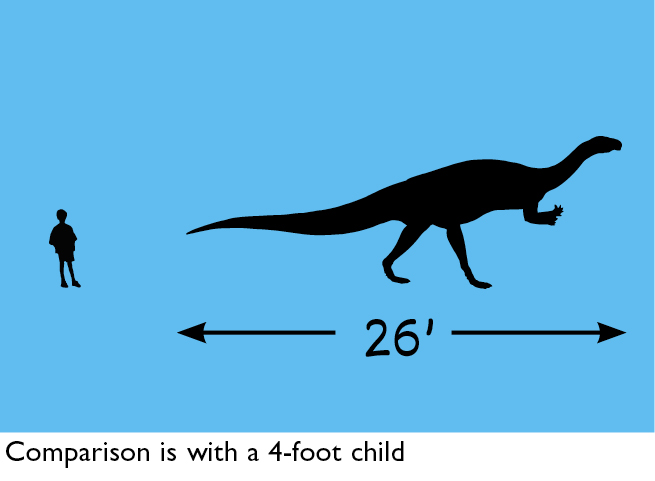

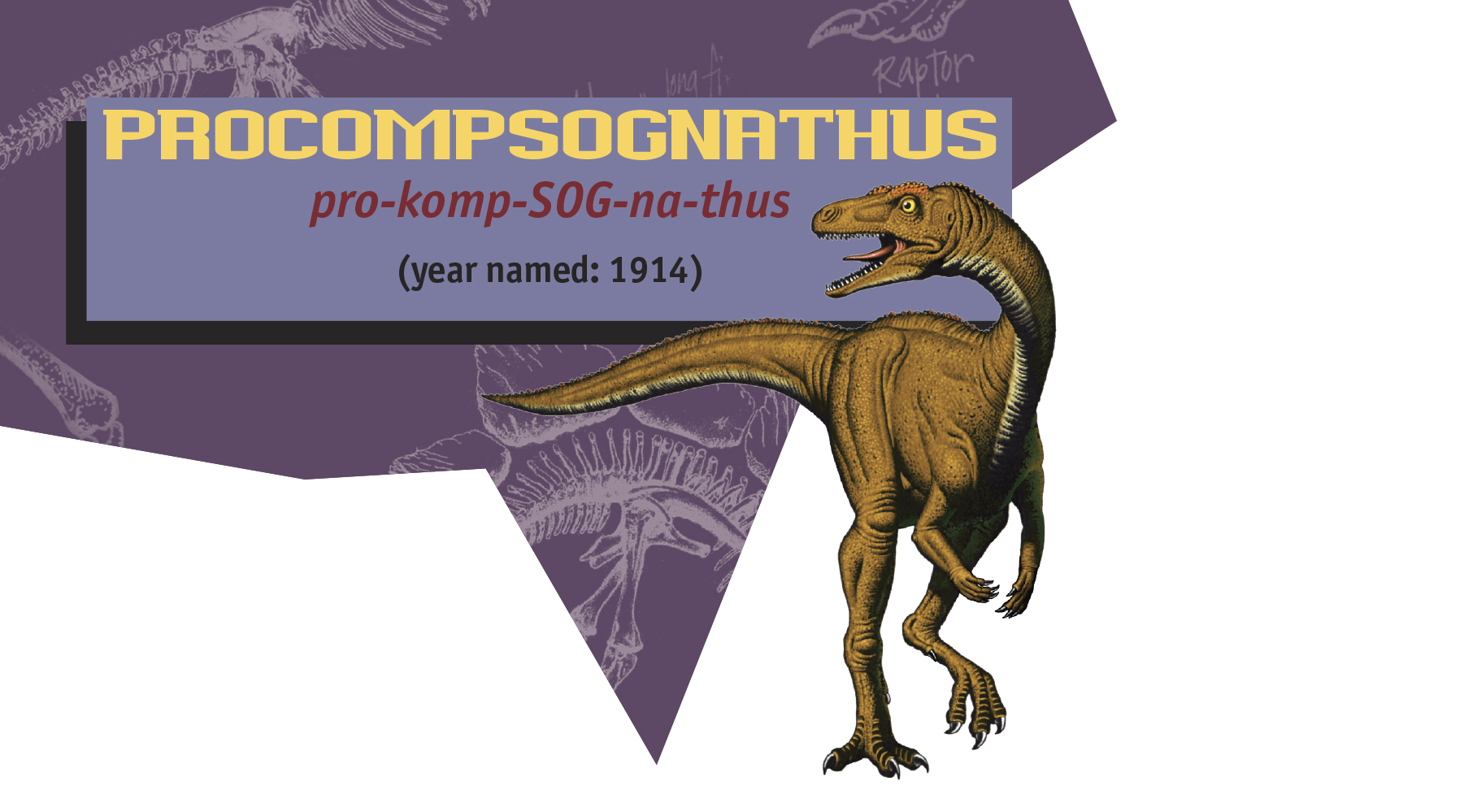

Procompsognathus (“before Compsognathus”) is a very small dinosaur from the Late Triassic Period. The only known skeleton of this dinosaur is incomplete but shows that it was less than 3 feet (90 cm) long. It is a small theropod, or meat-eating dinosaur, and ran on long hind legs.
The paleontologists who first discovered this fossil thought it reminded them of Compsognathus, the little theropod from the Late Jurassic of Germany. More recent studies of this dinosaur show that it was more closely related to Coelophysis and Dilophosaurus than to Compsognathus. Also, these studies show that the skull that was originally thought to be from Procompsognathus was actually from an early land-living crocodile relative.
There is no evidence that Procompsognathus (or Compsognathus) ran around in packs, attacking much larger animals.
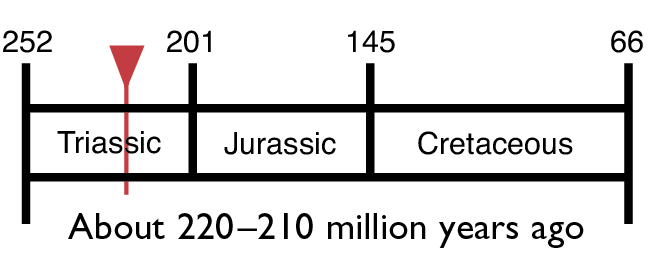

FUN FACTS: Procompsognathus was so small that a small dog or a house cat would have been a danger to it. Good thing for Procompsognathus that dogs and cats did not evolve until 200 million years after it was gone!
LOCATION: Germany
FOOD: Possibly small mammals, reptiles, and insects
SIZE: Less than 3 feet (90 cm) long, 10 inches (26 cm) high at the hips
WEIGHT: 2.2 lbs (1 kg)
FRIENDS: None
ENEMIES: Crocodile relatives
TRIVIA: Procompsognathus is one of the smallest dinosaurs known from the Triassic Period.
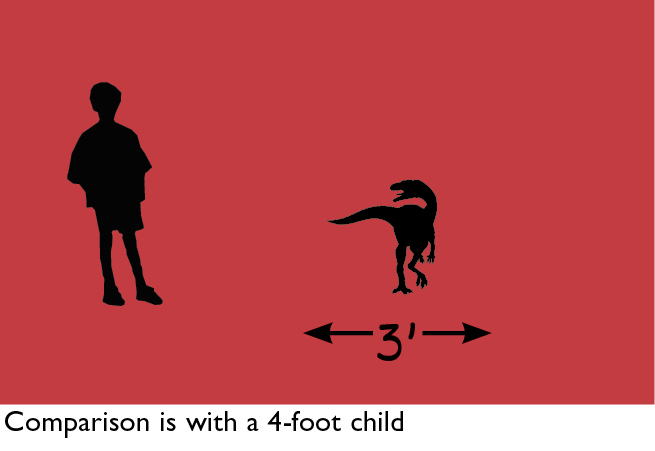

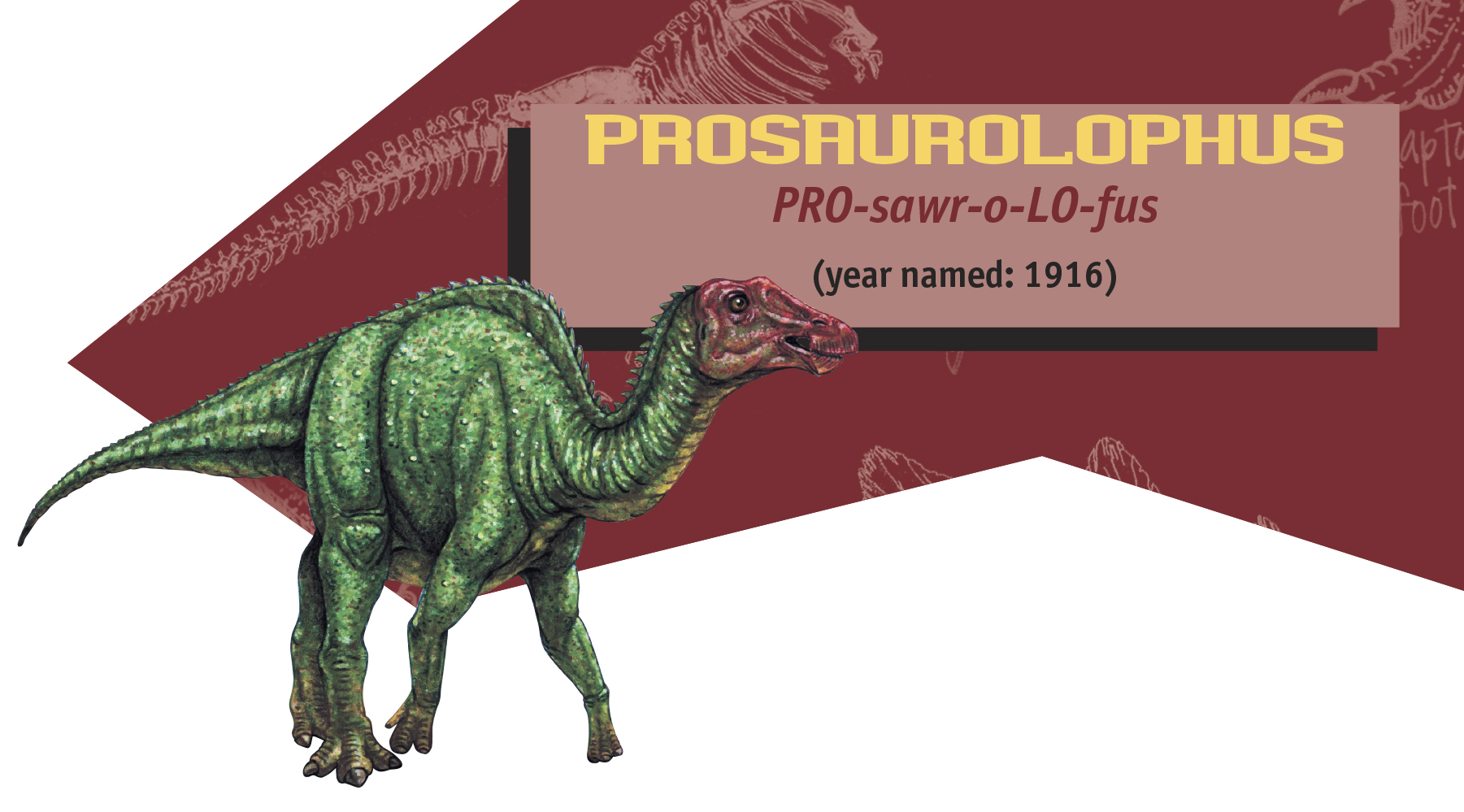

Prosaurolophus (“before Saurolophus”) is a duckbill dinosaur, one of the two-legged herbivorous dinosaurs known as ornithopods. It is a relatively unknown dinosaur, in need of a publicist. The first specimen was collected by the greatest dinosaur field paleontologist of the twentieth century, Barnum Brown of the American Museum of Natural History in New York. During World War I, Brown led an expedition along the Red Deer River in Alberta, Canada, where he collected some of the most perfect duckbill skeletons ever found—including this one.
Prosaurolophus (and its probable descendant, Saurolophus) belongs to a subgroup of duckbills known as the Saurolophini, the rarest of all duckbills. These dinosaurs are sometimes hard to place in the “big picture” of duckbill evolution because they have features from both the hadrosaurines, or non-crested duckbills, and the lambeosaurines, or crested duckbills.
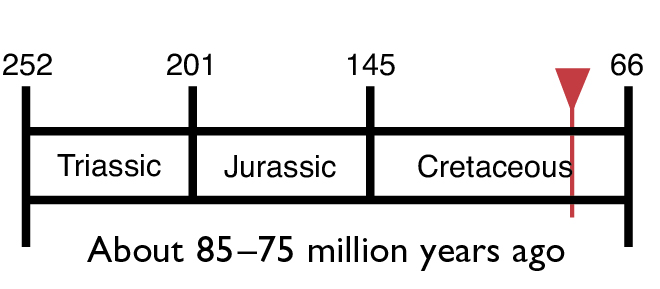

FUN FACTS: There are two species of Prosaurolophus. One was named by Jack Horner, the duckbill expert.
LOCATION: Montana; Alberta, Canada
FOOD: Conifers, cycads, ginkgos, flowering plants
SIZE: About 33 feet (10 m) long, 6 feet (1.8 m) high at the hips
WEIGHT: 2 tons
TRIVIA: There are fewer duckbill experts than there are specimens of Prosaurolophus!




Psittacosaurus (“parrot lizard”) was one of the first to appear of the last great group of dinosaurs: ceratopsia, the horned dinosaurs. Psittacosaurus has two features common to all ceratopsians: an extra upper beak bone on top of the upper lip bone, and the beginnings of what will become the ceratopsian frill.
Over eleven species of Psittacosaurus have been named—more than in 99 percent of all other dinosaurs. But are they all valid? Some scientists will name a new species based on very slight differences in the skull. These differences can be the result, however, of sex, age, health, and normal variation within populations. There are also stratigraphic differences. This means that over time, later populations can evolve larger features than their ancestors.
Psittacosaurus remains have been found with gastroliths, or stomach stones. Because most herbivorous dinosaurs could not chew their food, they swallowed a lot of unprocessed plants. To aid their digestion, they also swallowed small stones.
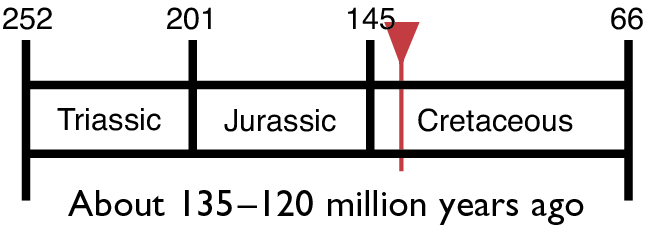

FUN FACTS: Ceratopsians are so popular that they have their own book, The Horned Dinosaurs, by Peter Dodson.
LOCATION: China, Mongolia, Thailand
FOOD: Conifers, cycads, ginkgos
SIZE: 6.6 feet (2 m) long, almost 20 inches (.5 m) high at the hips
WEIGHT: 50 lbs (23 kg)
FRIENDS: Shamosaurus, Altirhinus
ENEMIES: Dilong, Yutyrannus, Repenomamus (a mammal known to eat baby Psittacosaurus)
TRIVIA: Psittacosaurus has horns on its cheeks, called jugal horns.
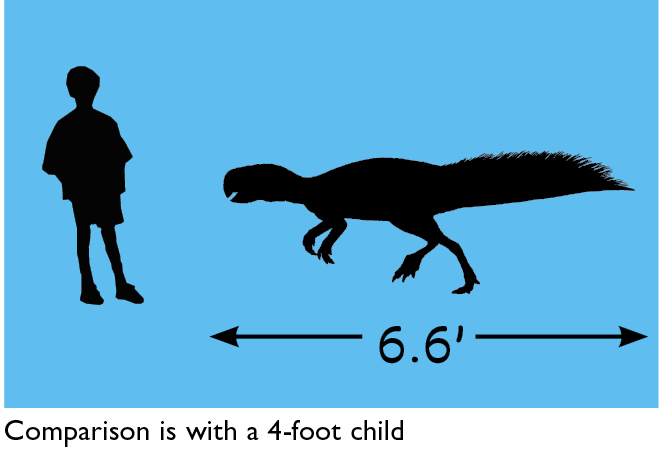



Sauroposeidon (“Poseidon lizard,” after the Greek god of earthquakes) is the tallest dinosaur yet known to science. It was found in 1994 but not named until 2000. That is because it takes several years to prepare and analyze such a large skeleton. The bones of this sauropod, or long-necked plant-eater, are so big, when they were first discovered, some scientists thought they’d found a fossilized tree trunk!
Sauroposeidon’s neck is about 40 feet (12 m) long! A single neck bone is over 5 feet (1.6 m)! These neck bones are so hollow that when X-rayed, they show more space than bone. This is a biological phenomenon called “structural lightening.” It is designed to allow large bones to support great weights without weighing too much themselves. An adult human standing next to Sauroposeidon would not even come up to its elbow!
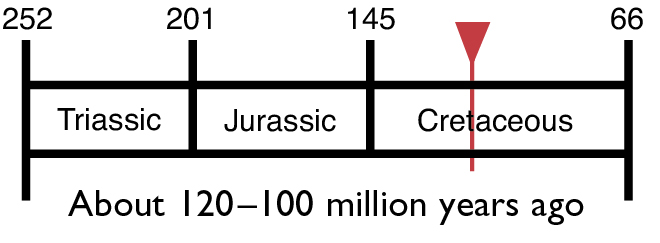

FUN FACTS: Sauroposeidon was the last member of the family Brachiosauridae before they went extinct. This is the tallest known animal (so far) in Earth’s history.
LOCATION: Oklahoma, Texas
FOOD: Conifers, cycads, ginkgos
SIZE: About 100 feet (over 31m) long, 13 feet (4m) high at the hips
WEIGHT: 50 tons
TRIVIA: The largest living mammals are still not as well engineered as the dinosaurs. Mammal bones are more solid and less able to handle larger weight loads.
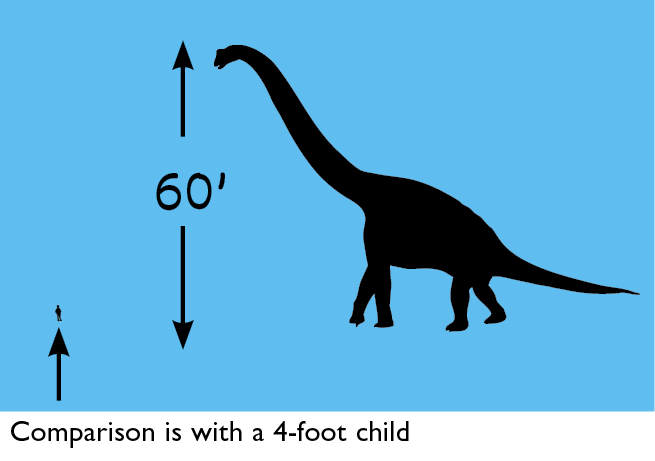



Shuvuuia (“bird”) is one of the strangest theropods, or meat-eating dinosaurs, ever found. It is one of the alvarezsaurs, a group of small bird-like dinosaurs of the Late Cretaceous Period.
Shuvuuia has a pointed, beaky snout, with jaws holding many very tiny teeth. It has a long neck, a compact body, a fairly short tail (for a dinosaur), and long legs built for running fast.
One of the oddest parts about it is its arms. While most advanced theropods had three working fingers, and the tyrant dinosaurs had two, alvarezsaurs had only one working finger—the thumb. Also, although the arms of Shuvuuia are short—like its larger relatives—they were extremely strong. Scientists do not know how Shuvuuia used these arms, but they certainly had some function. Perhaps it used them to dig into insect nests?
Shuvuuia and the other alvarezsaurs are a bit of a puzzle in the dinosaur family tree. In some ways they seem like the ostrich dinosaurs, in others they are similar to primitive birds, and in still other ways they are like troodonts. Paleontologists are still trying to determine the closest relatives to these bizarre little dinosaurs.
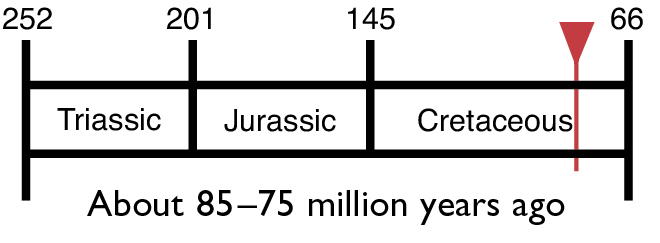

FUN FACTS: A skeleton of Shuvuuia is on display at the American Museum of Natural History in New York City.
LOCATION: Mongolia
FOOD: Possibly insects, possibly small mammals and reptiles
SIZE: About 3 feet (.88 m) long, 12 inches (30 cm) high at the hips
WEIGHT: About 5.5 lbs (2.5 kg)
FRIENDS: None
ENEMIES: Velociraptor
TRIVIA: A full-grown Shuvuuia was only the size of a chicken, but it was bigger than most of the mammals that lived in its environment.




Sinornithoides (“Chinese bird form”) is one of the oldest known troodonts, or “wounding tooth” dinosaurs. Troodonts were meat-eating dinosaurs with extremely long hind legs. They were very bird-like in the details of their braincases, their backbones, and other features. They were also probably among the fastest of the smaller dinosaurs.
Before Sinornithoides was discovered, troodonts were only known from incomplete fossils. Then, in 1988, the skeleton of this little dinosaur was found in the region of China called Inner Mongolia. This dinosaur had been buried by a sandstorm while lying on its belly. Its head and neck were tucked under its arm, and its tail was wrapped around its body. Because it was covered over so quickly and so completely, nearly the entire skeleton was preserved in fine detail.
Sinornithoides was about the size of a wild turkey. It could easily chase down mammals, lizards, smaller dinosaurs (including babies), and similar creatures for their meat. Because the teeth of troodonts are similar to those of plant-eating dinosaurs, some scientists think that troodonts like Sinornithoides also ate insects and plants. Many small carnivorous mammals (foxes and raccoons, for instance) are actually omnivores: They eat meat, plants, and other food.


FUN FACTS: Sinornithoides is not the only Asian troodont. There are several other kinds, including one called Borogovia after the borogoves in Lewis Carroll’s poem “Jabberwocky.”
LOCATION: Inner Mongolia, China
FOOD: Mammals, lizards, smaller dinosaurs, possibly insects, possibly plants
SIZE: About 3.6 feet (1.1 m) long, almost 18 inches (45 cm) high at the hips
WEIGHT: About 12 lbs (5.5 kg)
FRIENDS: None
ENEMIES: Larger theropods
TRIVIA: Until Sinornithoides was found, many paleontologists thought that troodonts had long arms like raptors.


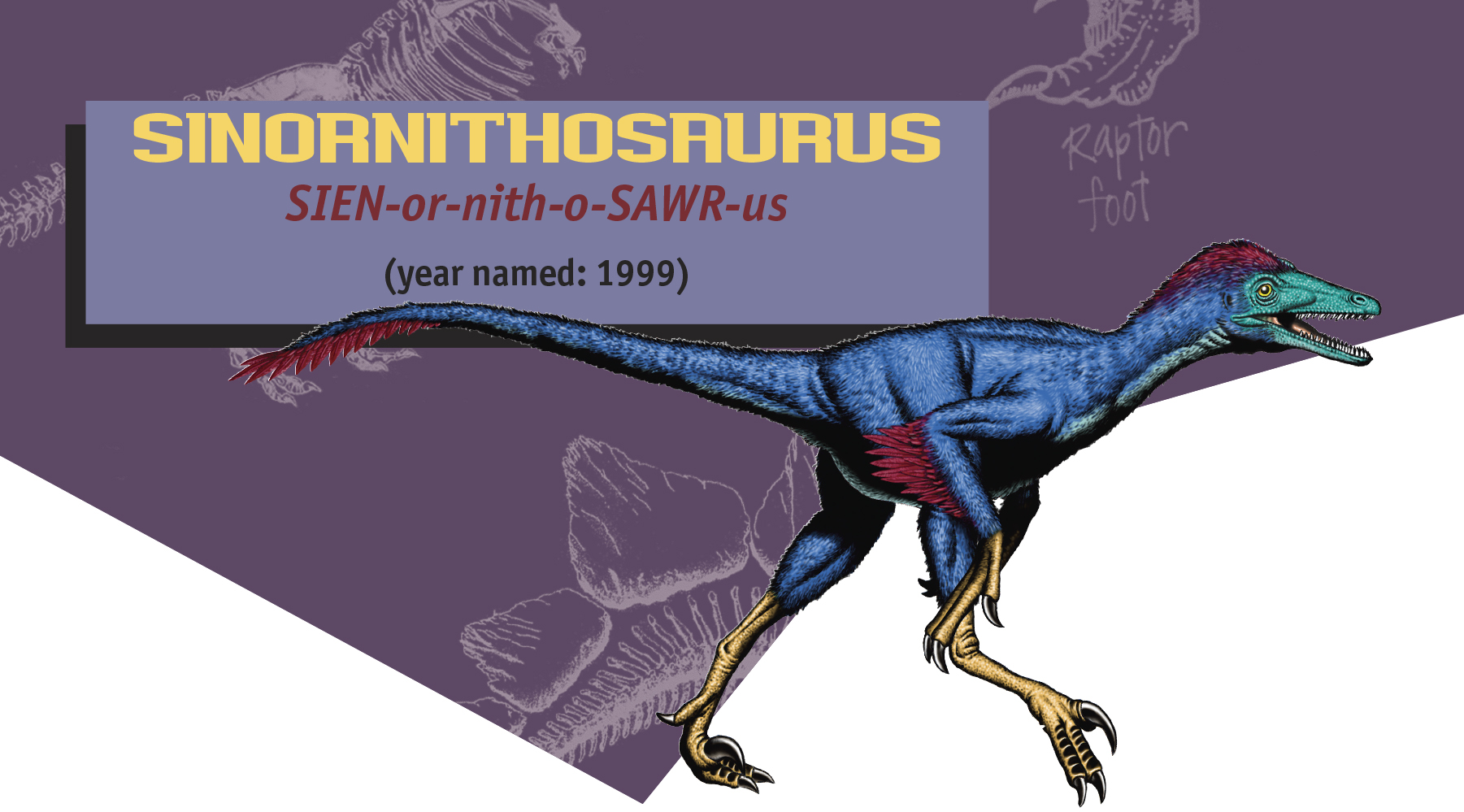

Sinornithosaurus (“Chinese bird lizard”) is one of the oldest known dromaeosaurs, or raptors. This was an early relative of Velociraptor and Deinonychus. Like Velociraptor, it was a fairly small dinosaur, but it was probably very dangerous. It had sharp, curved teeth in its jaws, long grasping hands at the end of long arms, and a killer sickle claw on the second toe of each foot. What makes Sinornithosaurus more famous, though, is that fact that it was “fuzzy”!
All over the body of Sinornithosaurus were long filaments. These structures were protofeathers, a fuzzy body covering that eventually evolved into true feathers. Both protofeathers and true feathers are “soft” features that do not fossilize easily. But the fine-grained mud of the Yixian Formation, where Sinornithosaurus was found, was able to preserve the soft features of the dinosaurs, other animals, and plants that died there.
Other theropods found in the Yixian Formation include Beipiaosaurus, Caudipteryx, Confuciusornis, and Sinosauropteryx. They all were found to have either protofeathers or true feathers. Before these finds, scientists thought that raptor dinosaurs like Deinonychus and Velociraptor were covered only in scales. This is because the rocks where they were found did not preserve their soft body coverings.
Now, with the discovery of Sinornithosaurus (and the other theropods found in the Yixian), we know that raptors and all the other advanced, bird-like meat-eating dinosaurs were covered with either fuzzy protofeathers or true feathers.
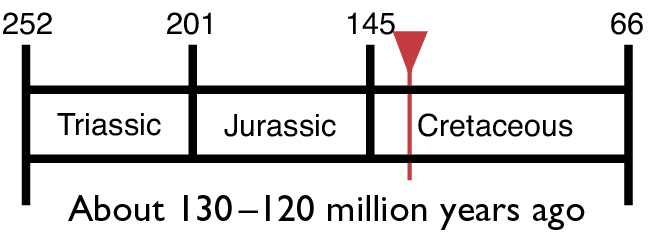

FUN FACTS: A raptor from Montana that was very similar in size to Sinornithosaurus was named Bambiraptor because its long legs reminded the discoverers of the fictional deer Bambi.
LOCATION: Liaoning Province, China
FOOD: Psittacosaurus, Sinosauropteryx, Caudipteryx, Beipiaosaurus, Confuciusornis
SIZE: About 4 feet (1.25 m) long, about 18 inches (over 45 cm) high at the hips
WEIGHT: 12 lbs (6.4 kg)
FRIENDS: None
ENEMIES: Dilong, Yutyrannus
TRIVIA: This was the first raptor dinosaur found with feathers on its body. Since then, every raptor found in the rocks that preserve their body cover has been fully feathered.
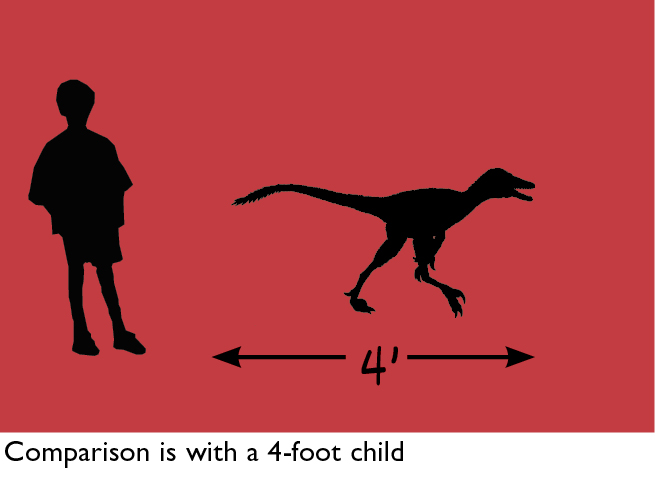



Sinosauropteryx (“Chinese lizard wing”) was probably the most important dinosaur discovered in the 1990s. Before it was found, paleontologists had shown that birds were the descendants of theropods, meat-eating dinosaurs. However, they did not know when certain bird-like features first appeared. That’s because many of the things that make birds special among all living animals are soft features that don’t fossilize well.
One of these soft features is feathers. Some paleontologists suspected that many of the theropod dinosaurs were actually covered by feathers or fuzz, but they could not find proof. Then, in 1996, an amazing discovery was made in northeastern China. In a series of rocks called the Yixian Formation, the skeleton of a small theropod was found. This little dinosaur was very similar to Compsognathus, a slightly older dinosaur from Germany. The bones of the skeleton were complete, but the most interesting thing about the fossil was the traces of small fibers surrounding the bones. These fibers turned out to be protofeathers, a simple type of body covering that developed into feathers in birds and their closest relatives.
Since 1996, many feathered dinosaurs have been found in the Yixian Formation, but Sinosauropteryx is the most primitive of the feathered dinosaurs found to date. Because the Yixian dig has revealed that Sinosauropteryx, as well as its more advanced relatives, had feathers or protofeathers, paleontologists now realize that almost all the advanced meat-eating dinosaurs had this covering. This includes not only little dinosaurs like troodonts (see Sinornithoides) and alvarezsaurs (see Shuvuuia), but also medium-sized forms like ostrich dinosaurs (see Pelecanimimus and Gallimimus), oviraptorosaurs (see Oviraptor and Caudipteryx), and dromaeosaur raptors (see Sinornithosaurus, Velociraptor, and Deinonychus). Even Tyrannosaurus, Gorgosaurus, and the other tyrant dinosaurs (which are more advanced than Sinosauropteryx) probably had proto-feathers when they were hatchlings, but some scientists think that they might have shed these as they grew up.
You might wonder why the Yixian Formation was able to preserve the soft features of these dinosaurs, while other rocks did not. The mud that became the Yixian Formation is very fine-grained—that is, the particles that make it up are very small. Because of this, small details were not blurred out. Also, because these dinosaurs were preserved in a quiet lake-like environment, rather than in muds dumped by a flooding river or sands blown around by sandstorms, the bodies of the dinosaurs were not damaged before they were covered over with mud. Thanks to this lucky circumstance, we now know much more about the outsides of these dinosaurs!
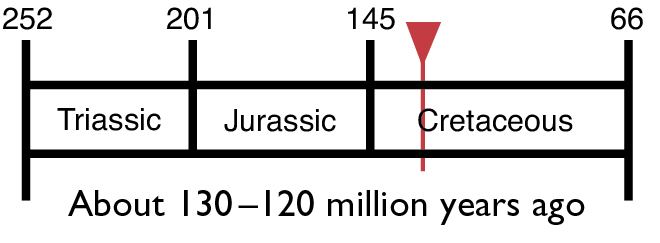

FUN FACTS: Although its name means “Chinese lizard wing,” Sinosauropteryx did not have wings, nor could it fly. In fact, its arms were so short that they could barely scratch its knee!
LOCATION: Liaoning Province, China
FOOD: Small mammals and lizards
SIZE: A little over 4 feet (1.25 m) long, 11.4 inches (29 cm) high at the hips
WEIGHT: 5.5 lbs (2.5 kg)
FRIENDS: Psittacosaurus, Caudipteryx, Beipiaosaurus, Confuciusornis
ENEMIES: Sinornithosaurus
TRIVIA: The scientists who discovered Sinosauropteryx at first thought that dinosaurs could not have feathers, so they called it a bird.
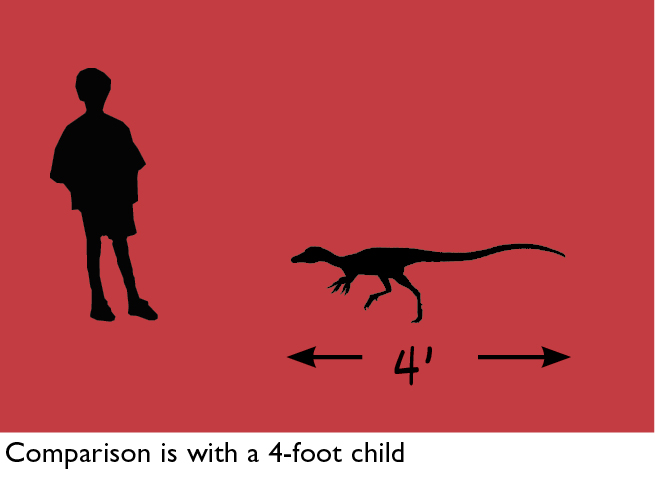



Spinosaurus (“spine lizard”) is one of the most spectacular dinosaurs ever found. It was an enormous meat-eating dinosaur, as big as Tyrannosaurus rex. But its jaws and teeth were very different from T. rex’s. The jaws were long and slender, and the teeth were cone-shaped, like those of a crocodile.
Its most distinctive feature, however, was the huge sail-like fin on its back. This sail was made from the spines that come out of the top of the backbones of dinosaurs and all other backboned animals. If you feel down your spine from the bottom of your head, you’ll feel a series of bumps (especially at the base of the neck). These bumps are the same bumps on the top of backbones of dinosaurs. The spines of Spinosaurus, though, were tremendous: The longest one found was over 5 feet (1.7 m) tall!
What would have been the purpose of such a sail? Although Spinosaurus lived in a swampy coastal environment, the sail would not have been used like the sail of a boat. Instead, it may have served to let Spinosaurus cool itself down if it got too hot. The skin on the sail, like all skin, would have been filled with blood vessels. Hot blood pumped into the sail would be cooled off, especially if there was a breeze; African elephants use blood vessels in their ears for this purpose. Also, the sail might have been used to show off to other Spinosaurus, either to attract a mate or to defend its territory.
Additionally, the dinosaur may have used its sail to make itself look bigger. Living in the same environment as Spinosaurus were a couple of other giant predators, Carcharodontosaurus and Deltadromeus. If a Spinosaurus turned itself sideways toward an attacker, it would suddenly look much larger, and so the other predator might think twice about attacking. Modern cats do something similar: When they get scared, they puff up their fur to make themselves look larger.
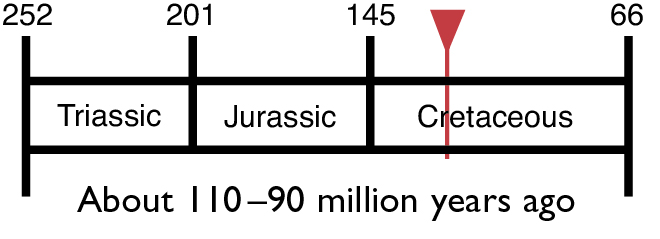



FUN FACTS: Old pictures of Spinosaurus showed it incorrectly with a Tyrannosaurus-like skull.
LOCATION: Egypt, Morocco
FOOD: Other dinosaurs, large fish
SIZE: Perhaps over 46 feet (14 m) long, 18.5 feet (5.6 m) high (including sail)
WEIGHT: Perhaps 8 tons
TRIVIA: Spinosaurus is not the only dinosaur with a sail. Ouranosaurus (a relative of Iguanodon) also had a sail. The sail-backed Dimetrodon of the Permian Period was not a dinosaur. It was, in fact, a primitive synapsid (or protomammal), more closely related to the ancestors of mammals.


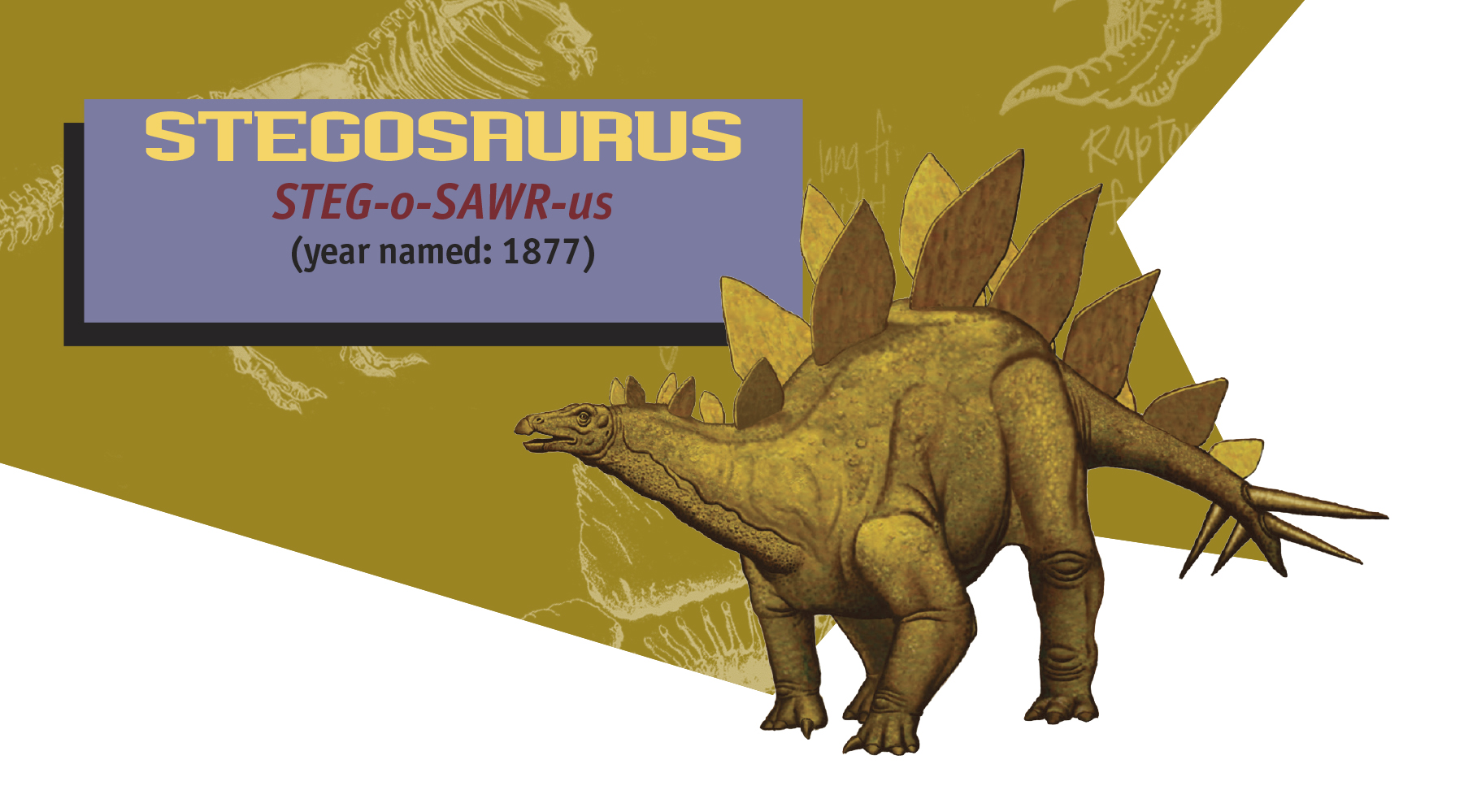

Stegosaurus (“roofed lizard”) is the best known “plated” dinosaur. It was a favorite food of Allosaurus and has been well studied by paleontologists for over 125 years. It has also been the subject of many false “dinosaur myths”—among them that it had a brain no bigger than a walnut (it was, in fact, more than twice as big as a walnut), a second brain in its hips, and plates that could flap on command.
Several questions about Stegosaurus have received a lot of study by scientists in the 1990s. It has been proposed at various times that Stegosaurus had either one or two rows of plates along its back. A specimen found by Ken Carpenter, Bryan Small, and a team at the Denver Museum of Natural History shows that Stegosaurus did have a double row of alternating plates down its back. This new specimen also shows that the tail spikes did not point upward—as in most museum exhibits—but instead pointed sideways.
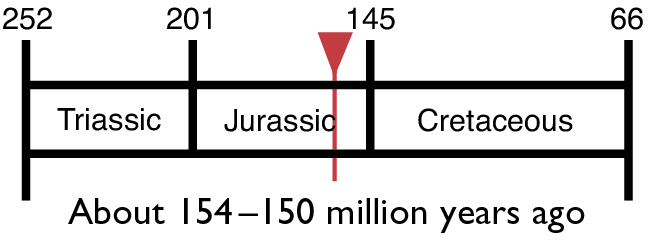

FUN FACTS: Almost everything in popular books during the 20th century about Stegosaurus was based on the specimen at the Smithsonian Institution.
LOCATION: Colorado, Wyoming, Utah
FOOD: Plants
SIZE: About 25 feet (7.5 m) long, 7 feet (2.1 m) high at the hips
WEIGHT: 3 tons
TRIVIA: Stegosaurus comes in two varieties: a large-plated species with four long tail spikes and a rarer, smaller-plated species with shorter tail spikes (possibly eight of them), based on a partial specimen. The second species may not be valid.




Suchomimus (“crocodile mimic”) is a spinosaur dinosaur, related to Baryonyx and Spinosaurus. Like them, it had a long, narrow snout packed with crocodile-like teeth and a huge thumb claw. Although it was larger than Baryonyx, it was smaller than the gigantic Spinosaurus.
Suchomimus was given the name “crocodile mimic” because, like a crocodile, its skull was long and slender and its teeth were shaped like cones (unlike many of the meat-eaters, which had blade-like teeth). Some paleontologists think that this means they ate mostly fish. It is true that Suchomimus lived near water, and that the remains of 10-foot (3-m) fish were found with it in the same rocks. This suggests that Suchomimus waded into the water and grabbed fish with its jaws, or hooked them with its thumb claw.
Today’s big crocodilians eat both large fish and land animals. Suchomimus, too, could have hunted the big land animals of its day—other dinosaurs. Its jaws could kill a dinosaur as easily as they could a fish.


FUN FACTS: Another dinosaur from the same rock formation as Suchomimus is the sail-backed Ouranosaurus, a relative of Iguanodon.
LOCATION: Niger, northern Africa
FOOD: Large fish, dinosaurs
SIZE: 36 feet (11 m) long, 12 feet (3.6 m) high at the hips
WEIGHT: 5 tons
FRIENDS: None
ENEMIES: Eocarcharia, Kryptops
TRIVIA: The thumb claw was one of the first bones found for both Baryonyx and Suchomimus.
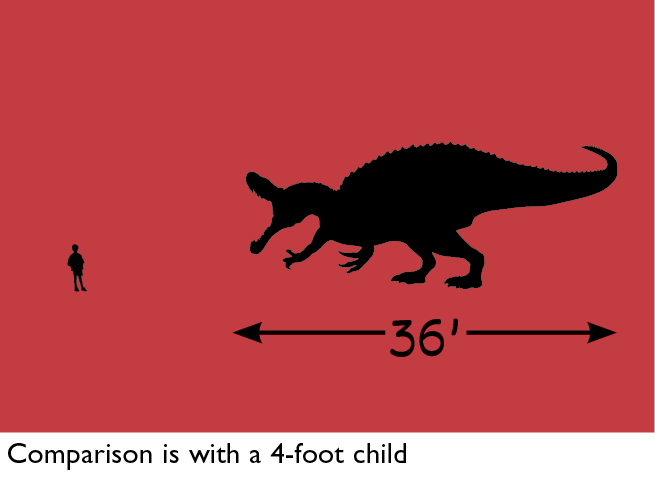



Therizinosaurus (“scythe lizard”) is enormous. It is also one of the most bizarre dinosaurs. Although it is a theropod (or meat-eating) dinosaur, it most likely ate just plants! It had gigantic claws, the largest over 28 inches (70 cm) long. But these claws were not curved and hooked like the claws of a predator. Instead, they were flat and straight.
Therizinosaurus was a giant relative of Beipiaosaurus. That earlier dinosaur was covered by protofeathers, a simple body covering that in some other dinosaurs (including oviraptorosaurs and birds) became true feathers. Because the earlier therizinosaur Beipiaosaurus had these protofeathers, paleontologists suspect that Therizinosaurus had them, too.
Therizinosaurus’s upper arm bone is almost 3 feet (.88 m) long. It may have been used to break branches off of trees.
It may seem strange to think of a plant-eater as a member of a group of meat-eating animals, but this is not the only case of that happening. For example, the modern giant panda eats almost nothing except bamboo, but it is a member of the carnivorous mammal group.
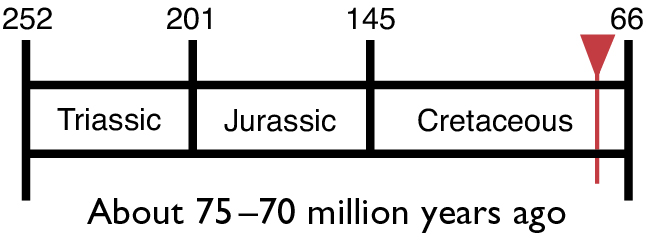

FUN FACTS: Therizinosaurus has the largest finger bones of any known animal in Earth’s history.
LOCATION: Mongolia
FOOD: Conifers, ginkgos, possibly flowering plants
SIZE: About 23 feet (7 m) long, over 10 feet (3 m) high at the hips
WEIGHT: 3 tons
FRIENDS: Saurolophus
ENEMIES: Tarbosaurus (a relative of Tyrannosaurus)
TRIVIA: When first discovered, paleontologists thought Therizinosaurus was some kind of giant turtle!
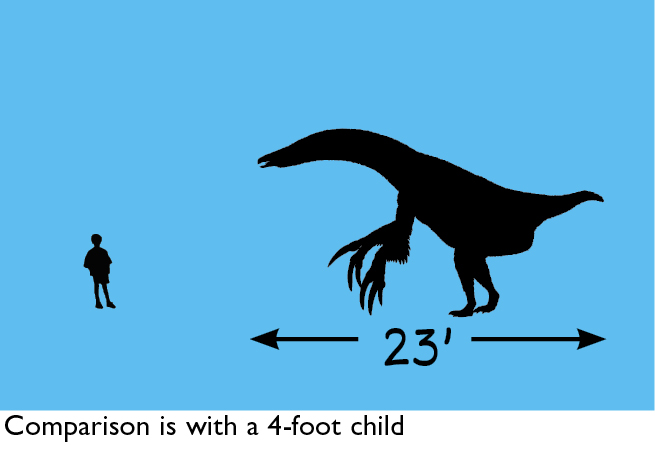



Thescelosaurus (“marvelous lizard”) was originally collected in Wyoming in 1891 by legendary field paleontologist John Bell Hatcher. He shipped it back to his employer, Professor Othniel C. Marsh, at Yale University. It stayed packed up and ignored until the turn of the century. It was then given to the Smithsonian Institution as a part of the Marsh Collection. And there it remained, still packed up, until 1913. When Charles Gilmore finally unpacked it, he immediately knew the specimen was a new dinosaur. He named it Thescelosaurus neglectus, or “marvelous but neglected lizard”!
Thescelosaurus is part of the ornithopod family Hypsilophodontidae. All its members have relatively small arms, well-muscled legs, and a stiffened tail. Most known specimens are from juveniles.
One rare adult Thescelosaurus specimen made worldwide headlines in 2000. It was sold by a commercial collector and nicknamed “Willo.”
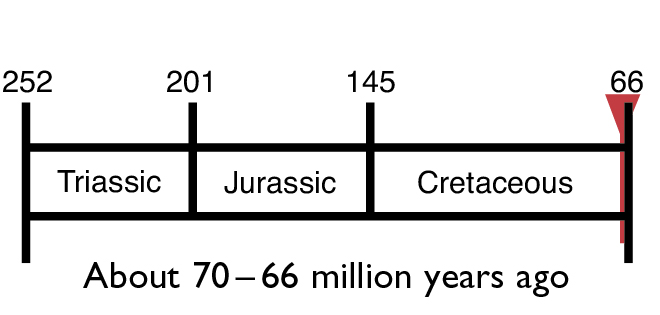

FUN FACTS: Skin samples (which are very rare!) have been found for this dinosaur.
LOCATION: Montana; Wyoming; South Dakota; Alberta and Saskatchewan, Canada
FOOD: Ground cover, such as cycads and flowering plants
SIZE: About 10 feet (over 3 m) long, about 3.5 feet (over 1 m) high at the hips
WEIGHT: 150 pounds (68 kg)
FRIENDS: Edmontosaurus, Pachycephalosaurus, Triceratops
ENEMIES: Ornithomimus, Troodon, Acheroraptor
TRIVIA: The original specimen was on display at the Smithsonian Institution in Washington, D.C.
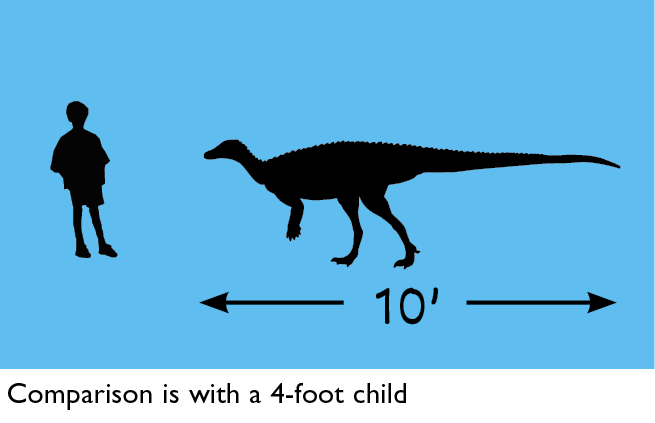



Torosaurus (“pierced lizard”) is one of the last of the ceratopsians, or horned dinosaurs. It is best known for one major feature: its frill, which is larger than its skull—which, at 10 feet (3 m), is one of the longest skulls of any land animal in Earth’s history! Torosaurus’s frill is so long that it severely restricted movement of the skull. The result is that Torosaurus would have had to move its whole body, and not just its head, when confronting an attacker. That is why its forelegs were so powerful and highly muscled. Its horns point up and out to the side—directly at the height of an adult Tyrannosaurus’s belly.
Torosaurus lived at the same time as Triceratops, but the Torosaurus population appears to have been much smaller. In Torosaurus, the frill is much longer and thinner than in Triceratops, and the frill has two fenestrae, or windows, that make it much lighter.
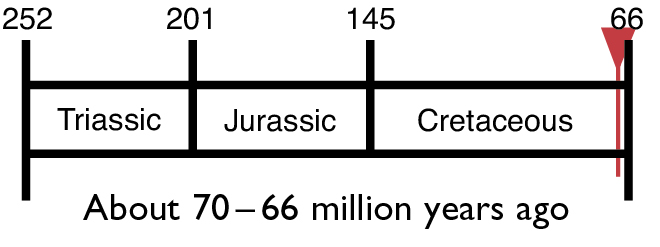

FUN FACTS: The frill is composed of the same kind of bone matter found in human skulls.
LOCATION: Wyoming; South Dakota; Colorado; Utah; New Mexico; Texas; Saskatchewan, Canada
FOOD: Conifers, cycads, ginkgos, flowering plants
SIZE: 36 feet (over 11 m) long, 7 feet (over 2 m) high at the hips
WEIGHT: 4 tons
TRIVIA: The original specimen was collected by John Bell Hatcher, who was nicknamed “the skull finder.” He is famous for finding over fifty Triceratops skulls in just two summers.
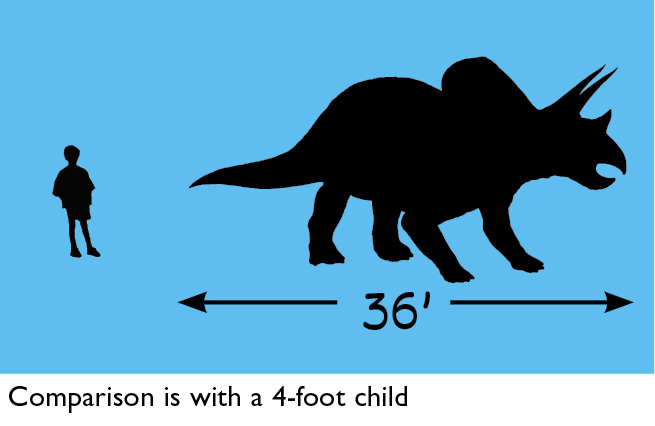



Torvosaurus (“savage lizard”) is a large meat-eating dinosaur. Its bones are very thick and sturdy, its arms are short but massive, and its thumb claws are huge. It lived in the same environment with several other giant meat-eaters (including Allosaurus and Ceratosaurus), but Torvosaurus was the “bruiser” of the bunch. While Allosaurus used its speed and agility to hunt, and Ceratosaurus used its oversized teeth, Torvosaurus seems to have relied on its brute strength.
Torvosaurus was first found by legendary fossil hunter “Dinosaur” Jim Jensen in the Morrison Formation of Colorado. This formation contains many kinds of plant-eating dinosaurs but is especially known for sauropods, or giant long-necks, like Apatosaurus, Brachiosaurus, and Camarasaurus, and stegosaurs like Stegosaurus. Torvosaurus might have been well suited for attacking young sauropods. It was probably not very fast, but neither were they.
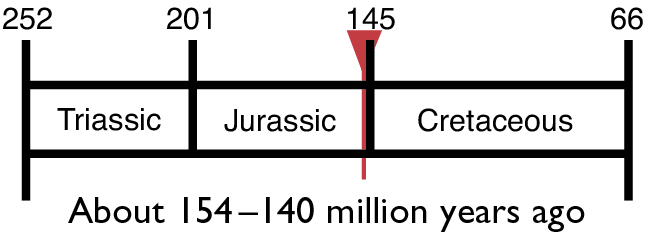

FUN FACTS: The strong arms of Torvosaurus are peculiar: The forearms are less than half the length of the upper arm!
LOCATION: Colorado, Wyoming, Utah, Portugal
FOOD: Sauropods, stegosaurs
SIZE: 33 feet (10 m) long, 8 feet (2.5 m) high at the hips
WEIGHT: 3 tons
TRIVIA: “Dinosaur” Jim Jensen found a giant specimen of Brachiosaurus (which he called “Ultrasaurus”) and a giant relative of Diplodocus (which he called “Supersaurus”) in the same quarry in which he discovered Torvosaurus.
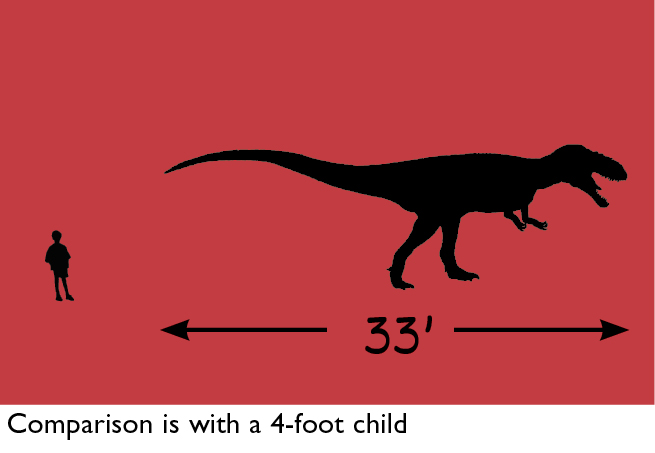



Triceratops (“three-horned face”) may hold the record for holding records! It has the largest skull (tied with Torosaurus at 10 feet/3 m) and longest hip bone (4 feet/1.2 m) of any dinosaur, the strongest jaw of any land-dwelling herbivore (or plant-eater) that’s ever lived, and the largest teeth of any herbivorous dinosaur. It was also the second most famous dinosaur, after Tyrannosaurus, for over a century; the first big dinosaur mounted at the Smithsonian Institution; and the first fully restored horned dinosaur (family Ceratopsidae).
With its parrot-like beak, self-sharpening and ever-replacing teeth, massive jaw muscles, 3-foot (1 m) horns, and body more powerful than a rhino, Triceratops was the only dinosaur that could (and sometimes did) outfight a T. rex!
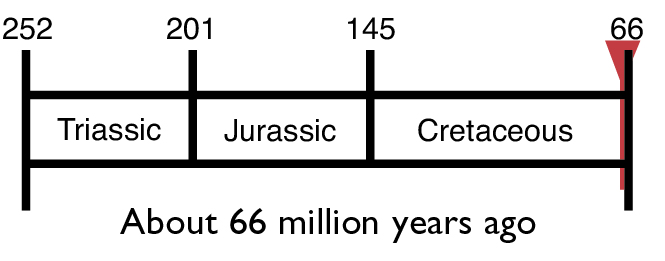

FUN FACTS: One scientist assumed the first Triceratops specimen belonged to a bison.
LOCATION: Montana, Wyoming, Colorado, South Dakota, Canada
FOOD: Plants
SIZE: Over 33 feet (over 10 m) long, 7 feet (over 2 m) high at the hips
WEIGHT: 5 tons
TRIVIA: In 1999, Triceratops became the world’s first fully “digital dinosaur.” The Smithsonian’s complete mounted skeleton—as well as each individual bone—was scanned into a computer and made available on their website, where you can move its individual bones. (See website)




Troodon (“wounding tooth”) is a small bird-like theropod. It has very long legs with specialized feet, in which the middle long bone was pinched out at the top to form a shock-absorbing wedge. This allowed it to run very fast. Troodon had very large eyes that faced mostly forward, so that it could focus better. It is famous for having one of the largest brains (for its body size) of any dinosaur.
Troodon had a jaw full of many small teeth, but they were not like the teeth of typical meat-eaters. Instead of little serrations running up and down the back of the teeth (as in most meat-eaters), there were much bigger bumps running along the side, as in many plant-eating dinosaurs and lizards. Some paleontologists speculate that Troodon may have eaten not only small mammals, lizards, and baby dinosaurs, but also insects, eggs, and even plants.
Paleontologist Dave Varricchio discovered the first Troodon nests. Like oviraptorosaurs and ground-dwelling birds, Troodon would make a nest on the ground. It would then curl up on top of the nest to brood its eggs.
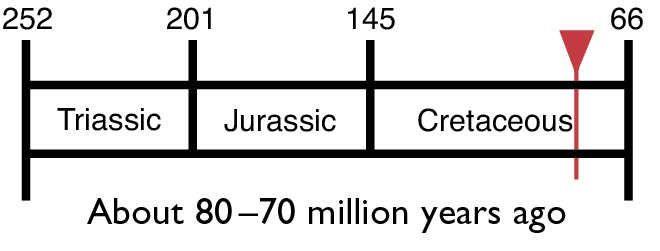

FUN FACTS: When the first Troodon tooth was found, paleontologists thought it was from a lizard!
LOCATION: Montana; Wyoming; Alberta, Canada
FOOD: Possibly small mammals and reptiles, baby dinosaurs, insects, plants
SIZE: 10 feet (3 m) long, 3.1 feet (94 cm) high at the hips
WEIGHT: 110 lbs (50 kg)
TRIVIA: Paleontologist Dale Russell once made a model of what he thought a modern, intelligent, tool-using descendant of Troodon would look like. He named this creature a “dinosauroid.”
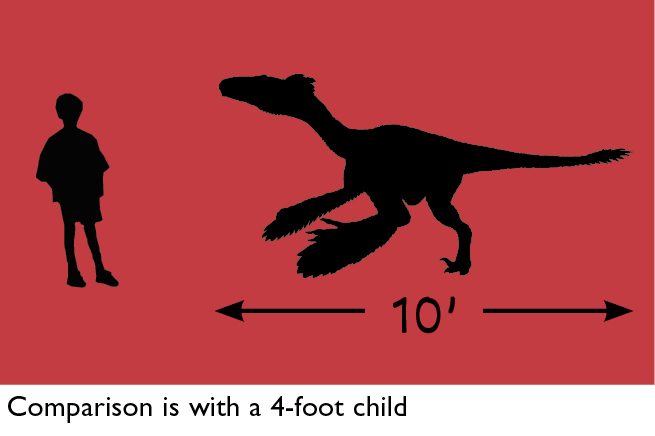



Tyrannosaurus (“tyrant lizard”) is one of the most well-known of all dinosaurs. It is no longer considered the largest of the theropods (see Giganotosaurus,), but it is certainly one of the fiercest and most powerful. Tyrannosaurus is the last and largest of the tyrannosaurs, or tyrant dinosaurs.
Like other tyrant dinosaurs, Tyrannosaurus has very short arms with only two fingers. Although these were probably useless while hunting, its jaws were not: Tyrannosaurus has an enormous skull armed with teeth the size of bananas! Unlike the teeth of most meat-eaters, tyrant dinosaur teeth are very thick and capable of crushing bones. The skull and neck bones show that T. rex had the largest neck muscles of any meat-eating dinosaur. It probably used its strong neck to twist and pull off big chunks of meat that it grasped with its jaws. Tyrannosaurus could bite with extremely strong force—one fossilized skeleton shows that it crushed and swallowed the bones of a smaller plant-eating dinosaur.
Most dinosaurs, in general, had eyes facing sideways, which allowed them to see all around themselves. The eyes of Tyrannosaurus, though, faced forward so it could focus better on a single object and tell precisely how far away it was. This would be very useful for a hunter—especially one that had to fight Triceratops, one of the most dangerous plant-eating dinosaurs of all.
The legs of the tyrant dinosaurs were long and slender for their size, allowing them to chase down the horned dinosaurs and duckbills that were the most common plant-eaters of their time. In fact, a specimen of the duckbill Edmontosaurus shows a bite mark taken out of its tail that matches the bite of Tyrannosaurus. Because this bite was healed, we know that the Edmontosaurus managed to get away from its attacker!
Although some people think that the female Tyrannosaurus was larger than the male, there is no real evidence for this. Indeed, paleontologists do not yet know how to tell a male Tyrannosaurus from a female from just the skeleton. It is known, though, that Tyrannosaurus led a rough life. Some specimens show many broken bones that had healed over.




FUN FACTS: A fossilized T. rex dropping was found in Saskatchewan, Canada, in 1995. It was filled with the broken and digested bones of a plant-eating dinosaur. The dropping was the size of a loaf of bread!
LOCATION: Montana; Wyoming; South Dakota; Colorado; Texas; New Mexico; Alberta and Saskatchewan, Canada
FOOD: Ankylosaurus, Edmontosaurus, Thescelosaurus, Triceratops
SIZE: 41 feet (12.5 m) long, 13 feet (3.9 m) high at the hips
WEIGHT: 7 tons
FRIENDS: None
ENEMIES: None
TRIVIA: Tyrannosaurus had the biggest brain of any dinosaur known.
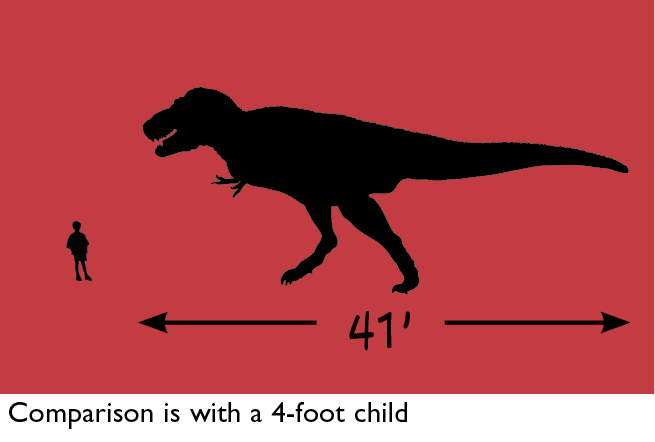



Velociraptor (“swift hunter”) is probably the most famous meat-eating dinosaur after Tyrannosaurus. Although it was first described in 1923, it was made famous to most people by its starring role in Jurassic World and Jurassic Park.
Velociraptor is one of the dromaeosaurs, or raptor dinosaurs. It is actually a pretty small, but fierce, dinosaur, with a skull only 7 inches (18 cm) long. Its arms are long and end in powerful grasping claws. Its feet have huge sickle-shaped claws, which could retract when not in use.
A spectacular fossil from Mongolia shows exactly how these claws were used. The fossil shows a Velociraptor and a little horned dinosaur—Protoceratops—locked in their final battle. The hands of the Velociraptor are clutching the skull of the Protoceratops, while the left foot claw of the raptor is buried deep in the horned dinosaur’s neck. The Velociraptor was apparently in the midst of ripping out the throat of the Protoceratops when the two were buried in a sand dune. (The little horned dinosaur seems to have had its revenge, however, as the Velociraptor’s right arm was in its beak. The Protoceratops no doubt bit it off with its final bite!)
Like all raptor dinosaurs, the real Velociraptor was covered with feathers. There are even bumps on its arms to show where big feathers were attached.


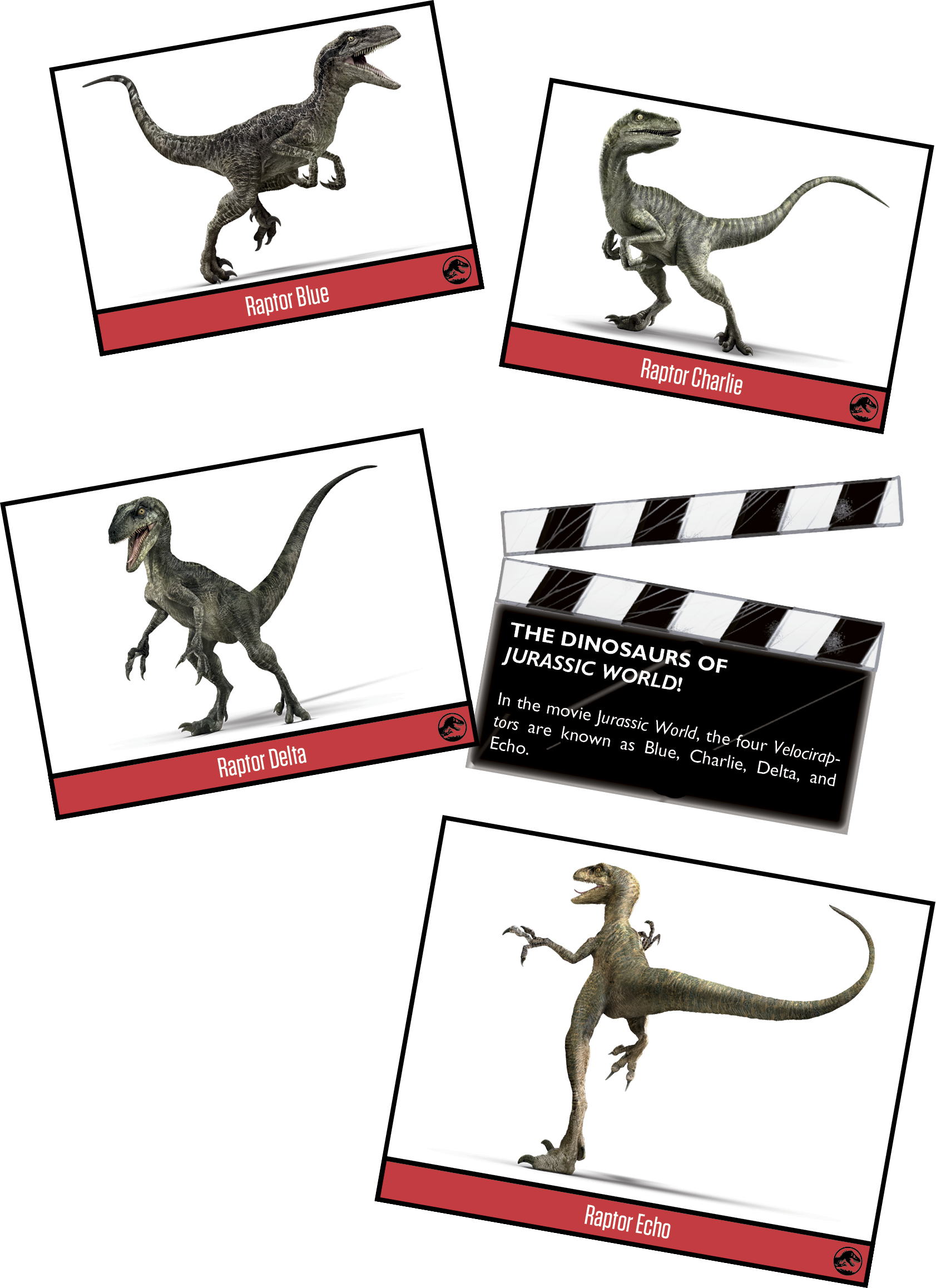

FUN FACTS: A fossil of Velociraptor has been found with a bite mark through the top of the skull. The bite matches that of another Velociraptor. This shows that Velociraptors killed each other.
LOCATION: Mongolia, China
FOOD: Protoceratops, Oviraptor, Shuvuuia, other dinosaurs
SIZE: About 6.6 feet (2 m) long, 1.5 feet (50 cm) high at the hips
WEIGHT: 33 lbs (15 kg)
TRIVIA: Velociraptors are known only from Asia!
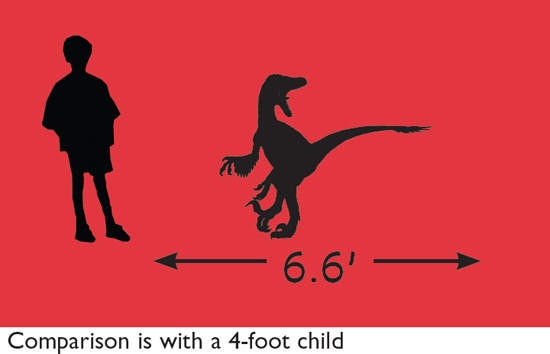



Wuerhosaurus (“lizard from Wuerho”) is a rare type of stegosaur from the Cretaceous Period. Well before the final extinction of the dinosaurs, stegosaurs became extinct and were replaced by ankylosaurs. The reason this occurred may be found by comparing their features. Although stegosaurs were well covered with plates on their backs and tails, their sides were less protected. Ankylosaurs were fully armored, and this may help explain why stegosaurs became extinct first. The presence of this stegosaur (Wuerhosaurus) in China—well into the Cretaceous—suggests that an isolated group survived in that area.
There are two major features that separate Wuerhosaurus from a typical Stegosaurus. Wuerhosaurus has a shorter body and a wide, flaring hip bone. In stegosaurs in general, the hip bone is so large that it grows up, outward, and over the thighbone.


FUN FACTS: Stegosaurs were probably the slowest of all dinosaurs. The thighbone is almost twice as long as the shin bone—the opposite of what you’d find in high-speed animals. In Wuerhosaurus, we see another dinosaur that gave up any chance at speed to put all of its effort into defense.
LOCATION: Mongolia, China
FOOD: Conifers, cycads, ginkgos
SIZE: 27 feet (8.1 m) long, 6 feet (1.8 m) high at the hips
WEIGHT: 4 tons
TRIVIA: Stegosaurs, in general, are one of the rarest of all the dinosaur groups because not many species evolved.




Zuniceratops (“Zuni horned face”) was the first ceratopsian, or horned dinosaur, to appear with horns over the eyes (an advanced feature) as well as several primitive features. It is older than all the classic horned dinosaurs of western North America, like Centrosaurus and Triceratops. So maybe long horns first appeared in North America? But science can be complicated: another dinosaur of just about the same age, Turanoceratops, is known from central Asia, and it also has eyebrow horns. Did these horns first appear in Asia and move to North America, or vice versa? We are still looking for the answer.
Zuniceratops also has single-rooted teeth. (All the later ceratopsians have double-rooted teeth.) This shows that in ceratopsians, the frill and horns evolved first, followed by changes in the teeth.
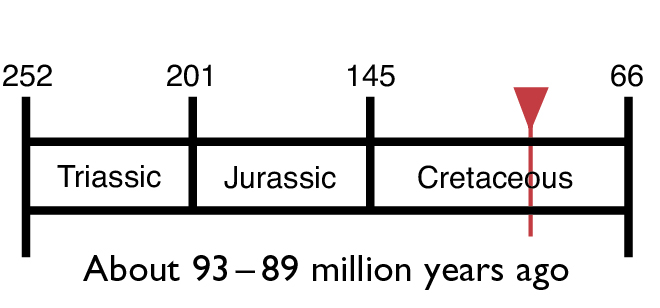

FUN FACTS: Zuniceratops is the only ceratopsian named after a Native American tribe.
LOCATION: New Mexico
FOOD: Ground cover of cycads, flowering plants
SIZE: 10 feet (3 m) long, 3.3 feet (about 1 m) high at the hips
WEIGHT: 100 pounds (45 kg)
FRIENDS: Hadrosaurs
ENEMIES: Dromaeosaurs
TRIVIA: Teeth of an even earlier ceratopsian, possibly related to Zuniceratops, were found in Maryland in 1991.

